London Museums. British Museum. British Museum.

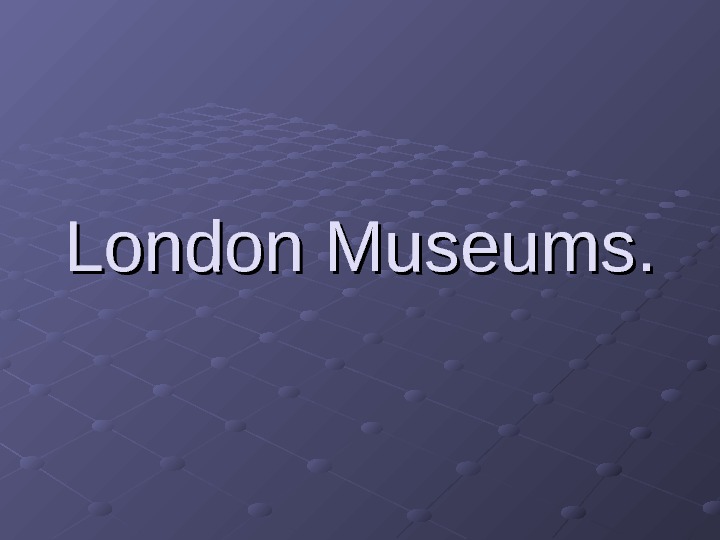
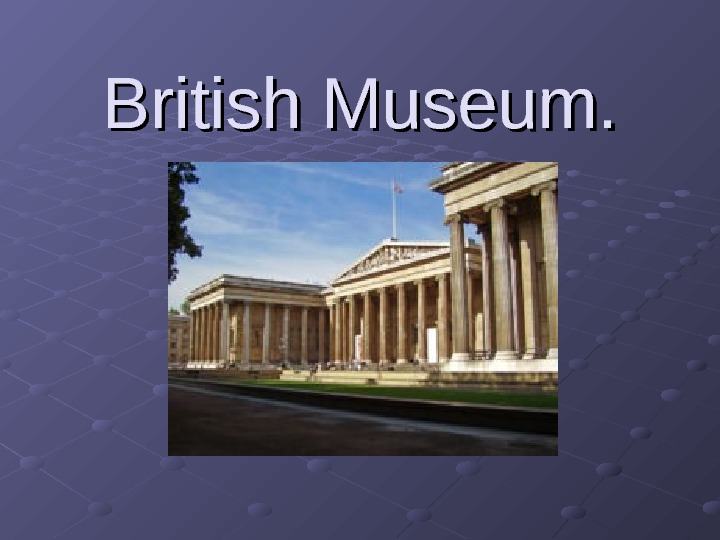
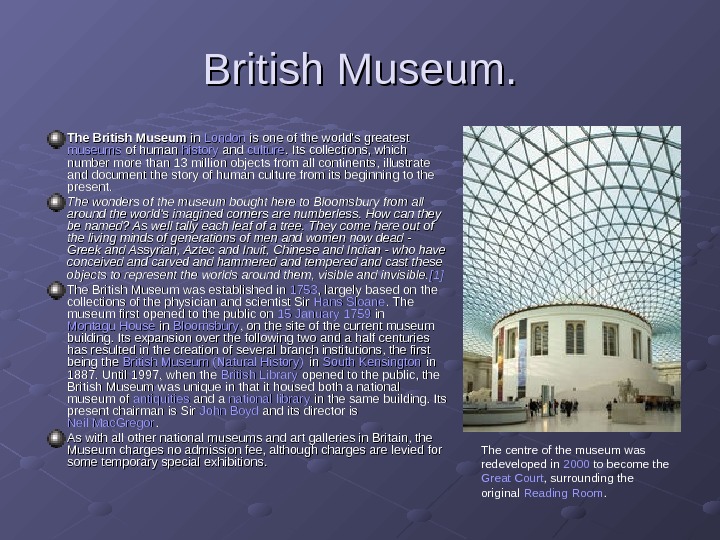
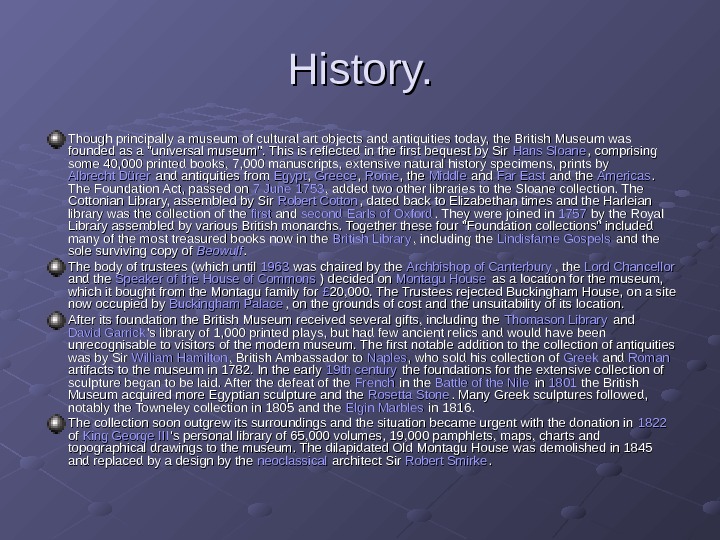
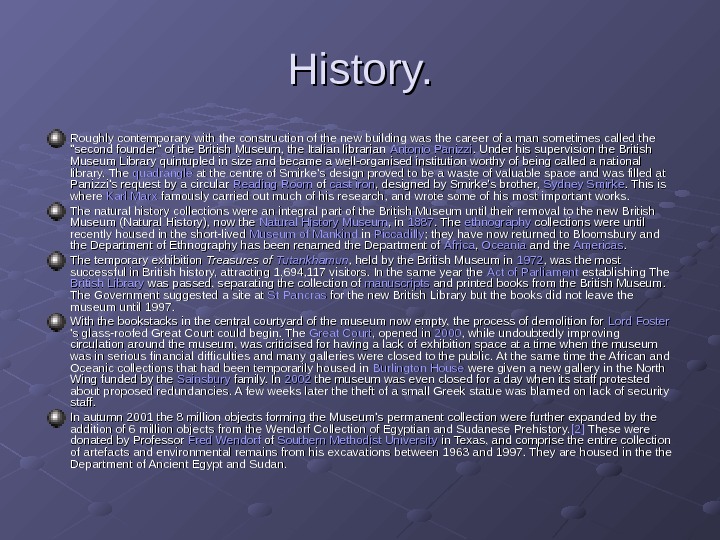
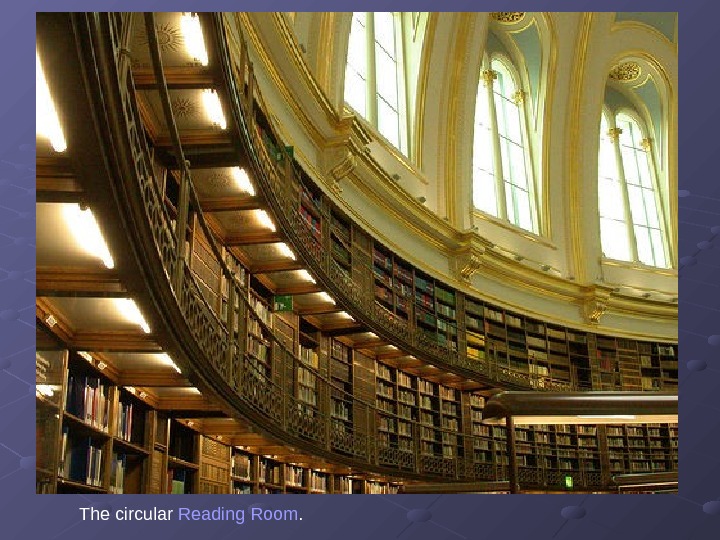
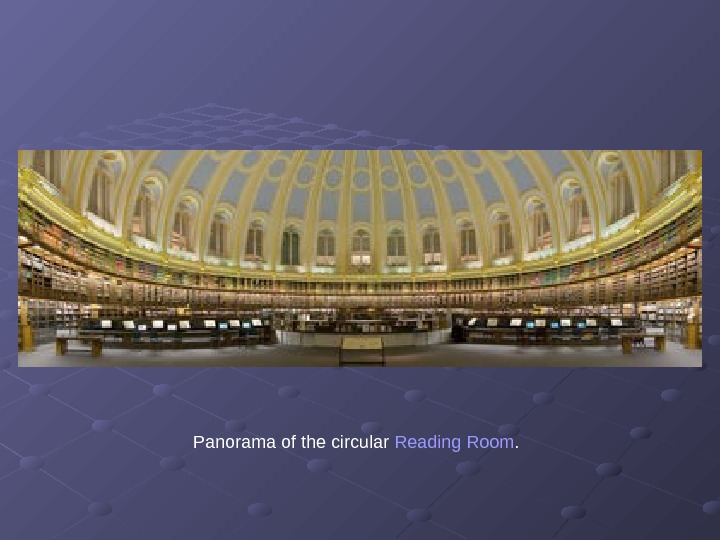
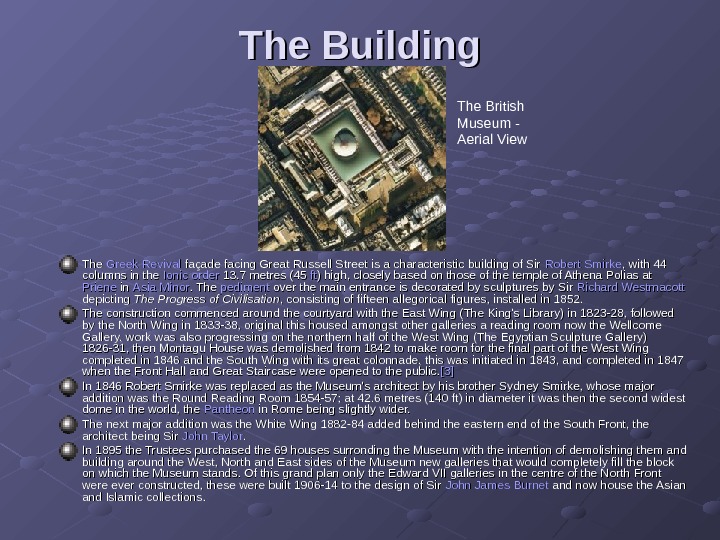
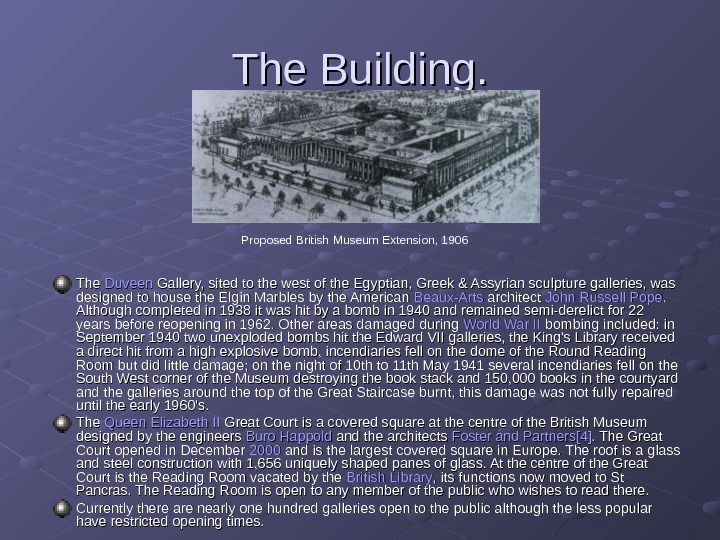
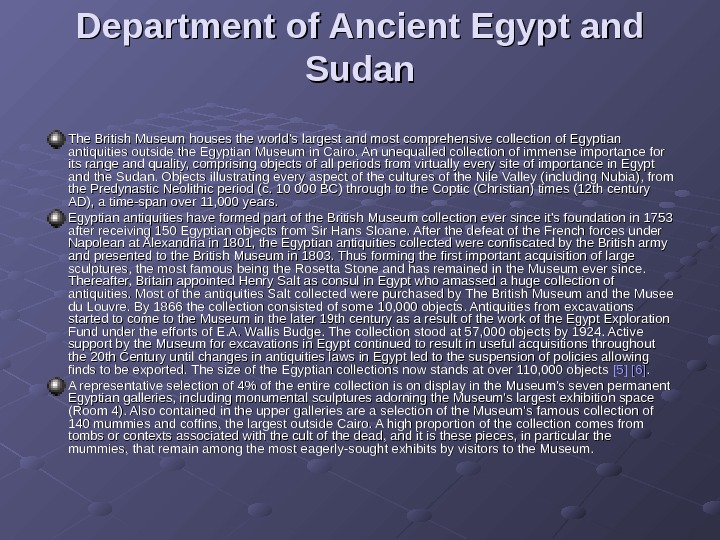
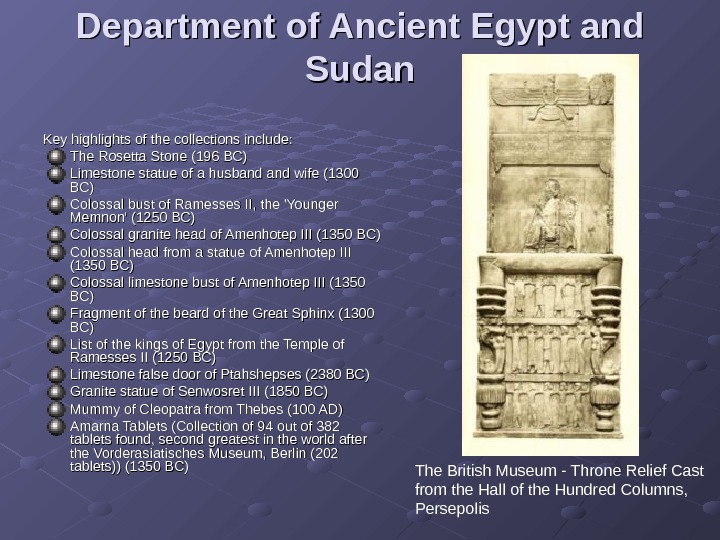
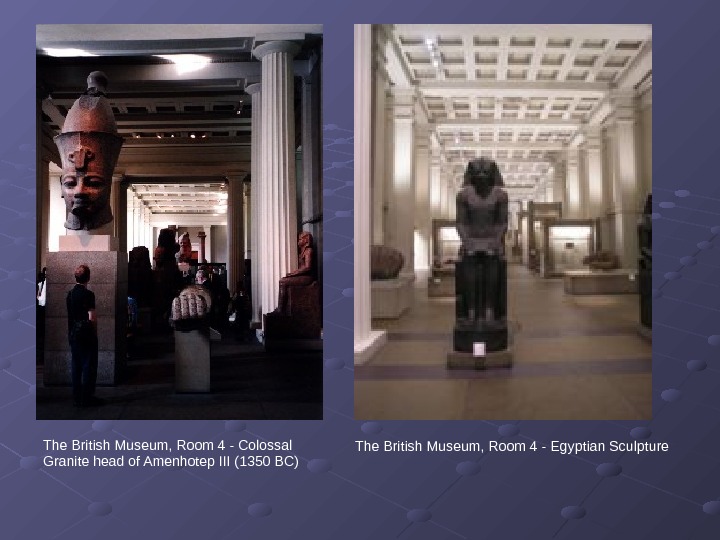
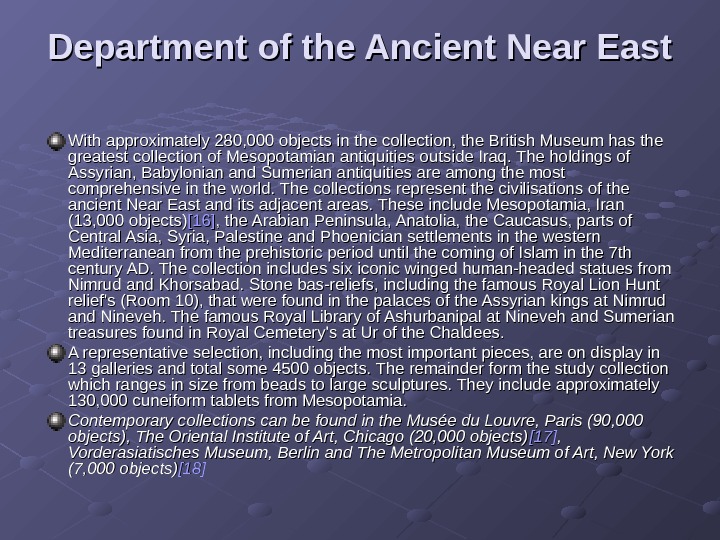
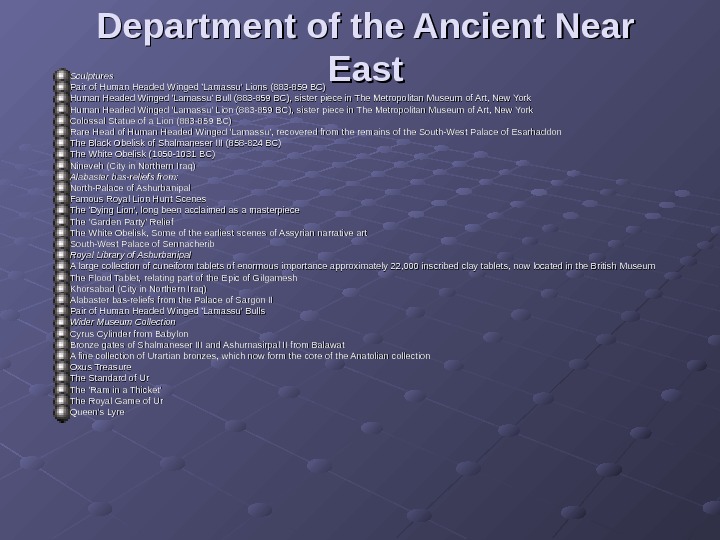
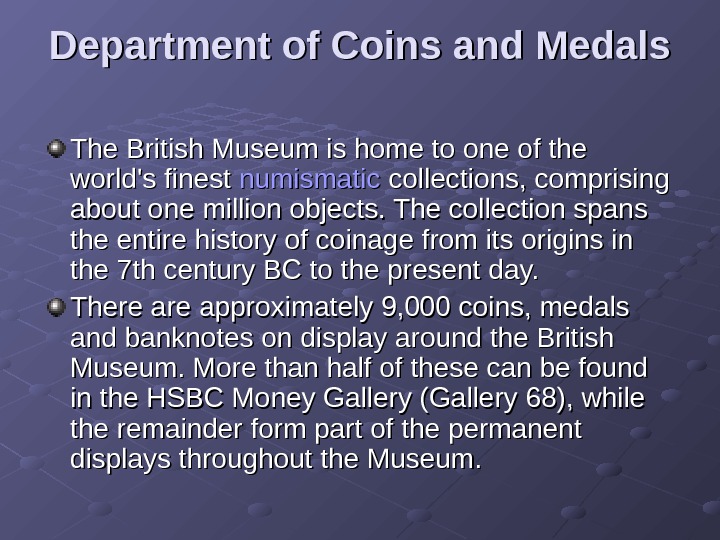
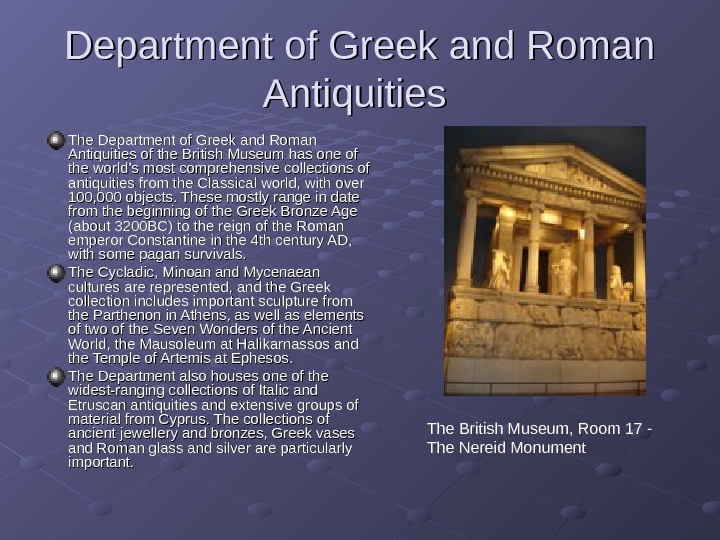
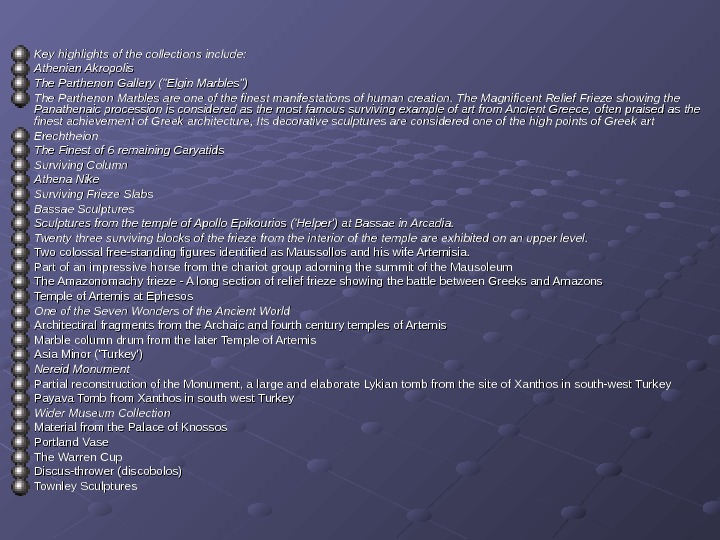
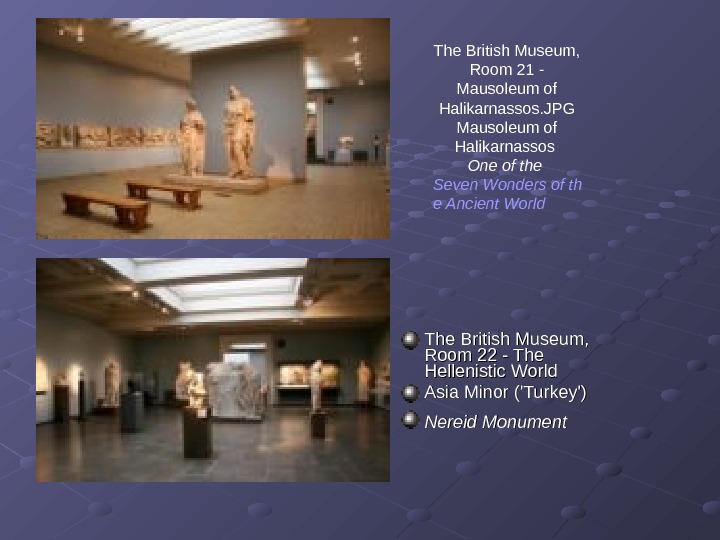
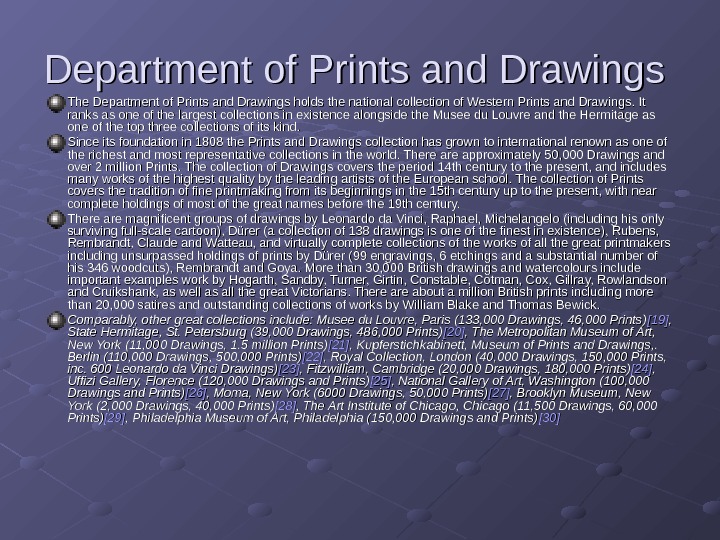
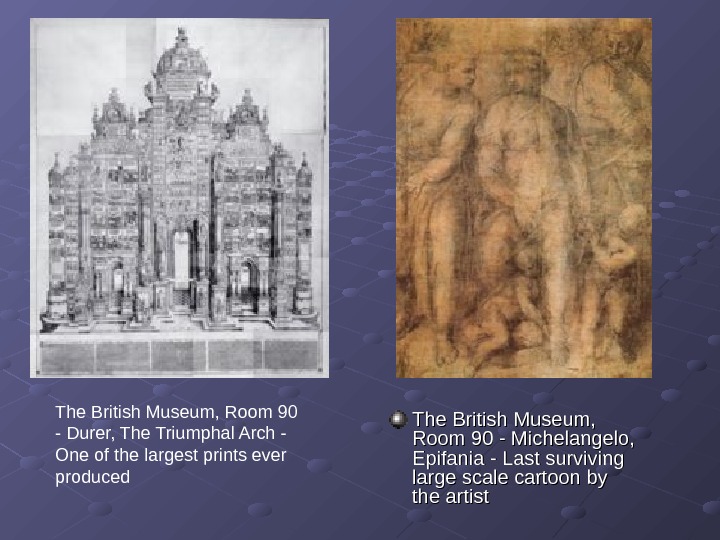
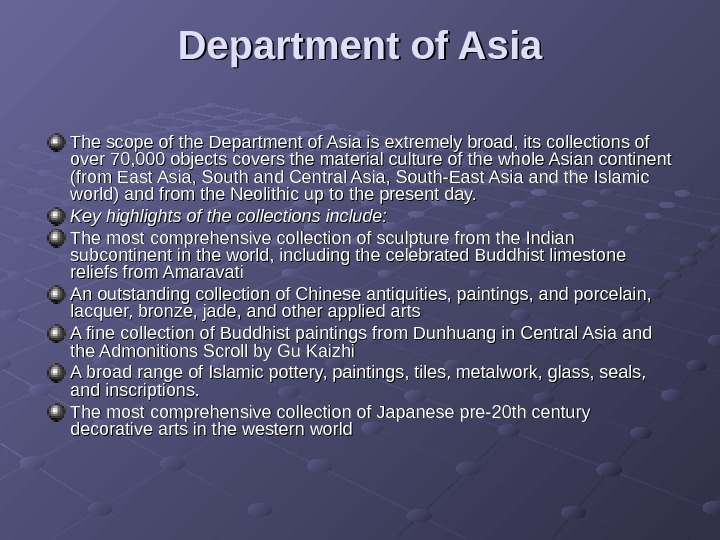
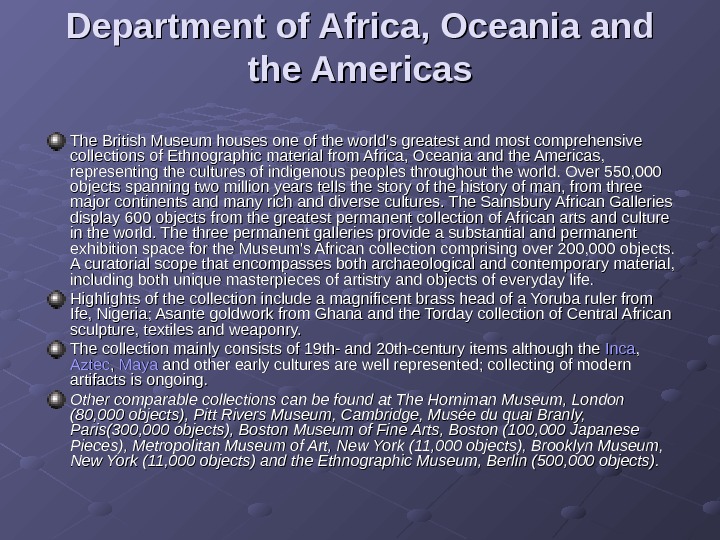
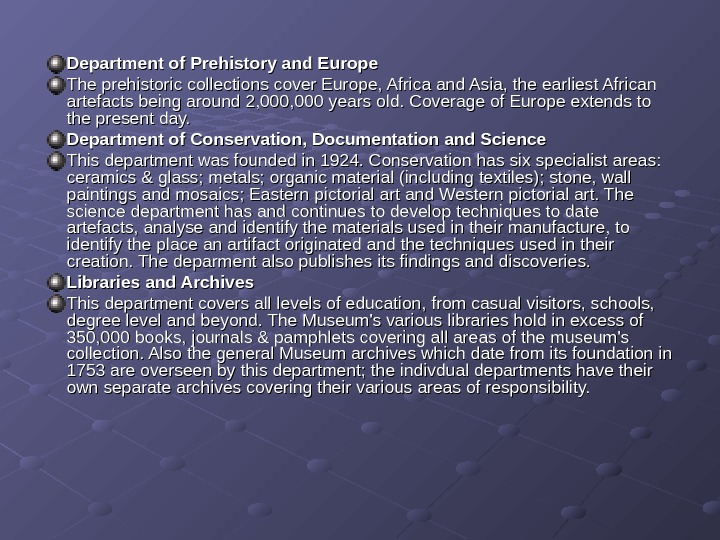
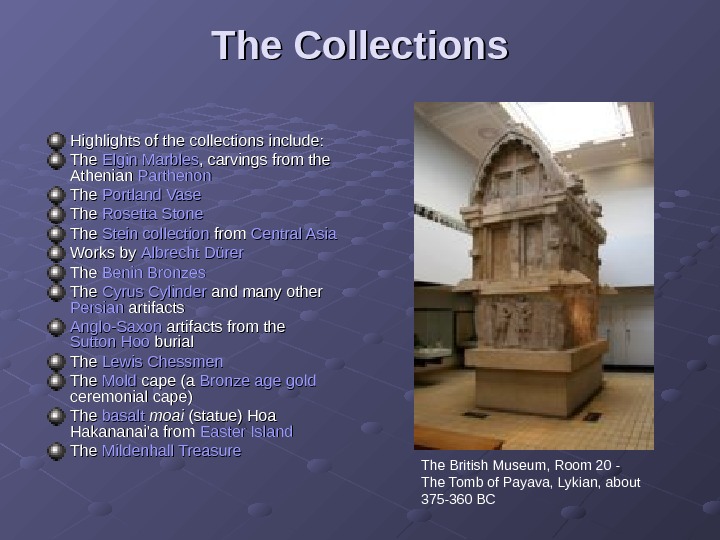
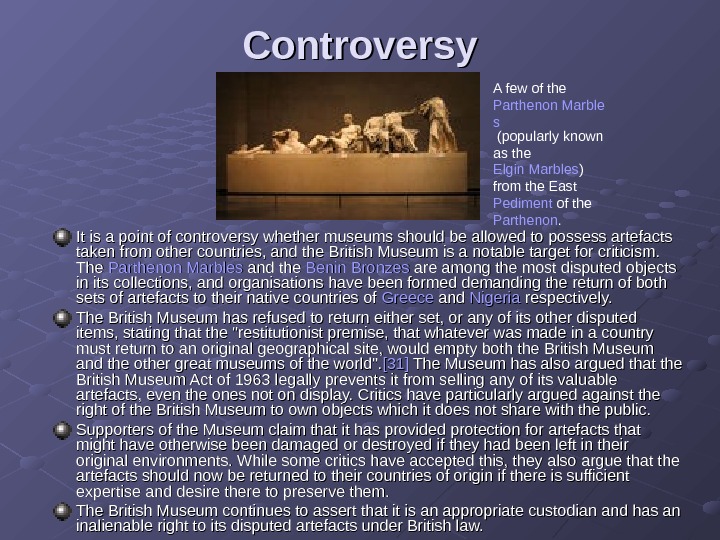
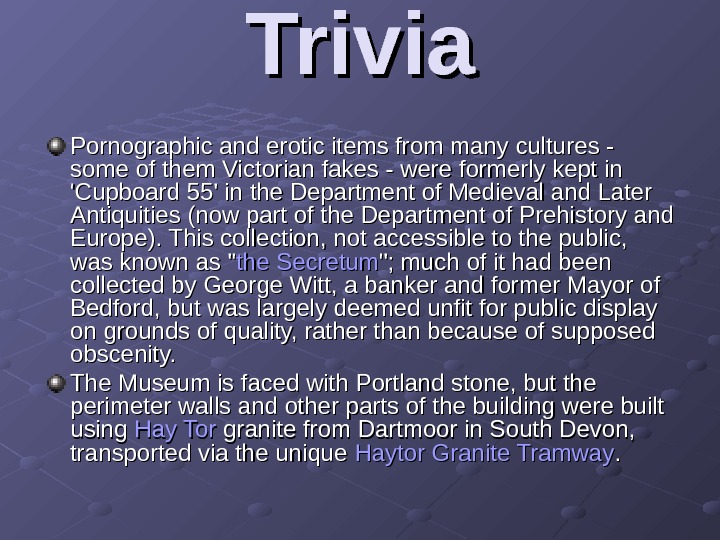

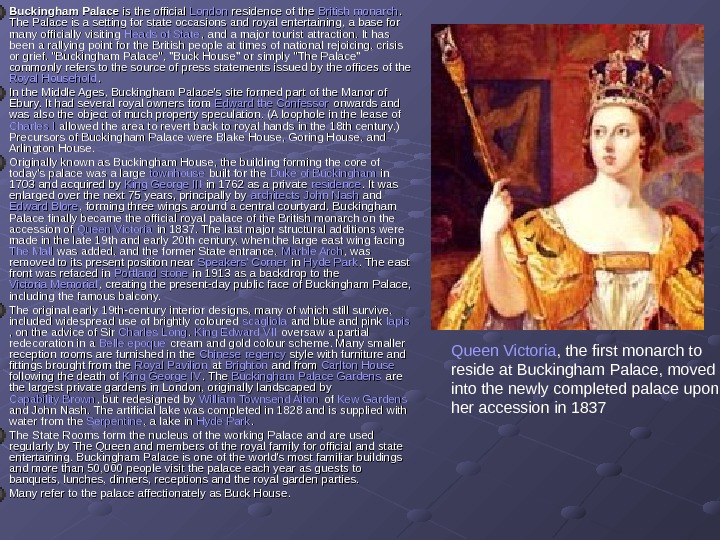
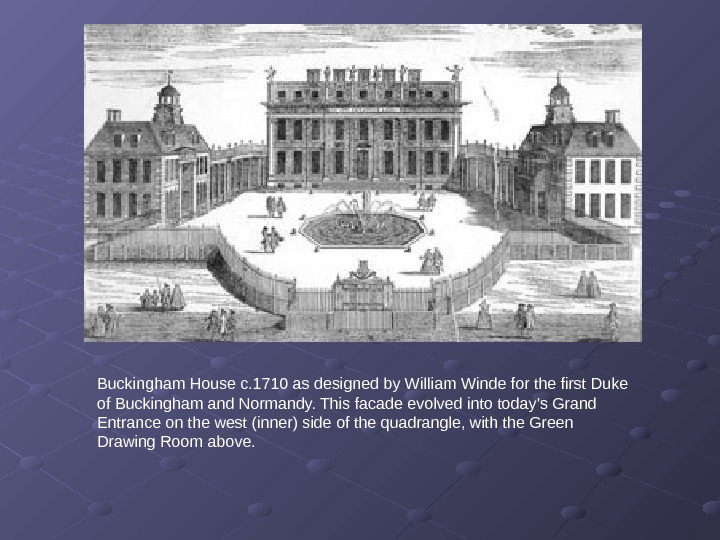
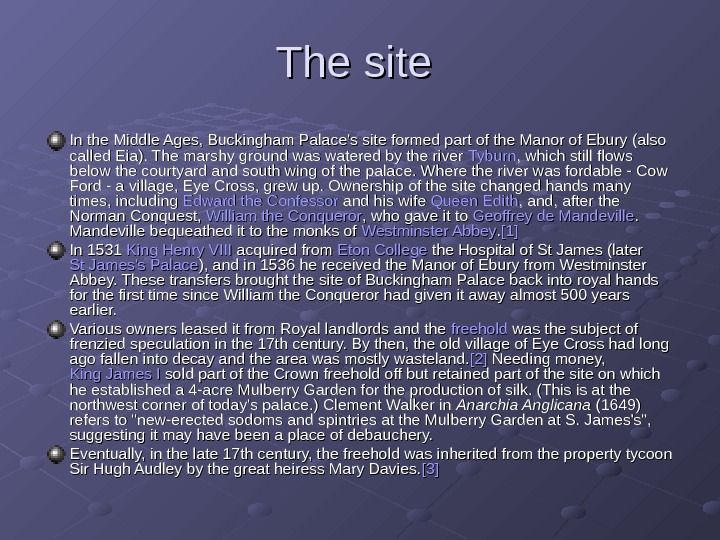
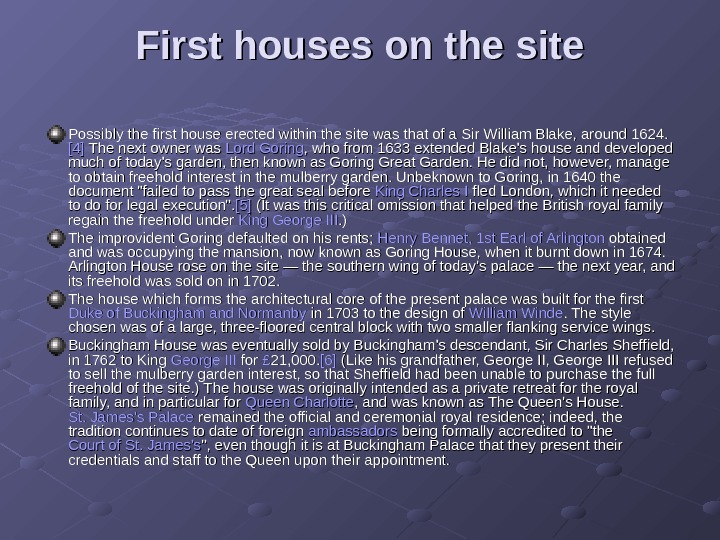
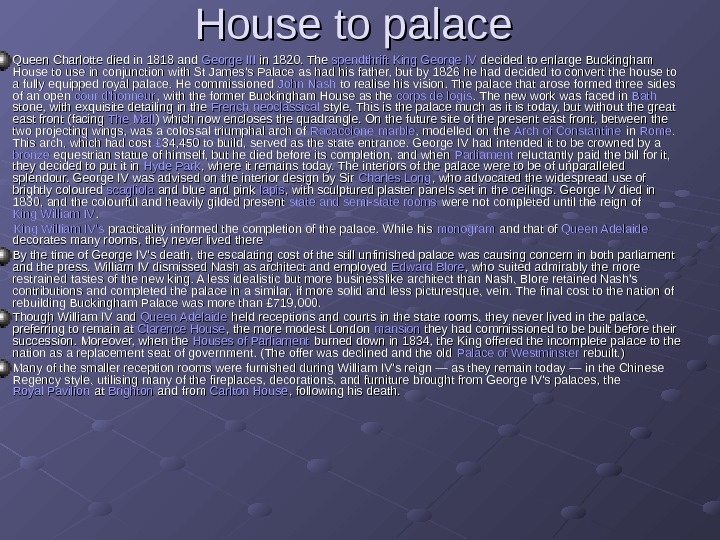
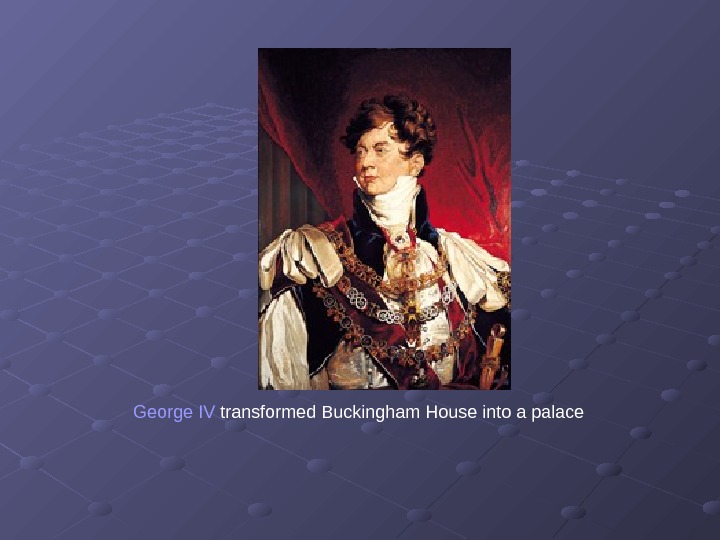
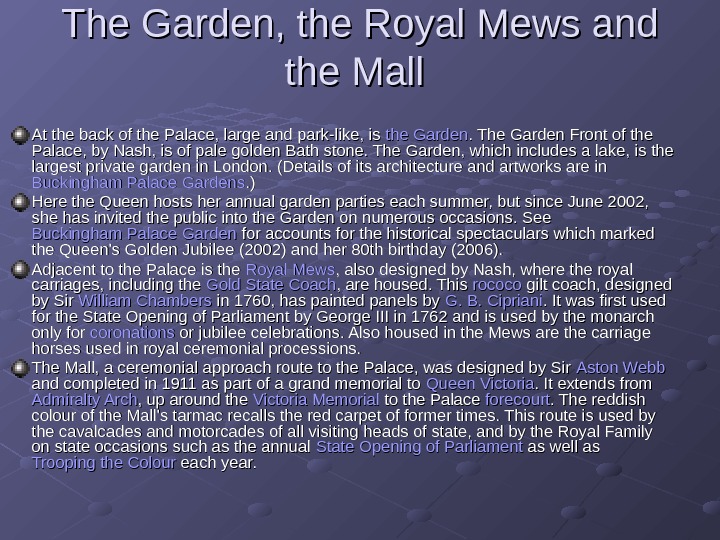
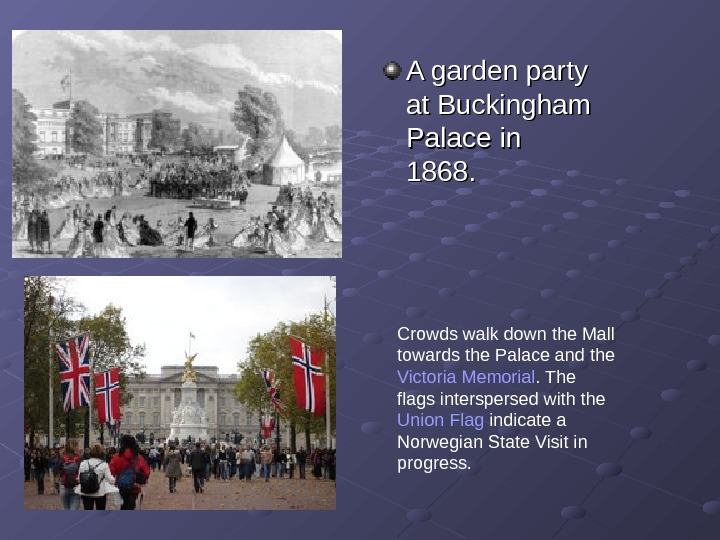
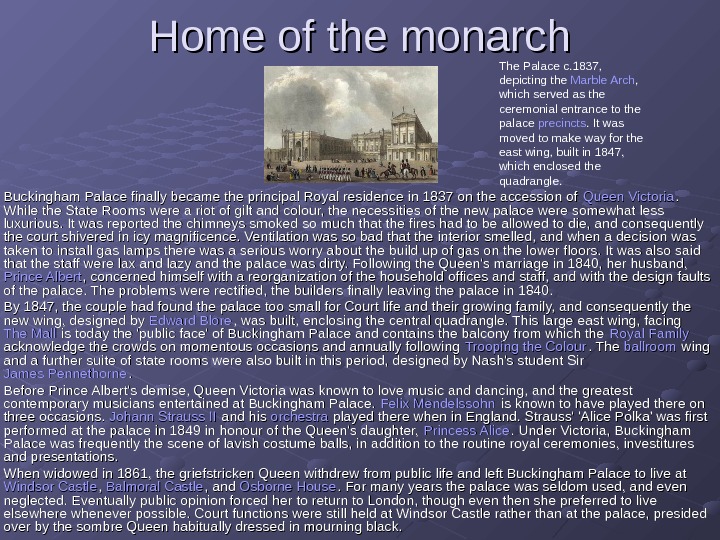
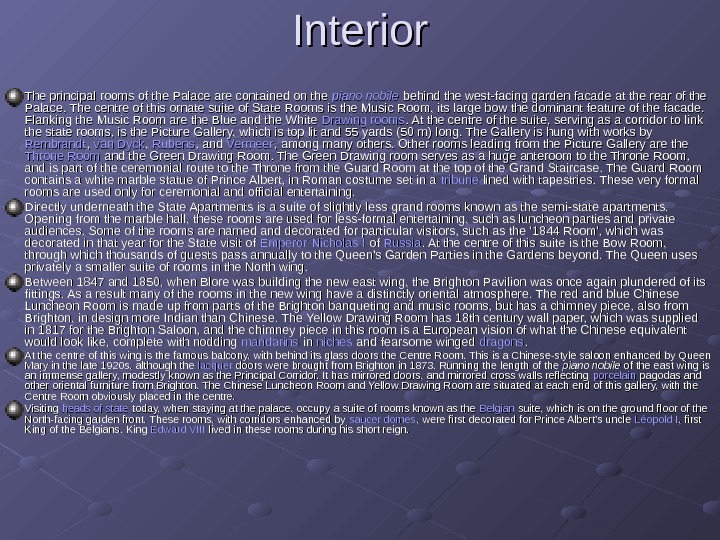
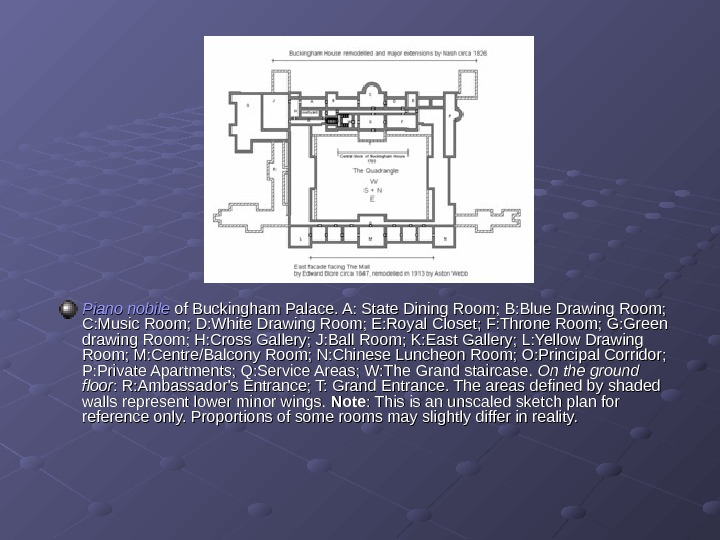
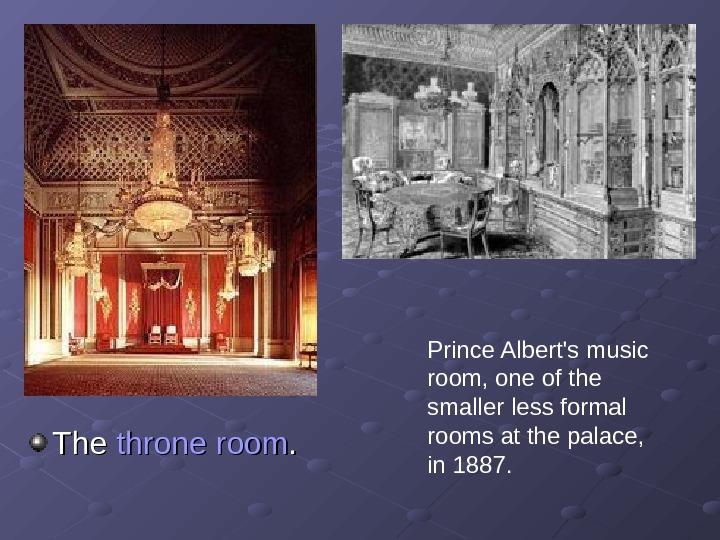
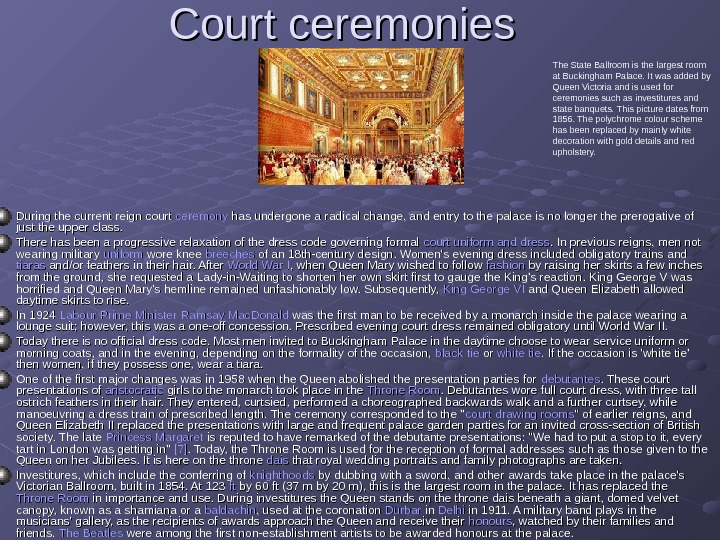
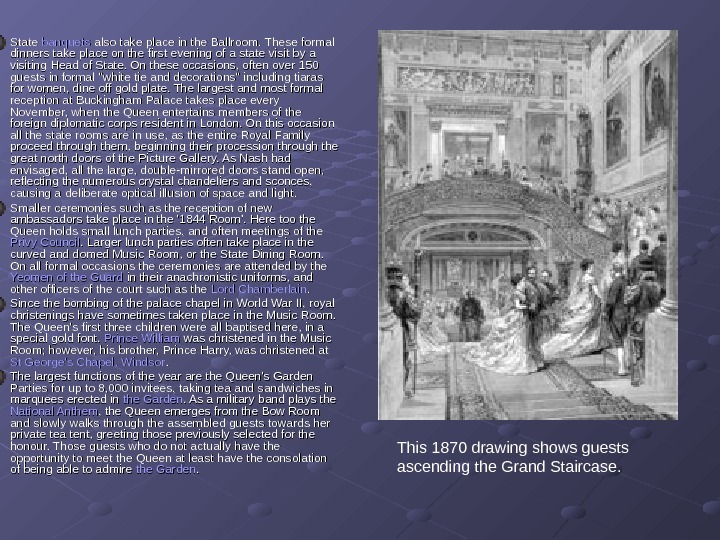
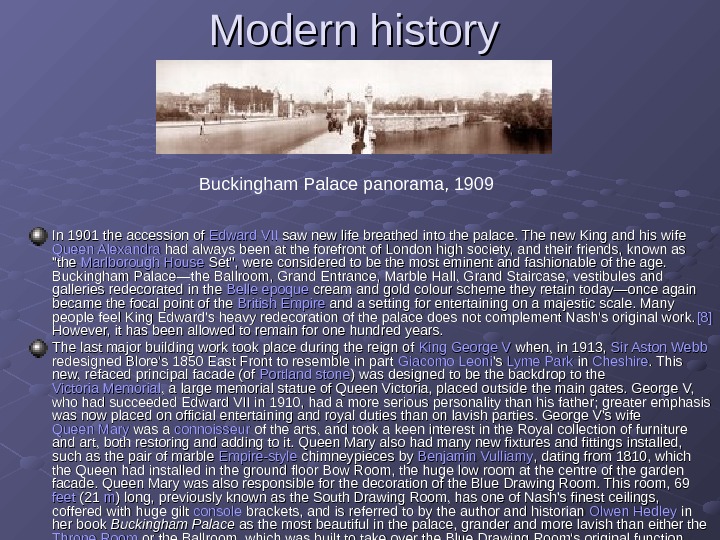
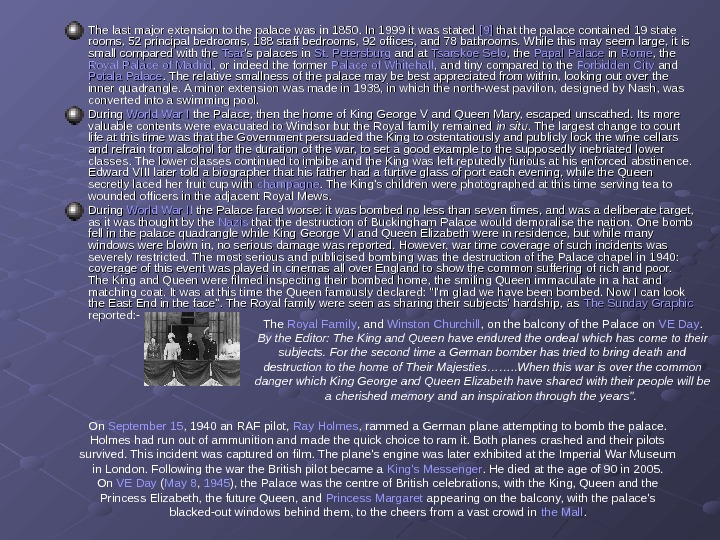
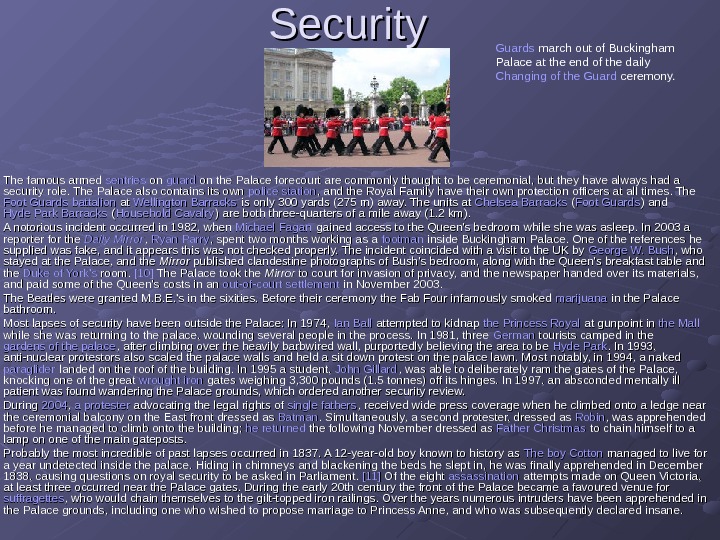
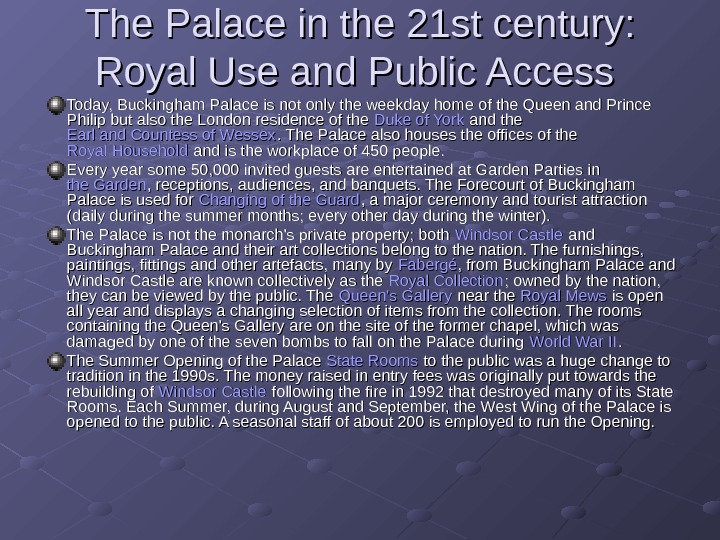
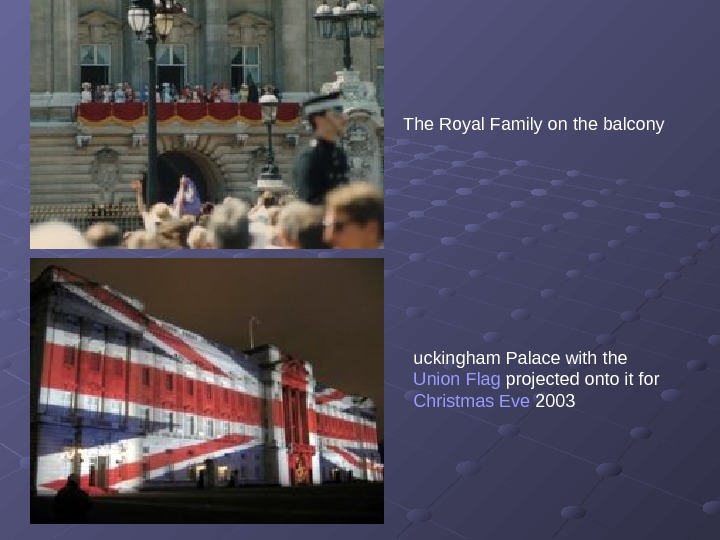
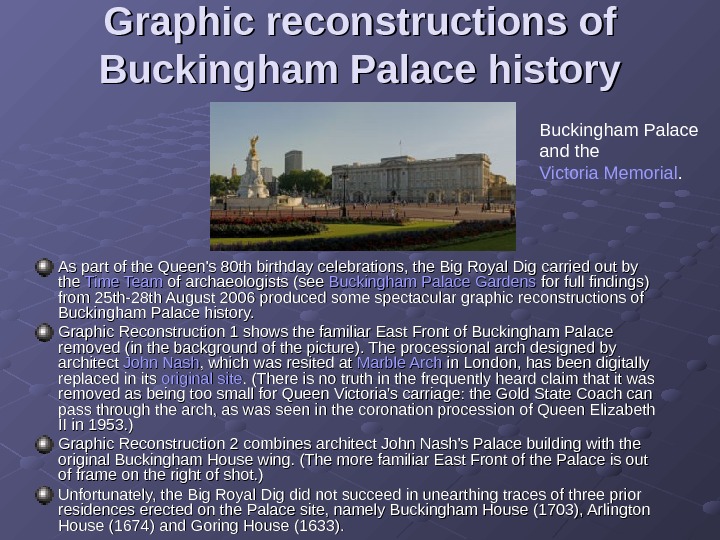
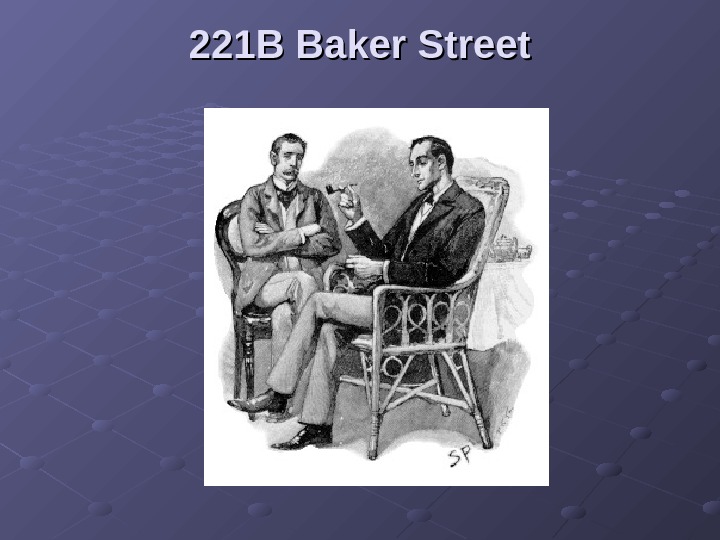
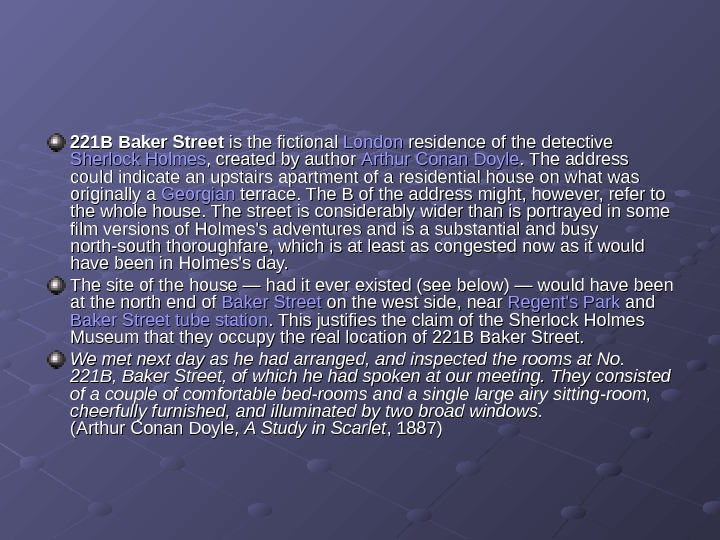
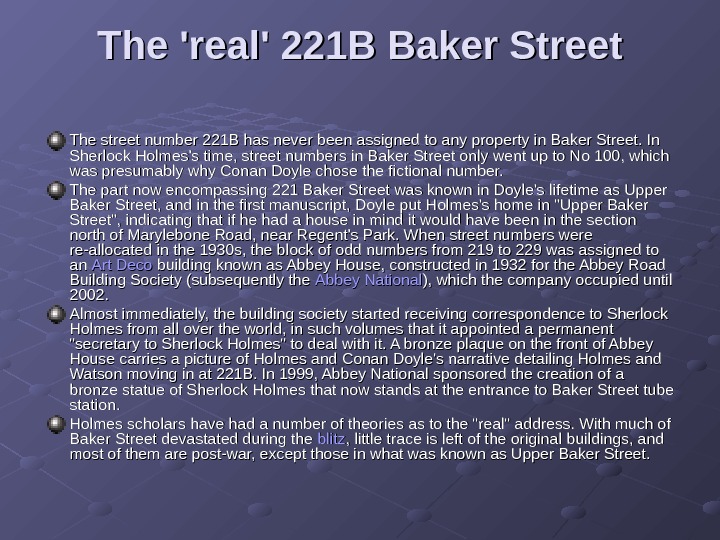
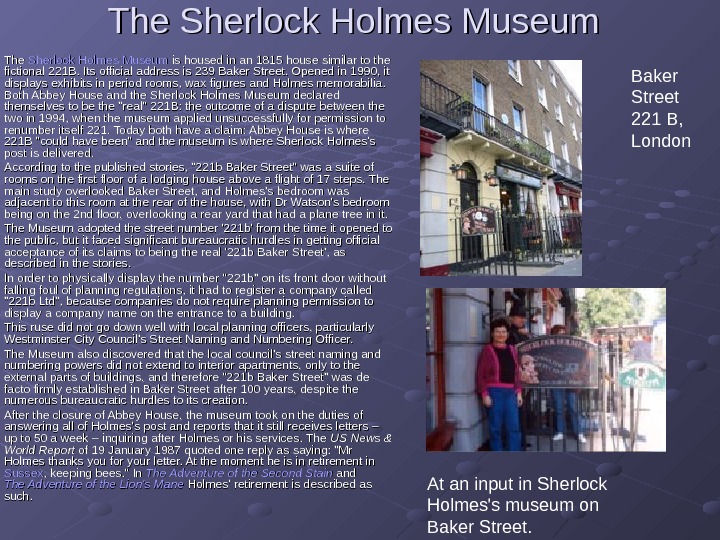
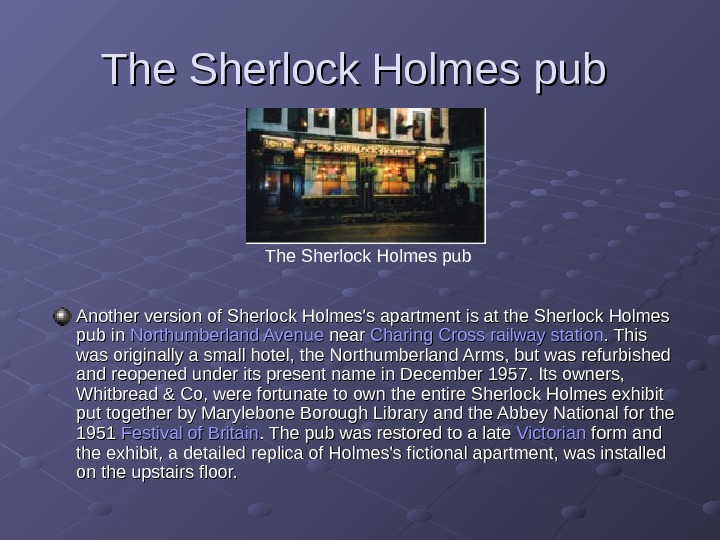
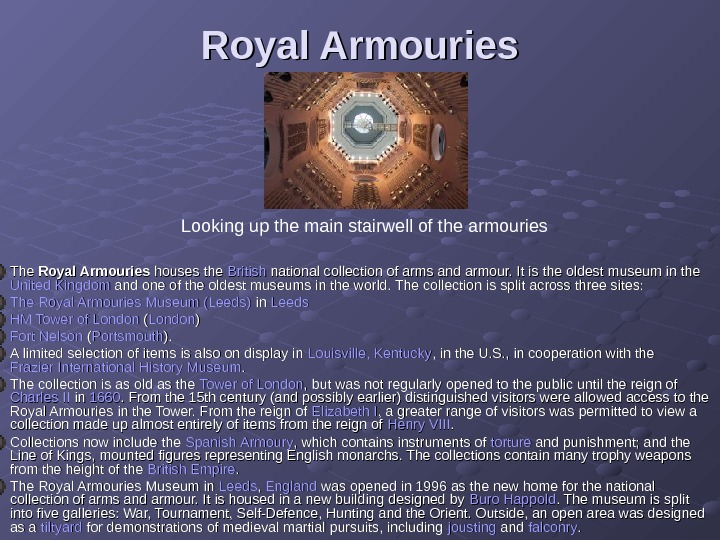
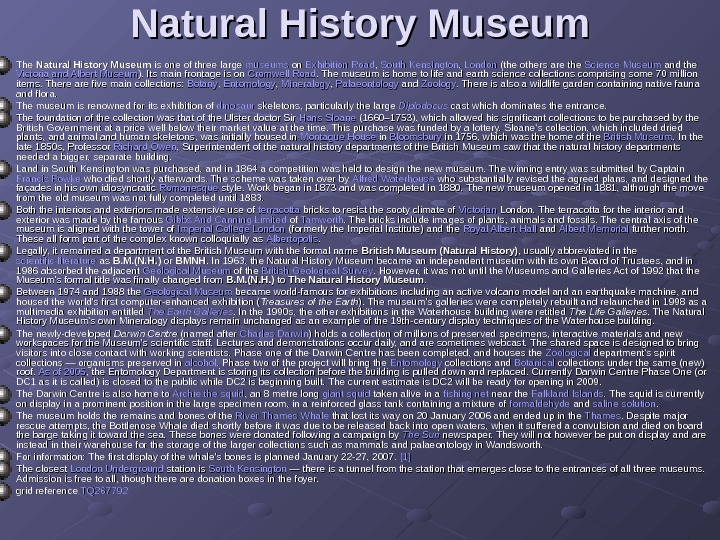
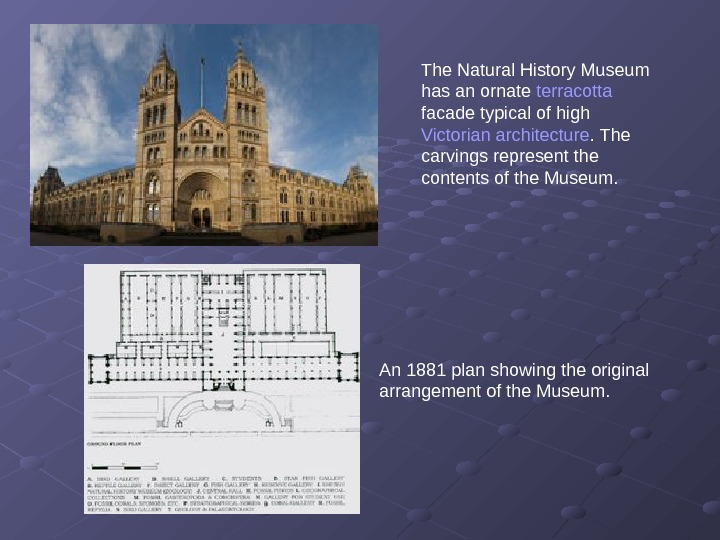
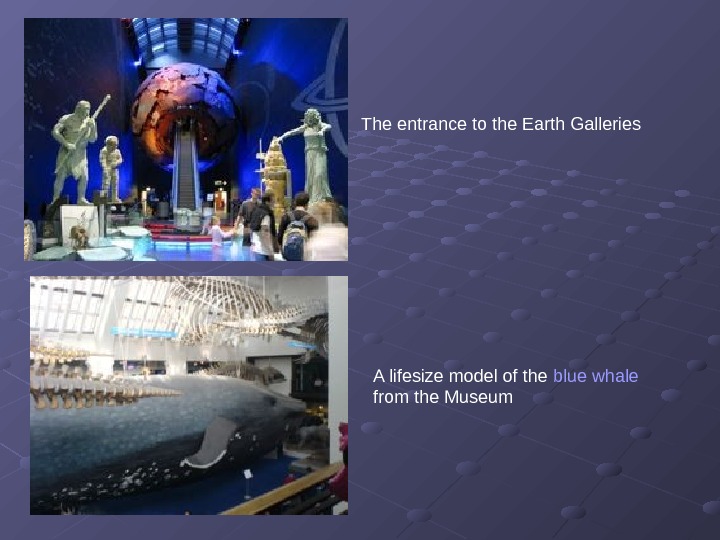
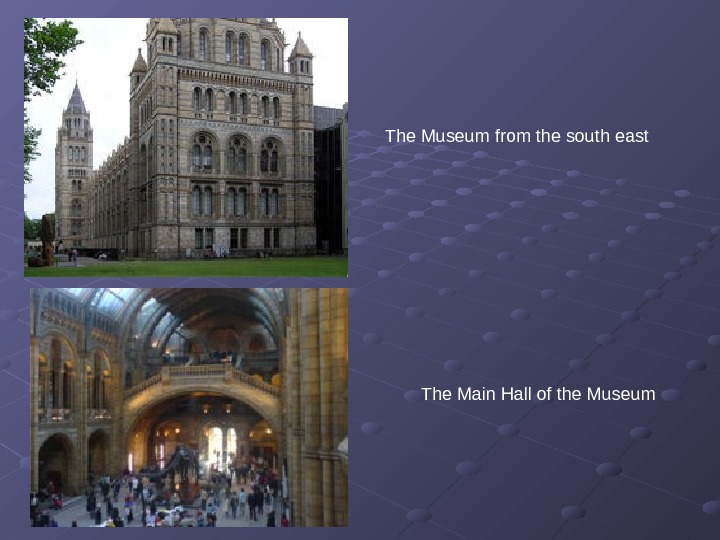

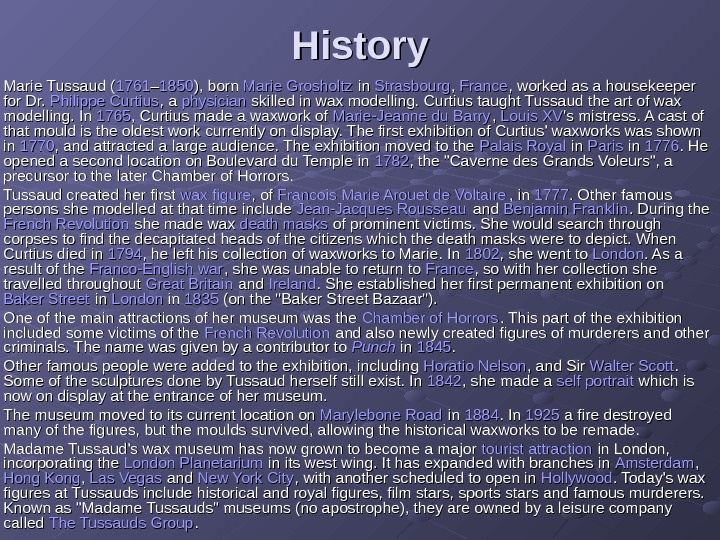
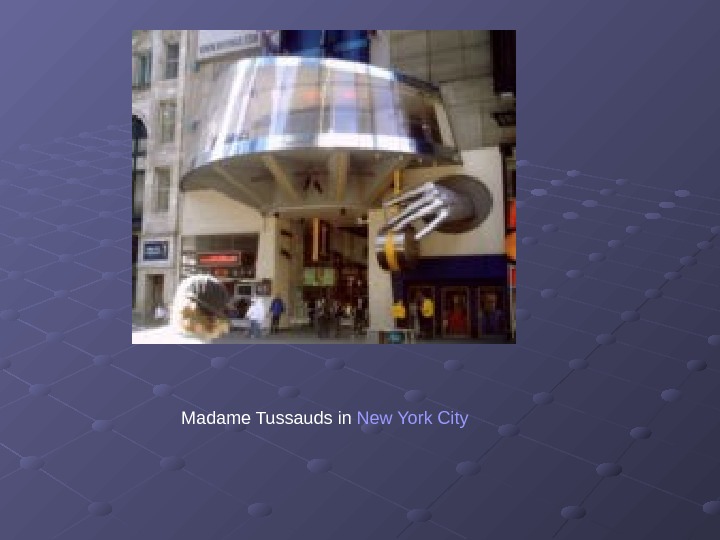
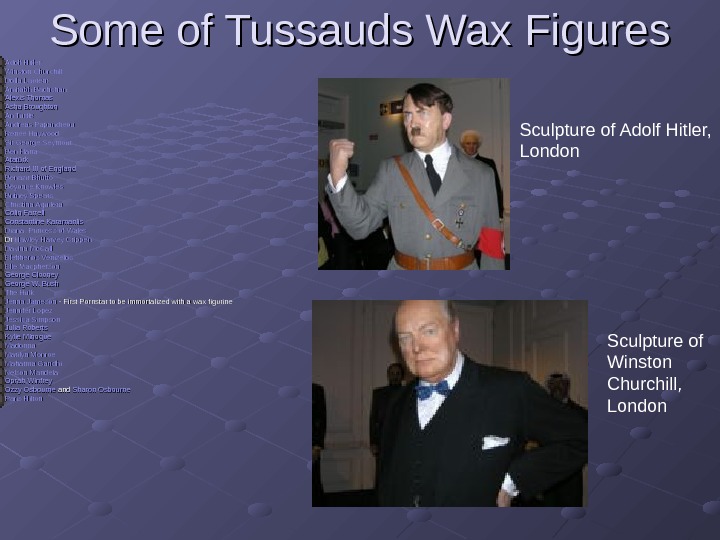
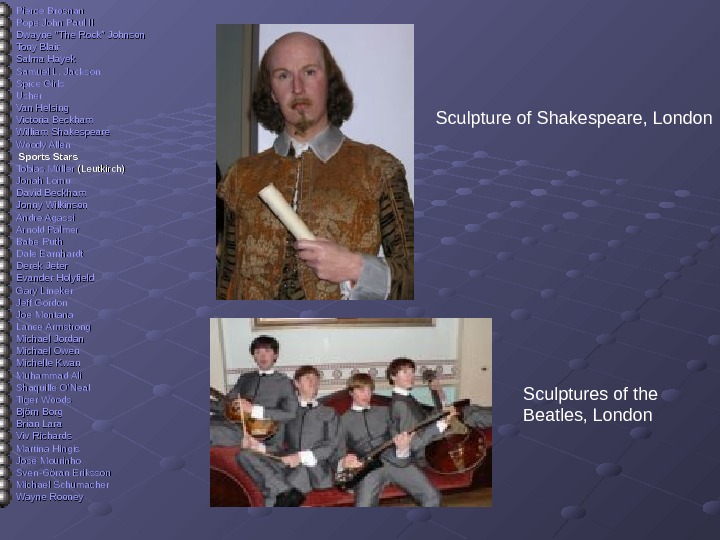
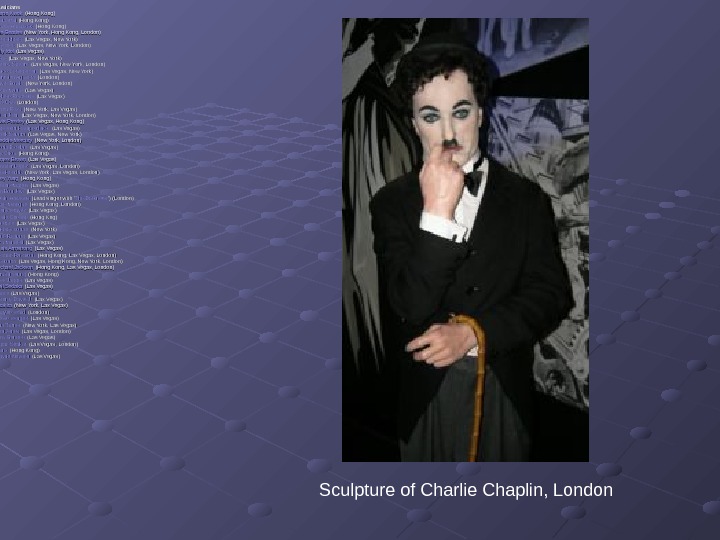
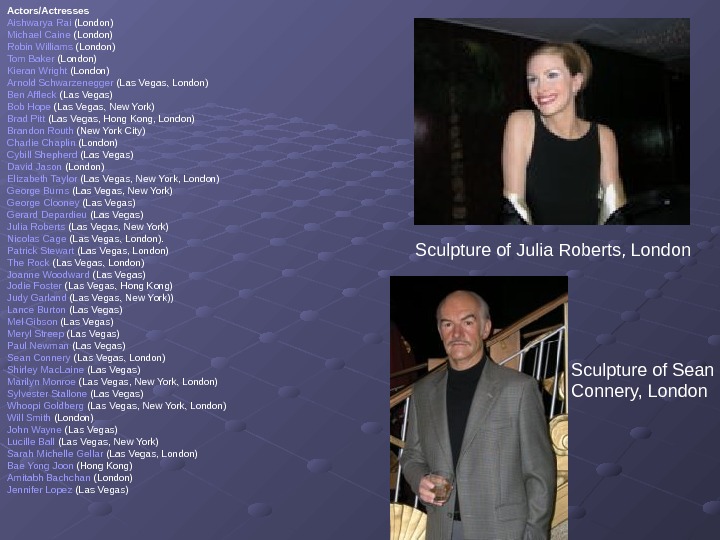
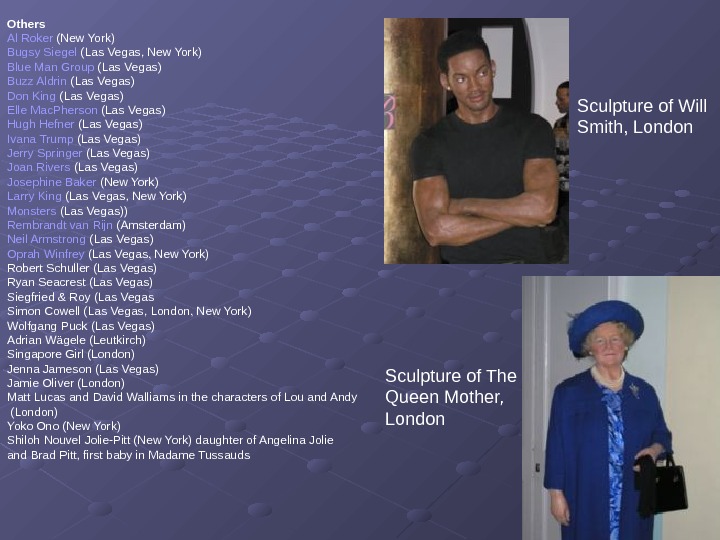
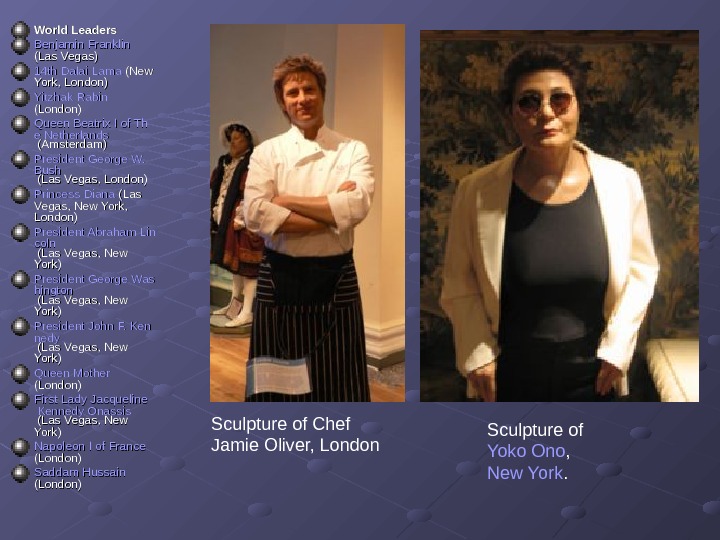
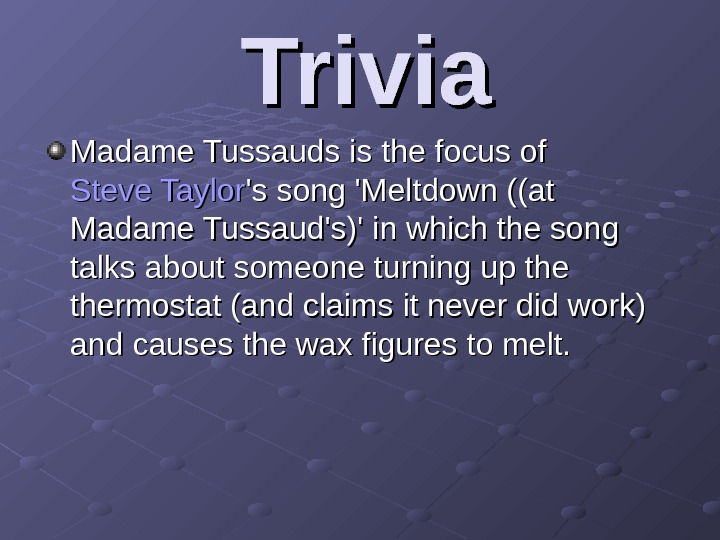
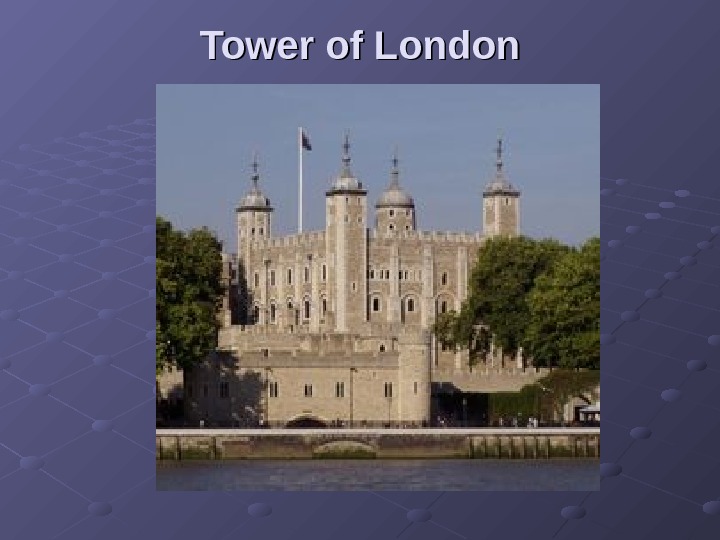
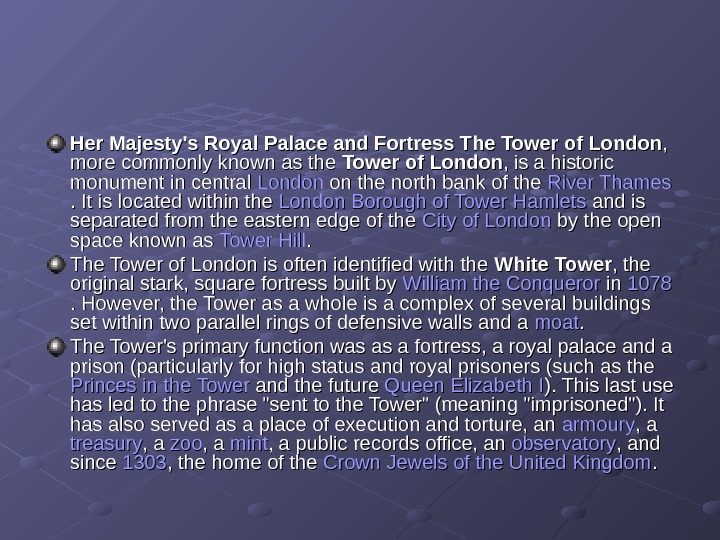
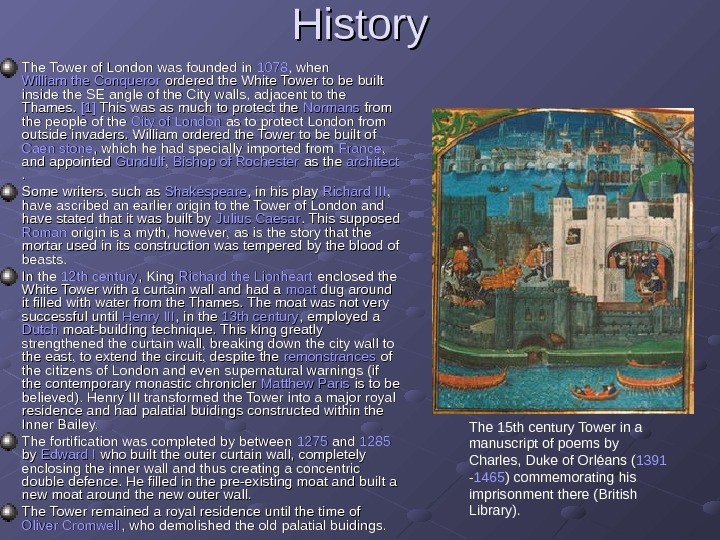
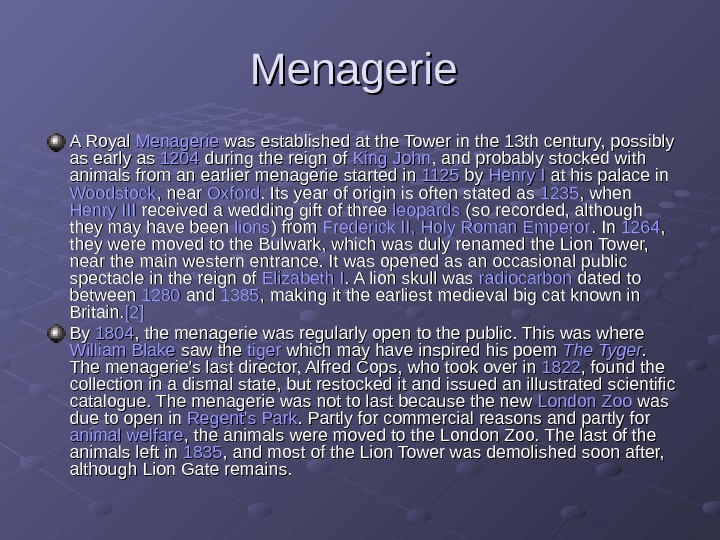

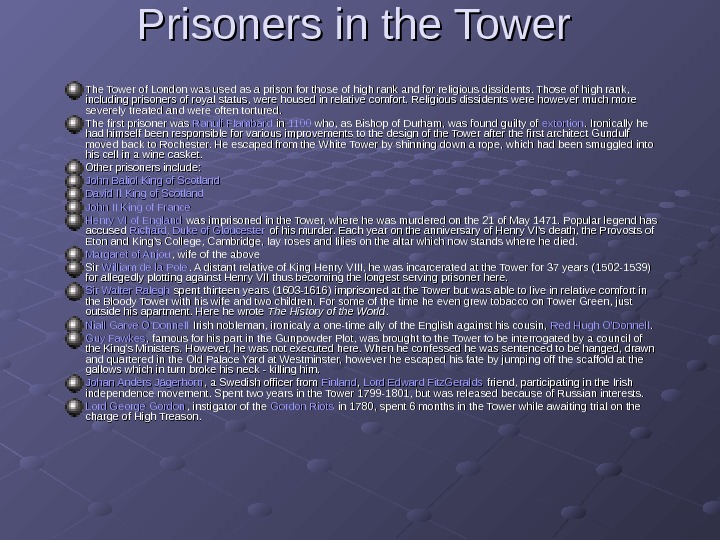

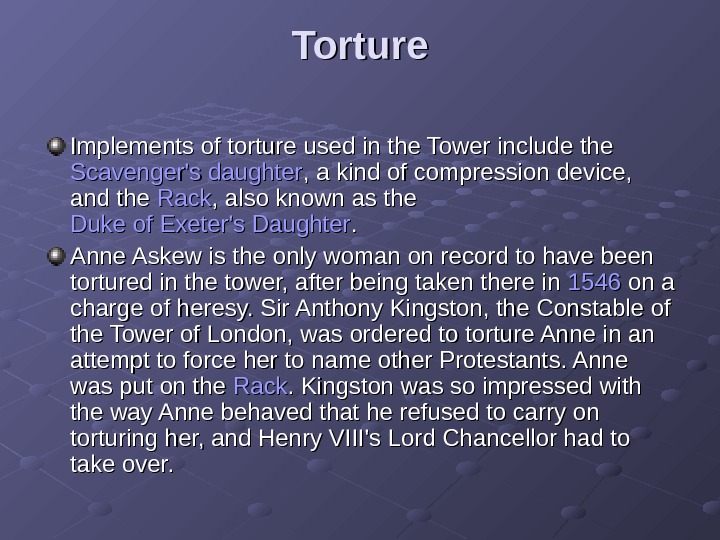
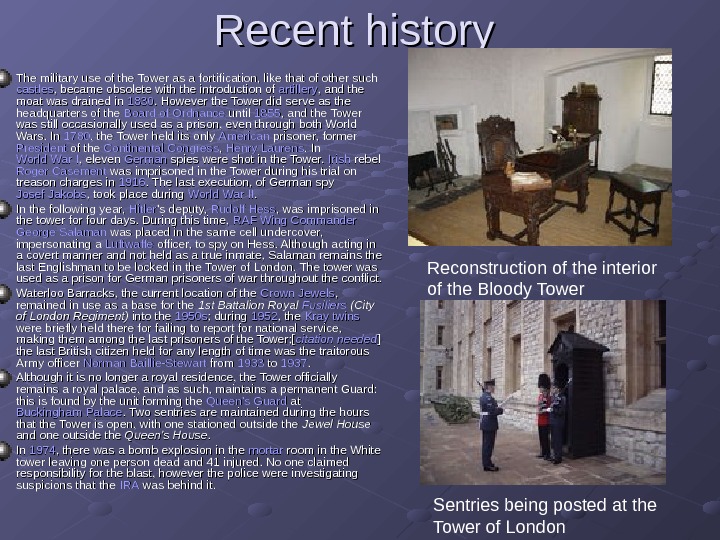
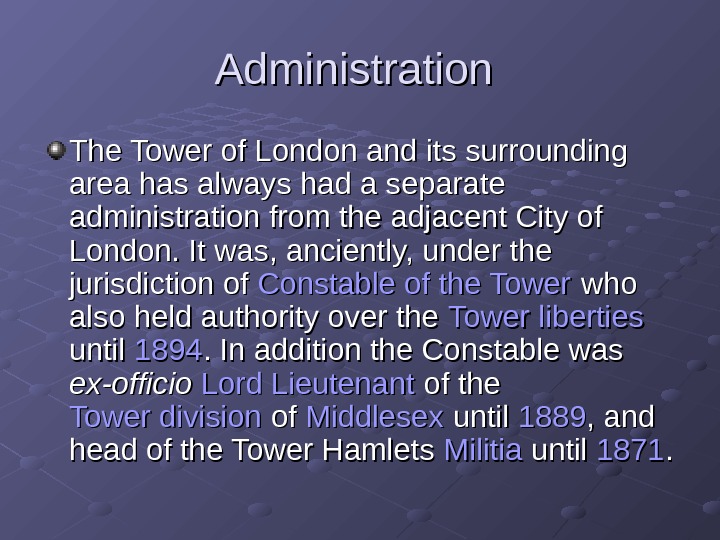
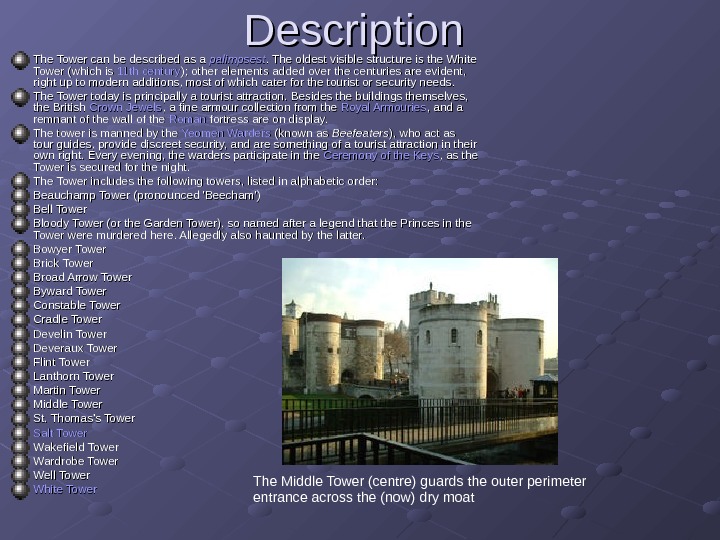

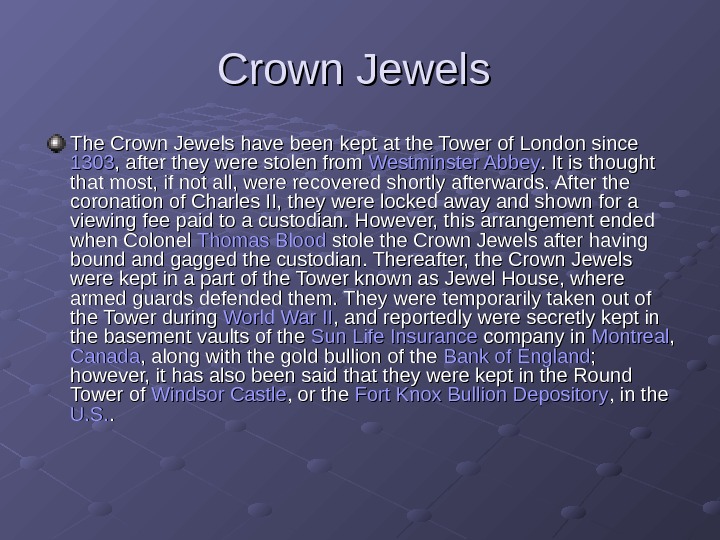
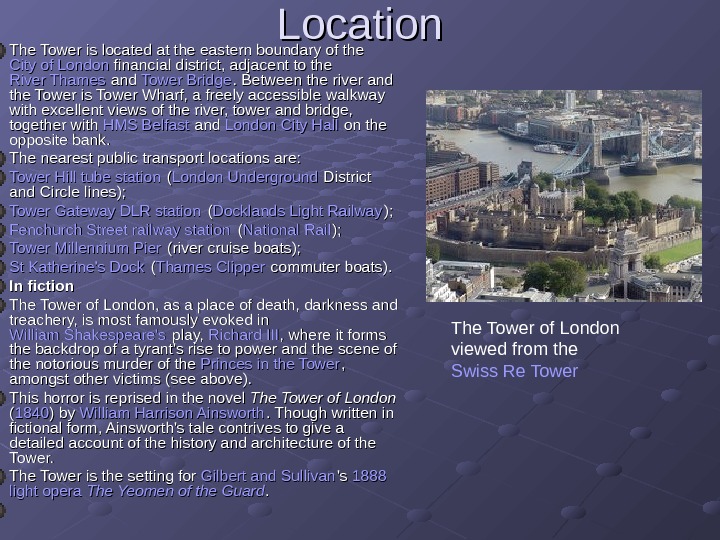
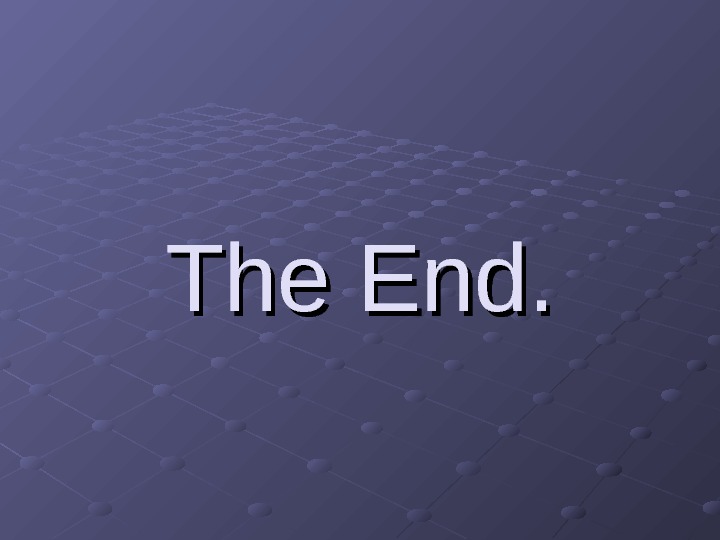
- Размер: 3 Mегабайта
- Количество слайдов: 82
Описание презентации London Museums. British Museum. British Museum. по слайдам
 London Museums.
London Museums.
 British Museum.
British Museum.
 British Museum. The British Museum in in London is one of the world’s greatest museums of human history and culture. Its collections, which number more than 13 million objects from all continents, illustrate and document the story of human culture from its beginning to the present. The wonders of the museum bought here to Bloomsbury from all around the world’s imagined corners are numberless. How can they be named? As well tally each leaf of a tree. They come here out of the living minds of generations of men and women now dead — Greek and Assyrian, Aztec and Inuit, Chinese and Indian — who have conceived and carved and hammered and tempered and cast these objects to represent the worlds around them, visible and invisible. [1][1] The British Museum was established in 1753 , largely based on the collections of the physician and scientist Sir Hans Sloane. The museum first opened to the public on 15 January 1759 in in Montagu House in in Bloomsbury , on the site of the current museum building. Its expansion over the following two and a half centuries has resulted in the creation of several branch institutions, the first being the British Museum (Natural History) in in South Kensington in in 1887. Until 1997, when the British Library opened to the public, the British Museum was unique in that it housed both a national museum of antiquities and a national library in the same building. Its present chairman is Sir John Boyd and its director is Neil Mac. Gregor. . As with all other national museums and art galleries in Britain, the Museum charges no admission fee, although charges are levied for some temporary special exhibitions. The centre of the museum was redeveloped in 2000 to become the Great Court , surrounding the original Reading Room.
British Museum. The British Museum in in London is one of the world’s greatest museums of human history and culture. Its collections, which number more than 13 million objects from all continents, illustrate and document the story of human culture from its beginning to the present. The wonders of the museum bought here to Bloomsbury from all around the world’s imagined corners are numberless. How can they be named? As well tally each leaf of a tree. They come here out of the living minds of generations of men and women now dead — Greek and Assyrian, Aztec and Inuit, Chinese and Indian — who have conceived and carved and hammered and tempered and cast these objects to represent the worlds around them, visible and invisible. [1][1] The British Museum was established in 1753 , largely based on the collections of the physician and scientist Sir Hans Sloane. The museum first opened to the public on 15 January 1759 in in Montagu House in in Bloomsbury , on the site of the current museum building. Its expansion over the following two and a half centuries has resulted in the creation of several branch institutions, the first being the British Museum (Natural History) in in South Kensington in in 1887. Until 1997, when the British Library opened to the public, the British Museum was unique in that it housed both a national museum of antiquities and a national library in the same building. Its present chairman is Sir John Boyd and its director is Neil Mac. Gregor. . As with all other national museums and art galleries in Britain, the Museum charges no admission fee, although charges are levied for some temporary special exhibitions. The centre of the museum was redeveloped in 2000 to become the Great Court , surrounding the original Reading Room.
 History. Though principally a museum of cultural art objects and antiquities today, the British Museum was founded as a «universal museum». This is reflected in the first bequest by Sir Hans Sloane , comprising some 40, 000 printed books, 7, 000 manuscripts, extensive natural history specimens, prints by Albrecht Dürer and antiquities from Egypt , , Greece , , Rome , the Middle and Far East and the Americas. . The Foundation Act, passed on 7 June 1753 , added two other libraries to the Sloane collection. The Cottonian Library, assembled by Sir Robert Cotton , dated back to Elizabethan times and the Harleian library was the collection of the first and second Earls of Oxford. They were joined in 1757 by the Royal Library assembled by various British monarchs. Together these four «Foundation collections» included many of the most treasured books now in the British Library , including the Lindisfarne Gospels and the sole surviving copy of Beowulf. . The body of trustees (which until 1963 was chaired by the Archbishop of Canterbury , the Lord Chancellor and the Speaker of the House of Commons ) decided on Montagu House as a location for the museum, which it bought from the Montagu family for ££ 20, 000. The Trustees rejected Buckingham House, on a site now occupied by Buckingham Palace , on the grounds of cost and the unsuitability of its location. After its foundation the British Museum received several gifts, including the Thomason Library and David Garrick ‘s library of 1, 000 printed plays, but had few ancient relics and would have been unrecognisable to visitors of the modern museum. The first notable addition to the collection of antiquities was by Sir William Hamilton , British Ambassador to Naples , who sold his collection of Greek and Roman artifacts to the museum in 1782. In the early 19 th century the foundations for the extensive collection of sculpture began to be laid. After the defeat of the French in the Battle of the Nile in in 1801 the British Museum acquired more Egyptian sculpture and the Rosetta Stone. Many Greek sculptures followed, notably the Towneley collection in 1805 and the Elgin Marbles in 1816. The collection soon outgrew its surroundings and the situation became urgent with the donation in 1822 of of King George III ‘s personal library of 65, 000 volumes, 19, 000 pamphlets, maps, charts and topographical drawings to the museum. The dilapidated Old Montagu House was demolished in 1845 and replaced by a design by the neoclassical architect Sir Robert Smirke. .
History. Though principally a museum of cultural art objects and antiquities today, the British Museum was founded as a «universal museum». This is reflected in the first bequest by Sir Hans Sloane , comprising some 40, 000 printed books, 7, 000 manuscripts, extensive natural history specimens, prints by Albrecht Dürer and antiquities from Egypt , , Greece , , Rome , the Middle and Far East and the Americas. . The Foundation Act, passed on 7 June 1753 , added two other libraries to the Sloane collection. The Cottonian Library, assembled by Sir Robert Cotton , dated back to Elizabethan times and the Harleian library was the collection of the first and second Earls of Oxford. They were joined in 1757 by the Royal Library assembled by various British monarchs. Together these four «Foundation collections» included many of the most treasured books now in the British Library , including the Lindisfarne Gospels and the sole surviving copy of Beowulf. . The body of trustees (which until 1963 was chaired by the Archbishop of Canterbury , the Lord Chancellor and the Speaker of the House of Commons ) decided on Montagu House as a location for the museum, which it bought from the Montagu family for ££ 20, 000. The Trustees rejected Buckingham House, on a site now occupied by Buckingham Palace , on the grounds of cost and the unsuitability of its location. After its foundation the British Museum received several gifts, including the Thomason Library and David Garrick ‘s library of 1, 000 printed plays, but had few ancient relics and would have been unrecognisable to visitors of the modern museum. The first notable addition to the collection of antiquities was by Sir William Hamilton , British Ambassador to Naples , who sold his collection of Greek and Roman artifacts to the museum in 1782. In the early 19 th century the foundations for the extensive collection of sculpture began to be laid. After the defeat of the French in the Battle of the Nile in in 1801 the British Museum acquired more Egyptian sculpture and the Rosetta Stone. Many Greek sculptures followed, notably the Towneley collection in 1805 and the Elgin Marbles in 1816. The collection soon outgrew its surroundings and the situation became urgent with the donation in 1822 of of King George III ‘s personal library of 65, 000 volumes, 19, 000 pamphlets, maps, charts and topographical drawings to the museum. The dilapidated Old Montagu House was demolished in 1845 and replaced by a design by the neoclassical architect Sir Robert Smirke. .
 History. Roughly contemporary with the construction of the new building was the career of a man sometimes called the «second founder» of the British Museum, the Italian librarian Antonio Panizzi. Under his supervision the British Museum Library quintupled in size and became a well-organised institution worthy of being called a national library. The quadrangle at the centre of Smirke’s design proved to be a waste of valuable space and was filled at Panizzi’s request by a circular Reading Room of of cast iron , designed by Smirke’s brother, Sydney Smirke. This is where Karl Marx famously carried out much of his research, and wrote some of his most important works. The natural history collections were an integral part of the British Museum until their removal to the new British Museum (Natural History), now the Natural History Museum , in 1887. The ethnography collections were until recently housed in the short-lived Museum of Mankind in in Piccadilly ; they have now returned to Bloomsbury and the Department of Ethnography has been renamed the Department of Africa , , Oceania and the Americas. . The temporary exhibition Treasures of Tutankhamun , held by the British Museum in 1972 , was the most successful in British history, attracting 1, 694, 117 visitors. In the same year the Act of Parliament establishing The British Library was passed, separating the collection of manuscripts and printed books from the British Museum. The Government suggested a site at St Pancras for the new British Library but the books did not leave the museum until 1997. With the bookstacks in the central courtyard of the museum now empty, the process of demolition for Lord Foster ‘s glass-roofed Great Court could begin. The Great Court , opened in 2000 , while undoubtedly improving circulation around the museum, was criticised for having a lack of exhibition space at a time when the museum was in serious financial difficulties and many galleries were closed to the public. At the same time the African and Oceanic collections that had been temporarily housed in Burlington House were given a new gallery in the North Wing funded by the Sainsbury family. In 2002 the museum was even closed for a day when its staff protested about proposed redundancies. A few weeks later the theft of a small Greek statue was blamed on lack of security staff. In autumn 2001 the 8 million objects forming the Museum’s permanent collection were further expanded by the addition of 6 million objects from the Wendorf Collection of Egyptian and Sudanese Prehistory. [2][2] These were donated by Professor Fred Wendorf of of Southern Methodist University in Texas, and comprise the entire collection of artefacts and environmental remains from his excavations between 1963 and 1997. They are housed in the the Department of Ancient Egypt and Sudan.
History. Roughly contemporary with the construction of the new building was the career of a man sometimes called the «second founder» of the British Museum, the Italian librarian Antonio Panizzi. Under his supervision the British Museum Library quintupled in size and became a well-organised institution worthy of being called a national library. The quadrangle at the centre of Smirke’s design proved to be a waste of valuable space and was filled at Panizzi’s request by a circular Reading Room of of cast iron , designed by Smirke’s brother, Sydney Smirke. This is where Karl Marx famously carried out much of his research, and wrote some of his most important works. The natural history collections were an integral part of the British Museum until their removal to the new British Museum (Natural History), now the Natural History Museum , in 1887. The ethnography collections were until recently housed in the short-lived Museum of Mankind in in Piccadilly ; they have now returned to Bloomsbury and the Department of Ethnography has been renamed the Department of Africa , , Oceania and the Americas. . The temporary exhibition Treasures of Tutankhamun , held by the British Museum in 1972 , was the most successful in British history, attracting 1, 694, 117 visitors. In the same year the Act of Parliament establishing The British Library was passed, separating the collection of manuscripts and printed books from the British Museum. The Government suggested a site at St Pancras for the new British Library but the books did not leave the museum until 1997. With the bookstacks in the central courtyard of the museum now empty, the process of demolition for Lord Foster ‘s glass-roofed Great Court could begin. The Great Court , opened in 2000 , while undoubtedly improving circulation around the museum, was criticised for having a lack of exhibition space at a time when the museum was in serious financial difficulties and many galleries were closed to the public. At the same time the African and Oceanic collections that had been temporarily housed in Burlington House were given a new gallery in the North Wing funded by the Sainsbury family. In 2002 the museum was even closed for a day when its staff protested about proposed redundancies. A few weeks later the theft of a small Greek statue was blamed on lack of security staff. In autumn 2001 the 8 million objects forming the Museum’s permanent collection were further expanded by the addition of 6 million objects from the Wendorf Collection of Egyptian and Sudanese Prehistory. [2][2] These were donated by Professor Fred Wendorf of of Southern Methodist University in Texas, and comprise the entire collection of artefacts and environmental remains from his excavations between 1963 and 1997. They are housed in the the Department of Ancient Egypt and Sudan.
 The circular Reading Room.
The circular Reading Room.
 Panorama of the circular Reading Room.
Panorama of the circular Reading Room.
 The Building The Greek Revival façade facing Great Russell Street is a characteristic building of Sir Robert Smirke , with 44 columns in the Ionic order 13. 7 metres (45 ftft ) high, closely based on those of the temple of Athena Polias at Priene in in Asia Minor. The pediment over the main entrance is decorated by sculptures by Sir Richard Westmacott depicting The Progress of Civilisation , consisting of fifteen allegorical figures, installed in 1852. The construction commenced around the courtyard with the East Wing (The King’s Library) in 1823 -28, followed by the North Wing in 1833 -38, original this housed amongst other galleries a reading room now the Wellcome Gallery, work was also progressing on the northern half of the West Wing (The Egyptian Sculpture Gallery) 1826 -31, then Montagu House was demolished from 1842 to make room for the final part of the West Wing completed in 1846 and the South Wing with its great colonnade, this was initiated in 1843, and completed in 1847 when the Front Hall and Great Staircase were opened to the public. [3][3] In 1846 Robert Smirke was replaced as the Museum’s architect by his brother Sydney Smirke, whose major addition was the Round Reading Room 1854 -57; at 42. 6 metres (140 ft) in diameter it was then the second widest dome in the world, the Pantheon in Rome being slightly wider. The next major addition was the White Wing 1882 -84 added behind the eastern end of the South Front, the architect being Sir John Taylor. . In 1895 the Trustees purchased the 69 houses surronding the Museum with the intention of demolishing them and building around the West, North and East sides of the Museum new galleries that would completely fill the block on which the Museum stands. Of this grand plan only the Edward VII galleries in the centre of the North Front were ever constructed, these were built 1906 -14 to the design of Sir John James Burnet and now house the Asian and Islamic collections. The British Museum — Aerial View
The Building The Greek Revival façade facing Great Russell Street is a characteristic building of Sir Robert Smirke , with 44 columns in the Ionic order 13. 7 metres (45 ftft ) high, closely based on those of the temple of Athena Polias at Priene in in Asia Minor. The pediment over the main entrance is decorated by sculptures by Sir Richard Westmacott depicting The Progress of Civilisation , consisting of fifteen allegorical figures, installed in 1852. The construction commenced around the courtyard with the East Wing (The King’s Library) in 1823 -28, followed by the North Wing in 1833 -38, original this housed amongst other galleries a reading room now the Wellcome Gallery, work was also progressing on the northern half of the West Wing (The Egyptian Sculpture Gallery) 1826 -31, then Montagu House was demolished from 1842 to make room for the final part of the West Wing completed in 1846 and the South Wing with its great colonnade, this was initiated in 1843, and completed in 1847 when the Front Hall and Great Staircase were opened to the public. [3][3] In 1846 Robert Smirke was replaced as the Museum’s architect by his brother Sydney Smirke, whose major addition was the Round Reading Room 1854 -57; at 42. 6 metres (140 ft) in diameter it was then the second widest dome in the world, the Pantheon in Rome being slightly wider. The next major addition was the White Wing 1882 -84 added behind the eastern end of the South Front, the architect being Sir John Taylor. . In 1895 the Trustees purchased the 69 houses surronding the Museum with the intention of demolishing them and building around the West, North and East sides of the Museum new galleries that would completely fill the block on which the Museum stands. Of this grand plan only the Edward VII galleries in the centre of the North Front were ever constructed, these were built 1906 -14 to the design of Sir John James Burnet and now house the Asian and Islamic collections. The British Museum — Aerial View
 The Building. The Duveen Gallery, sited to the west of the Egyptian, Greek & Assyrian sculpture galleries, was designed to house the Elgin Marbles by the American Beaux-Arts architect John Russell Pope. . Although completed in 1938 it was hit by a bomb in 1940 and remained semi-derelict for 22 years before reopening in 1962. Other areas damaged during World War II bombing included: in September 1940 two unexploded bombs hit the Edward VII galleries, the King’s Library received a direct hit from a high explosive bomb, incendiaries fell on the dome of the Round Reading Room but did little damage; on the night of 10 th to 11 th May 1941 several incendiaries fell on the South West corner of the Museum destroying the book stack and 150, 000 books in the courtyard and the galleries around the top of the Great Staircase burnt, this damage was not fully repaired until the early 1960’s. The Queen Elizabeth II Great Court is a covered square at the centre of the British Museum designed by the engineers Buro Happold and the architects Foster and Partners [4][4]. The Great Court opened in December 2000 and is the largest covered square in Europe. The roof is a glass and steel construction with 1, 656 uniquely shaped panes of glass. At the centre of the Great Court is the Reading Room vacated by the British Library , its functions now moved to St Pancras. The Reading Room is open to any member of the public who wishes to read there. Currently there are nearly one hundred galleries open to the public although the less popular have restricted opening times. Proposed British Museum Extension,
The Building. The Duveen Gallery, sited to the west of the Egyptian, Greek & Assyrian sculpture galleries, was designed to house the Elgin Marbles by the American Beaux-Arts architect John Russell Pope. . Although completed in 1938 it was hit by a bomb in 1940 and remained semi-derelict for 22 years before reopening in 1962. Other areas damaged during World War II bombing included: in September 1940 two unexploded bombs hit the Edward VII galleries, the King’s Library received a direct hit from a high explosive bomb, incendiaries fell on the dome of the Round Reading Room but did little damage; on the night of 10 th to 11 th May 1941 several incendiaries fell on the South West corner of the Museum destroying the book stack and 150, 000 books in the courtyard and the galleries around the top of the Great Staircase burnt, this damage was not fully repaired until the early 1960’s. The Queen Elizabeth II Great Court is a covered square at the centre of the British Museum designed by the engineers Buro Happold and the architects Foster and Partners [4][4]. The Great Court opened in December 2000 and is the largest covered square in Europe. The roof is a glass and steel construction with 1, 656 uniquely shaped panes of glass. At the centre of the Great Court is the Reading Room vacated by the British Library , its functions now moved to St Pancras. The Reading Room is open to any member of the public who wishes to read there. Currently there are nearly one hundred galleries open to the public although the less popular have restricted opening times. Proposed British Museum Extension,
 Department of Ancient Egypt and Sudan The British Museum houses the world’s largest and most comprehensive collection of Egyptian antiquities outside the Egyptian Museum in Cairo. An unequalled collection of immense importance for its range and quality, comprising objects of all periods from virtually every site of importance in Egypt and the Sudan. Objects illustrating every aspect of the cultures of the Nile Valley (including Nubia), from the Predynastic Neolithic period (c. 10 000 BC) through to the Coptic (Christian) times (12 th century AD), a time-span over 11, 000 years. Egyptian antiquities have formed part of the British Museum collection ever since it’s foundation in 1753 after receiving 150 Egyptian objects from Sir Hans Sloane. After the defeat of the French forces under Napolean at Alexandria in 1801, the Egyptian antiquities collected were confiscated by the British army and presented to the British Museum in 1803. Thus forming the first important acquisition of large sculptures, the most famous being the Rosetta Stone and has remained in the Museum ever since. Thereafter, Britain appointed Henry Salt as consul in Egypt who amassed a huge collection of antiquities. Most of the antiquities Salt collected were purchased by The British Museum and the Musee du Louvre. By 1866 the collection consisted of some 10, 000 objects. Antiquities from excavations started to come to the Museum in the later 19 th century as a result of the work of the Egypt Exploration Fund under the efforts of E. A. Wallis Budge. The collection stood at 57, 000 objects by 1924. Active support by the Museum for excavations in Egypt continued to result in useful acquisitions throughout the 20 th Century until changes in antiquities laws in Egypt led to the suspension of policies allowing finds to be exported. The size of the Egyptian collections now stands at over 110, 000 objects [5][5] [6][6]. . A representative selection of 4% of the entire collection is on display in the Museum’s seven permanent Egyptian galleries, including monumental sculptures adorning the Museum’s largest exhibition space (Room 4). Also contained in the upper galleries are a selection of the Museum’s famous collection of 140 mummies and coffins, the largest outside Cairo. A high proportion of the collection comes from tombs or contexts associated with the cult of the dead, and it is these pieces, in particular the mummies, that remain among the most eagerly-sought exhibits by visitors to the Museum.
Department of Ancient Egypt and Sudan The British Museum houses the world’s largest and most comprehensive collection of Egyptian antiquities outside the Egyptian Museum in Cairo. An unequalled collection of immense importance for its range and quality, comprising objects of all periods from virtually every site of importance in Egypt and the Sudan. Objects illustrating every aspect of the cultures of the Nile Valley (including Nubia), from the Predynastic Neolithic period (c. 10 000 BC) through to the Coptic (Christian) times (12 th century AD), a time-span over 11, 000 years. Egyptian antiquities have formed part of the British Museum collection ever since it’s foundation in 1753 after receiving 150 Egyptian objects from Sir Hans Sloane. After the defeat of the French forces under Napolean at Alexandria in 1801, the Egyptian antiquities collected were confiscated by the British army and presented to the British Museum in 1803. Thus forming the first important acquisition of large sculptures, the most famous being the Rosetta Stone and has remained in the Museum ever since. Thereafter, Britain appointed Henry Salt as consul in Egypt who amassed a huge collection of antiquities. Most of the antiquities Salt collected were purchased by The British Museum and the Musee du Louvre. By 1866 the collection consisted of some 10, 000 objects. Antiquities from excavations started to come to the Museum in the later 19 th century as a result of the work of the Egypt Exploration Fund under the efforts of E. A. Wallis Budge. The collection stood at 57, 000 objects by 1924. Active support by the Museum for excavations in Egypt continued to result in useful acquisitions throughout the 20 th Century until changes in antiquities laws in Egypt led to the suspension of policies allowing finds to be exported. The size of the Egyptian collections now stands at over 110, 000 objects [5][5] [6][6]. . A representative selection of 4% of the entire collection is on display in the Museum’s seven permanent Egyptian galleries, including monumental sculptures adorning the Museum’s largest exhibition space (Room 4). Also contained in the upper galleries are a selection of the Museum’s famous collection of 140 mummies and coffins, the largest outside Cairo. A high proportion of the collection comes from tombs or contexts associated with the cult of the dead, and it is these pieces, in particular the mummies, that remain among the most eagerly-sought exhibits by visitors to the Museum.
 Department of Ancient Egypt and Sudan Key highlights of the collections include: The Rosetta Stone (196 BC) Limestone statue of a husband and wife (1300 BC) Colossal bust of Ramesses II, the ‘Younger Memnon’ (1250 BC) Colossal granite head of Amenhotep III (1350 BC) Colossal head from a statue of Amenhotep III (1350 BC) Colossal limestone bust of Amenhotep III (1350 BC) Fragment of the beard of the Great Sphinx (1300 BC) List of the kings of Egypt from the Temple of Ramesses II (1250 BC) Limestone false door of Ptahshepses (2380 BC) Granite statue of Senwosret III (1850 BC) Mummy of Cleopatra from Thebes (100 AD) Amarna Tablets (Collection of 94 out of 382 tablets found, second greatest in the world after the Vorderasiatisches Museum, Berlin (202 tablets)) (1350 BC) The British Museum — Throne Relief Cast from the Hall of the Hundred Columns, Persepolis
Department of Ancient Egypt and Sudan Key highlights of the collections include: The Rosetta Stone (196 BC) Limestone statue of a husband and wife (1300 BC) Colossal bust of Ramesses II, the ‘Younger Memnon’ (1250 BC) Colossal granite head of Amenhotep III (1350 BC) Colossal head from a statue of Amenhotep III (1350 BC) Colossal limestone bust of Amenhotep III (1350 BC) Fragment of the beard of the Great Sphinx (1300 BC) List of the kings of Egypt from the Temple of Ramesses II (1250 BC) Limestone false door of Ptahshepses (2380 BC) Granite statue of Senwosret III (1850 BC) Mummy of Cleopatra from Thebes (100 AD) Amarna Tablets (Collection of 94 out of 382 tablets found, second greatest in the world after the Vorderasiatisches Museum, Berlin (202 tablets)) (1350 BC) The British Museum — Throne Relief Cast from the Hall of the Hundred Columns, Persepolis
 The British Museum, Room 4 — Colossal Granite head of Amenhotep III (1350 BC) The British Museum, Room 4 — Egyptian Sculpture
The British Museum, Room 4 — Colossal Granite head of Amenhotep III (1350 BC) The British Museum, Room 4 — Egyptian Sculpture
 Department of the Ancient Near East With approximately 280, 000 objects in the collection, the British Museum has the greatest collection of Mesopotamian antiquities outside Iraq. The holdings of Assyrian, Babylonian and Sumerian antiquities are among the most comprehensive in the world. The collections represent the civilisations of the ancient Near East and its adjacent areas. These include Mesopotamia, Iran (13, 000 objects) [16] , the Arabian Peninsula, Anatolia, the Caucasus, parts of Central Asia, Syria, Palestine and Phoenician settlements in the western Mediterranean from the prehistoric period until the coming of Islam in the 7 th century AD. The collection includes six iconic winged human-headed statues from Nimrud and Khorsabad. Stone bas-reliefs, including the famous Royal Lion Hunt relief’s (Room 10), that were found in the palaces of the Assyrian kings at Nimrud and Nineveh. The famous Royal Library of Ashurbanipal at Nineveh and Sumerian treasures found in Royal Cemetery’s at Ur of the Chaldees. A representative selection, including the most important pieces, are on display in 13 galleries and total some 4500 objects. The remainder form the study collection which ranges in size from beads to large sculptures. They include approximately 130, 000 cuneiform tablets from Mesopotamia. Contemporary collections can be found in the Musée du Louvre, Paris (90, 000 objects), The Oriental Institute of Art, Chicago (20, 000 objects) [17] , , Vorderasiatisches Museum, Berlin and The Metropolitan Museum of Art, New York (7, 000 objects) [18]
Department of the Ancient Near East With approximately 280, 000 objects in the collection, the British Museum has the greatest collection of Mesopotamian antiquities outside Iraq. The holdings of Assyrian, Babylonian and Sumerian antiquities are among the most comprehensive in the world. The collections represent the civilisations of the ancient Near East and its adjacent areas. These include Mesopotamia, Iran (13, 000 objects) [16] , the Arabian Peninsula, Anatolia, the Caucasus, parts of Central Asia, Syria, Palestine and Phoenician settlements in the western Mediterranean from the prehistoric period until the coming of Islam in the 7 th century AD. The collection includes six iconic winged human-headed statues from Nimrud and Khorsabad. Stone bas-reliefs, including the famous Royal Lion Hunt relief’s (Room 10), that were found in the palaces of the Assyrian kings at Nimrud and Nineveh. The famous Royal Library of Ashurbanipal at Nineveh and Sumerian treasures found in Royal Cemetery’s at Ur of the Chaldees. A representative selection, including the most important pieces, are on display in 13 galleries and total some 4500 objects. The remainder form the study collection which ranges in size from beads to large sculptures. They include approximately 130, 000 cuneiform tablets from Mesopotamia. Contemporary collections can be found in the Musée du Louvre, Paris (90, 000 objects), The Oriental Institute of Art, Chicago (20, 000 objects) [17] , , Vorderasiatisches Museum, Berlin and The Metropolitan Museum of Art, New York (7, 000 objects) [18]
 Department of the Ancient Near East. Sculptures Pair of Human Headed Winged ‘Lamassu’ Lions (883 -859 BC) Human Headed Winged ‘Lamassu’ Bull (883 -859 BC), sister piece in The Metropolitan Museum of Art, New York Human Headed Winged ‘Lamassu’ Lion (883 -859 BC), sister piece in The Metropolitan Museum of Art, New York Colossal Statue of a Lion (883 -859 BC) Rare Head of Human Headed Winged ‘Lamassu’, recovered from the remains of the South-West Palace of Esarhaddon The Black Obelisk of Shalmaneser III (858 -824 BC) The White Obelisk (1050 -1031 BC) Nineveh (City in Northern Iraq) Alabaster bas-reliefs from: North-Palace of Ashurbanipal Famous Royal Lion Hunt Scenes The ‘Dying Lion’, long been acclaimed as a masterpiece The ‘Garden Party’ Relief The White Obelisk, Some of the earliest scenes of Assyrian narrative art South-West Palace of Sennacherib Royal Library of Ashurbanipal A large collection of cuneiform tablets of enormous importance approximately 22, 000 inscribed clay tablets, now located in the British Museum The Flood Tablet, relating part of the Epic of Gilgamesh Khorsabad (City in Northern Iraq) Alabaster bas-reliefs from the Palace of Sargon II Pair of Human Headed Winged ‘Lamassu’ Bulls Wider Museum Collection Cyrus Cylinder from Babylon Bronze gates of Shalmaneser III and Ashurnasirpal II from Balawat A fine collection of Urartian bronzes, which now form the core of the Anatolian collection Oxus Treasure The Standard of Ur The ‘Ram in a Thicket’ The Royal Game of Ur Queen’s Lyre
Department of the Ancient Near East. Sculptures Pair of Human Headed Winged ‘Lamassu’ Lions (883 -859 BC) Human Headed Winged ‘Lamassu’ Bull (883 -859 BC), sister piece in The Metropolitan Museum of Art, New York Human Headed Winged ‘Lamassu’ Lion (883 -859 BC), sister piece in The Metropolitan Museum of Art, New York Colossal Statue of a Lion (883 -859 BC) Rare Head of Human Headed Winged ‘Lamassu’, recovered from the remains of the South-West Palace of Esarhaddon The Black Obelisk of Shalmaneser III (858 -824 BC) The White Obelisk (1050 -1031 BC) Nineveh (City in Northern Iraq) Alabaster bas-reliefs from: North-Palace of Ashurbanipal Famous Royal Lion Hunt Scenes The ‘Dying Lion’, long been acclaimed as a masterpiece The ‘Garden Party’ Relief The White Obelisk, Some of the earliest scenes of Assyrian narrative art South-West Palace of Sennacherib Royal Library of Ashurbanipal A large collection of cuneiform tablets of enormous importance approximately 22, 000 inscribed clay tablets, now located in the British Museum The Flood Tablet, relating part of the Epic of Gilgamesh Khorsabad (City in Northern Iraq) Alabaster bas-reliefs from the Palace of Sargon II Pair of Human Headed Winged ‘Lamassu’ Bulls Wider Museum Collection Cyrus Cylinder from Babylon Bronze gates of Shalmaneser III and Ashurnasirpal II from Balawat A fine collection of Urartian bronzes, which now form the core of the Anatolian collection Oxus Treasure The Standard of Ur The ‘Ram in a Thicket’ The Royal Game of Ur Queen’s Lyre
 Department of Coins and Medals The British Museum is home to one of the world’s finest numismatic collections, comprising about one million objects. The collection spans the entire history of coinage from its origins in the 7 th century BC to the present day. There are approximately 9, 000 coins, medals and banknotes on display around the British Museum. More than half of these can be found in the HSBC Money Gallery (Gallery 68), while the remainder form part of the permanent displays throughout the Museum.
Department of Coins and Medals The British Museum is home to one of the world’s finest numismatic collections, comprising about one million objects. The collection spans the entire history of coinage from its origins in the 7 th century BC to the present day. There are approximately 9, 000 coins, medals and banknotes on display around the British Museum. More than half of these can be found in the HSBC Money Gallery (Gallery 68), while the remainder form part of the permanent displays throughout the Museum.
 Department of Greek and Roman Antiquities The Department of Greek and Roman Antiquities of the British Museum has one of the world’s most comprehensive collections of antiquities from the Classical world, with over 100, 000 objects. These mostly range in date from the beginning of the Greek Bronze Age (about 3200 BC) to the reign of the Roman emperor Constantine in the 4 th century AD, with some pagan survivals. The Cycladic, Minoan and Mycenaean cultures are represented, and the Greek collection includes important sculpture from the Parthenon in Athens, as well as elements of two of the Seven Wonders of the Ancient World, the Mausoleum at Halikarnassos and the Temple of Artemis at Ephesos. The Department also houses one of the widest-ranging collections of Italic and Etruscan antiquities and extensive groups of material from Cyprus. The collections of ancient jewellery and bronzes, Greek vases and Roman glass and silver are particularly important. The British Museum, Room 17 — The Nereid Monument
Department of Greek and Roman Antiquities The Department of Greek and Roman Antiquities of the British Museum has one of the world’s most comprehensive collections of antiquities from the Classical world, with over 100, 000 objects. These mostly range in date from the beginning of the Greek Bronze Age (about 3200 BC) to the reign of the Roman emperor Constantine in the 4 th century AD, with some pagan survivals. The Cycladic, Minoan and Mycenaean cultures are represented, and the Greek collection includes important sculpture from the Parthenon in Athens, as well as elements of two of the Seven Wonders of the Ancient World, the Mausoleum at Halikarnassos and the Temple of Artemis at Ephesos. The Department also houses one of the widest-ranging collections of Italic and Etruscan antiquities and extensive groups of material from Cyprus. The collections of ancient jewellery and bronzes, Greek vases and Roman glass and silver are particularly important. The British Museum, Room 17 — The Nereid Monument
 Key highlights of the collections include: Athenian Akropolis The Parthenon Gallery («Elgin Marbles») The Parthenon Marbles are one of the finest manifestations of human creation. The Magnificent Relief Frieze showing the Panathenaic procession is considered as the most famous surviving example of art from Ancient Greece, often praised as the finest achievement of Greek architecture, Its decorative sculptures are considered one of the high points of Greek art Erechtheion The Finest of 6 remaining Caryatids Surviving Column Athena Nike Surviving Frieze Slabs Bassae Sculptures from the temple of Apollo Epikourios (‘Helper’) at Bassae in Arcadia. Twenty three surviving blocks of the frieze from the interior of the temple are exhibited on an upper level. Two colossal free-standing figures identified as Maussollos and his wife Artemisia. Part of an impressive horse from the chariot group adorning the summit of the Mausoleum The Amazonomachy frieze — A long section of relief frieze showing the battle between Greeks and Amazons Temple of Artemis at Ephesos One of the Seven Wonders of the Ancient World Architectiral fragments from the Archaic and fourth century temples of Artemis Marble column drum from the later Temple of Artemis Asia Minor (‘Turkey’) Nereid Monument Partial reconstruction of the Monument, a large and elaborate Lykian tomb from the site of Xanthos in south-west Turkey Payava Tomb from Xanthos in south west Turkey Wider Museum Collection Material from the Palace of Knossos Portland Vase The Warren Cup Discus-thrower (discobolos) Townley Sculptures
Key highlights of the collections include: Athenian Akropolis The Parthenon Gallery («Elgin Marbles») The Parthenon Marbles are one of the finest manifestations of human creation. The Magnificent Relief Frieze showing the Panathenaic procession is considered as the most famous surviving example of art from Ancient Greece, often praised as the finest achievement of Greek architecture, Its decorative sculptures are considered one of the high points of Greek art Erechtheion The Finest of 6 remaining Caryatids Surviving Column Athena Nike Surviving Frieze Slabs Bassae Sculptures from the temple of Apollo Epikourios (‘Helper’) at Bassae in Arcadia. Twenty three surviving blocks of the frieze from the interior of the temple are exhibited on an upper level. Two colossal free-standing figures identified as Maussollos and his wife Artemisia. Part of an impressive horse from the chariot group adorning the summit of the Mausoleum The Amazonomachy frieze — A long section of relief frieze showing the battle between Greeks and Amazons Temple of Artemis at Ephesos One of the Seven Wonders of the Ancient World Architectiral fragments from the Archaic and fourth century temples of Artemis Marble column drum from the later Temple of Artemis Asia Minor (‘Turkey’) Nereid Monument Partial reconstruction of the Monument, a large and elaborate Lykian tomb from the site of Xanthos in south-west Turkey Payava Tomb from Xanthos in south west Turkey Wider Museum Collection Material from the Palace of Knossos Portland Vase The Warren Cup Discus-thrower (discobolos) Townley Sculptures
 The British Museum, Room 22 — The Hellenistic World Asia Minor (‘Turkey’) Nereid Monument The British Museum, Room 21 — Mausoleum of Halikarnassos. JPG Mausoleum of Halikarnassos One of the Seven Wonders of th e Ancient World
The British Museum, Room 22 — The Hellenistic World Asia Minor (‘Turkey’) Nereid Monument The British Museum, Room 21 — Mausoleum of Halikarnassos. JPG Mausoleum of Halikarnassos One of the Seven Wonders of th e Ancient World
 Department of Prints and Drawings The Department of Prints and Drawings holds the national collection of Western Prints and Drawings. It ranks as one of the largest collections in existence alongside the Musee du Louvre and the Hermitage as one of the top three collections of its kind. Since its foundation in 1808 the Prints and Drawings collection has grown to international renown as one of the richest and most representative collections in the world. There are approximately 50, 000 Drawings and over 2 million Prints. The collection of Drawings covers the period 14 th century to the present, and includes many works of the highest quality by the leading artists of the European school. The collection of Prints covers the tradition of fine printmaking from its beginnings in the 15 th century up to the present, with near complete holdings of most of the great names before the 19 th century. There are magnificent groups of drawings by Leonardo da Vinci, Raphael, Michelangelo (including his only surviving full-scale cartoon), Dürer (a collection of 138 drawings is one of the finest in existence), Rubens, Rembrandt, Claude and Watteau, and virtually complete collections of the works of all the great printmakers including unsurpassed holdings of prints by Dürer (99 engravings, 6 etchings and a substantial number of his 346 woodcuts), Rembrandt and Goya. More than 30, 000 British drawings and watercolours include important examples work by Hogarth, Sandby, Turner, Girtin, Constable, Cotman, Cox, Gillray, Rowlandson and Cruikshank, as well as all the great Victorians. There are about a million British prints including more than 20, 000 satires and outstanding collections of works by William Blake and Thomas Bewick. Comparably, other great collections include: Musee du Louvre, Paris (133, 000 Drawings, 46, 000 Prints) [19] , , State Hermitage, St. Petersburg (39, 000 Drawings, 486, 000 Prints) [20] , The Metropolitan Museum of Art, New York (11, 000 Drawings, 1. 5 million Prints) [21] , Kupferstichkabinett, Museum of Prints and Drawings, . Berlin (110, 000 Drawings, 500, 000 Prints) [22] , Royal Collection, London (40, 000 Drawings, 150, 000 Prints, inc. 600 Leonardo da Vinci Drawings) [23] , Fitzwilliam, Cambridge (20, 000 Drawings, 180, 000 Prints) [24] , , Uffizi Gallery, Florence (120, 000 Drawings and Prints) [25] , National Gallery of Art, Washington (100, 000 Drawings and Prints) [26] , Moma, New York (6000 Drawings, 50, 000 Prints) [27] , Brooklyn Museum, New York (2, 000 Drawings, 40, 000 Prints) [28] , The Art Institute of Chicago, Chicago (11, 500 Drawings, 60, 000 Prints) [29] , Philadelphia Museum of Art, Philadelphia (150, 000 Drawings and Prints) [30]
Department of Prints and Drawings The Department of Prints and Drawings holds the national collection of Western Prints and Drawings. It ranks as one of the largest collections in existence alongside the Musee du Louvre and the Hermitage as one of the top three collections of its kind. Since its foundation in 1808 the Prints and Drawings collection has grown to international renown as one of the richest and most representative collections in the world. There are approximately 50, 000 Drawings and over 2 million Prints. The collection of Drawings covers the period 14 th century to the present, and includes many works of the highest quality by the leading artists of the European school. The collection of Prints covers the tradition of fine printmaking from its beginnings in the 15 th century up to the present, with near complete holdings of most of the great names before the 19 th century. There are magnificent groups of drawings by Leonardo da Vinci, Raphael, Michelangelo (including his only surviving full-scale cartoon), Dürer (a collection of 138 drawings is one of the finest in existence), Rubens, Rembrandt, Claude and Watteau, and virtually complete collections of the works of all the great printmakers including unsurpassed holdings of prints by Dürer (99 engravings, 6 etchings and a substantial number of his 346 woodcuts), Rembrandt and Goya. More than 30, 000 British drawings and watercolours include important examples work by Hogarth, Sandby, Turner, Girtin, Constable, Cotman, Cox, Gillray, Rowlandson and Cruikshank, as well as all the great Victorians. There are about a million British prints including more than 20, 000 satires and outstanding collections of works by William Blake and Thomas Bewick. Comparably, other great collections include: Musee du Louvre, Paris (133, 000 Drawings, 46, 000 Prints) [19] , , State Hermitage, St. Petersburg (39, 000 Drawings, 486, 000 Prints) [20] , The Metropolitan Museum of Art, New York (11, 000 Drawings, 1. 5 million Prints) [21] , Kupferstichkabinett, Museum of Prints and Drawings, . Berlin (110, 000 Drawings, 500, 000 Prints) [22] , Royal Collection, London (40, 000 Drawings, 150, 000 Prints, inc. 600 Leonardo da Vinci Drawings) [23] , Fitzwilliam, Cambridge (20, 000 Drawings, 180, 000 Prints) [24] , , Uffizi Gallery, Florence (120, 000 Drawings and Prints) [25] , National Gallery of Art, Washington (100, 000 Drawings and Prints) [26] , Moma, New York (6000 Drawings, 50, 000 Prints) [27] , Brooklyn Museum, New York (2, 000 Drawings, 40, 000 Prints) [28] , The Art Institute of Chicago, Chicago (11, 500 Drawings, 60, 000 Prints) [29] , Philadelphia Museum of Art, Philadelphia (150, 000 Drawings and Prints) [30]
 The British Museum, Room 90 — Michelangelo, Epifania — Last surviving large scale cartoon by the artist The British Museum, Room 90 — Durer, The Triumphal Arch — One of the largest prints ever produced
The British Museum, Room 90 — Michelangelo, Epifania — Last surviving large scale cartoon by the artist The British Museum, Room 90 — Durer, The Triumphal Arch — One of the largest prints ever produced
 Department of Asia The scope of the Department of Asia is extremely broad, its collections of over 70, 000 objects covers the material culture of the whole Asian continent (from East Asia, South and Central Asia, South-East Asia and the Islamic world) and from the Neolithic up to the present day. Key highlights of the collections include: The most comprehensive collection of sculpture from the Indian subcontinent in the world, including the celebrated Buddhist limestone reliefs from Amaravati An outstanding collection of Chinese antiquities, paintings, and porcelain, lacquer, bronze, jade, and other applied arts A fine collection of Buddhist paintings from Dunhuang in Central Asia and the Admonitions Scroll by Gu Kaizhi A broad range of Islamic pottery, paintings, tiles, metalwork, glass, seals, and inscriptions. The most comprehensive collection of Japanese pre-20 th century decorative arts in the western world
Department of Asia The scope of the Department of Asia is extremely broad, its collections of over 70, 000 objects covers the material culture of the whole Asian continent (from East Asia, South and Central Asia, South-East Asia and the Islamic world) and from the Neolithic up to the present day. Key highlights of the collections include: The most comprehensive collection of sculpture from the Indian subcontinent in the world, including the celebrated Buddhist limestone reliefs from Amaravati An outstanding collection of Chinese antiquities, paintings, and porcelain, lacquer, bronze, jade, and other applied arts A fine collection of Buddhist paintings from Dunhuang in Central Asia and the Admonitions Scroll by Gu Kaizhi A broad range of Islamic pottery, paintings, tiles, metalwork, glass, seals, and inscriptions. The most comprehensive collection of Japanese pre-20 th century decorative arts in the western world
 Department of Africa, Oceania and the Americas The British Museum houses one of the world’s greatest and most comprehensive collections of Ethnographic material from Africa, Oceania and the Americas, representing the cultures of indigenous peoples throughout the world. Over 550, 000 objects spanning two million years tells the story of the history of man, from three major continents and many rich and diverse cultures. The Sainsbury African Galleries display 600 objects from the greatest permanent collection of African arts and culture in the world. The three permanent galleries provide a substantial and permanent exhibition space for the Museum’s African collection comprising over 200, 000 objects. A curatorial scope that encompasses both archaeological and contemporary material, including both unique masterpieces of artistry and objects of everyday life. Highlights of the collection include a magnificent brass head of a Yoruba ruler from Ife, Nigeria; Asante goldwork from Ghana and the Torday collection of Central African sculpture, textiles and weaponry. The collection mainly consists of 19 th- and 20 th-century items although the Inca , , Aztec , , Maya and other early cultures are well represented; collecting of modern artifacts is ongoing. Other comparable collections can be found at The Horniman Museum, London (80, 000 objects), Pitt Rivers Museum, Cambridge, Musée du quai Branly, Paris(300, 000 objects), Boston Museum of Fine Arts, Boston (100, 000 Japanese Pieces), Metropolitan Museum of Art, New York (11, 000 objects), Brooklyn Museum, New York (11, 000 objects) and the Ethnographic Museum, Berlin (500, 000 objects).
Department of Africa, Oceania and the Americas The British Museum houses one of the world’s greatest and most comprehensive collections of Ethnographic material from Africa, Oceania and the Americas, representing the cultures of indigenous peoples throughout the world. Over 550, 000 objects spanning two million years tells the story of the history of man, from three major continents and many rich and diverse cultures. The Sainsbury African Galleries display 600 objects from the greatest permanent collection of African arts and culture in the world. The three permanent galleries provide a substantial and permanent exhibition space for the Museum’s African collection comprising over 200, 000 objects. A curatorial scope that encompasses both archaeological and contemporary material, including both unique masterpieces of artistry and objects of everyday life. Highlights of the collection include a magnificent brass head of a Yoruba ruler from Ife, Nigeria; Asante goldwork from Ghana and the Torday collection of Central African sculpture, textiles and weaponry. The collection mainly consists of 19 th- and 20 th-century items although the Inca , , Aztec , , Maya and other early cultures are well represented; collecting of modern artifacts is ongoing. Other comparable collections can be found at The Horniman Museum, London (80, 000 objects), Pitt Rivers Museum, Cambridge, Musée du quai Branly, Paris(300, 000 objects), Boston Museum of Fine Arts, Boston (100, 000 Japanese Pieces), Metropolitan Museum of Art, New York (11, 000 objects), Brooklyn Museum, New York (11, 000 objects) and the Ethnographic Museum, Berlin (500, 000 objects).
 Department of Prehistory and Europe The prehistoric collections cover Europe, Africa and Asia, the earliest African artefacts being around 2, 000, 000 years old. Coverage of Europe extends to the present day. Department of Conservation, Documentation and Science This department was founded in 1924. Conservation has six specialist areas: ceramics & glass; metals; organic material (including textiles); stone, wall paintings and mosaics; Eastern pictorial art and Western pictorial art. The science department has and continues to develop techniques to date artefacts, analyse and identify the materials used in their manufacture, to identify the place an artifact originated and the techniques used in their creation. The deparment also publishes its findings and discoveries. Libraries and Archives This department covers all levels of education, from casual visitors, schools, degree level and beyond. The Museum’s various libraries hold in excess of 350, 000 books, journals & pamphlets covering all areas of the museum’s collection. Also the general Museum archives which date from its foundation in 1753 are overseen by this department; the indivdual departments have their own separate archives covering their various areas of responsibility.
Department of Prehistory and Europe The prehistoric collections cover Europe, Africa and Asia, the earliest African artefacts being around 2, 000, 000 years old. Coverage of Europe extends to the present day. Department of Conservation, Documentation and Science This department was founded in 1924. Conservation has six specialist areas: ceramics & glass; metals; organic material (including textiles); stone, wall paintings and mosaics; Eastern pictorial art and Western pictorial art. The science department has and continues to develop techniques to date artefacts, analyse and identify the materials used in their manufacture, to identify the place an artifact originated and the techniques used in their creation. The deparment also publishes its findings and discoveries. Libraries and Archives This department covers all levels of education, from casual visitors, schools, degree level and beyond. The Museum’s various libraries hold in excess of 350, 000 books, journals & pamphlets covering all areas of the museum’s collection. Also the general Museum archives which date from its foundation in 1753 are overseen by this department; the indivdual departments have their own separate archives covering their various areas of responsibility.
 The Collections Highlights of the collections include: The Elgin Marbles , carvings from the Athenian Parthenon The Portland Vase The Rosetta Stone The Stein collection from Central Asia Works by Albrecht Dürer The Benin Bronzes The Cyrus Cylinder and many other Persian artifacts Anglo-Saxon artifacts from the Sutton Hoo burial The Lewis Chessmen The Mold cape (a Bronze age gold ceremonial cape) The basalt moai (statue) Hoa Hakananai’a from Easter Island The Mildenhall Treasure The British Museum, Room 20 — The Tomb of Payava, Lykian, about 375 —
The Collections Highlights of the collections include: The Elgin Marbles , carvings from the Athenian Parthenon The Portland Vase The Rosetta Stone The Stein collection from Central Asia Works by Albrecht Dürer The Benin Bronzes The Cyrus Cylinder and many other Persian artifacts Anglo-Saxon artifacts from the Sutton Hoo burial The Lewis Chessmen The Mold cape (a Bronze age gold ceremonial cape) The basalt moai (statue) Hoa Hakananai’a from Easter Island The Mildenhall Treasure The British Museum, Room 20 — The Tomb of Payava, Lykian, about 375 —
 Controversy It is a point of controversy whether museums should be allowed to possess artefacts taken from other countries, and the British Museum is a notable target for criticism. The Parthenon Marbles and the Benin Bronzes are among the most disputed objects in its collections, and organisations have been formed demanding the return of both sets of artefacts to their native countries of Greece and Nigeria respectively. The British Museum has refused to return either set, or any of its other disputed items, stating that the «restitutionist premise, that whatever was made in a country must return to an original geographical site, would empty both the British Museum and the other great museums of the world». [31] The Museum has also argued that the British Museum Act of 1963 legally prevents it from selling any of its valuable artefacts, even the ones not on display. Critics have particularly argued against the right of the British Museum to own objects which it does not share with the public. Supporters of the Museum claim that it has provided protection for artefacts that might have otherwise been damaged or destroyed if they had been left in their original environments. While some critics have accepted this, they also argue that the artefacts should now be returned to their countries of origin if there is sufficient expertise and desire there to preserve them. The British Museum continues to assert that it is an appropriate custodian and has an inalienable right to its disputed artefacts under British law. A few of the Parthenon Marble s (popularly known as the Elgin Marbles ) from the East Pediment of the Parthenon.
Controversy It is a point of controversy whether museums should be allowed to possess artefacts taken from other countries, and the British Museum is a notable target for criticism. The Parthenon Marbles and the Benin Bronzes are among the most disputed objects in its collections, and organisations have been formed demanding the return of both sets of artefacts to their native countries of Greece and Nigeria respectively. The British Museum has refused to return either set, or any of its other disputed items, stating that the «restitutionist premise, that whatever was made in a country must return to an original geographical site, would empty both the British Museum and the other great museums of the world». [31] The Museum has also argued that the British Museum Act of 1963 legally prevents it from selling any of its valuable artefacts, even the ones not on display. Critics have particularly argued against the right of the British Museum to own objects which it does not share with the public. Supporters of the Museum claim that it has provided protection for artefacts that might have otherwise been damaged or destroyed if they had been left in their original environments. While some critics have accepted this, they also argue that the artefacts should now be returned to their countries of origin if there is sufficient expertise and desire there to preserve them. The British Museum continues to assert that it is an appropriate custodian and has an inalienable right to its disputed artefacts under British law. A few of the Parthenon Marble s (popularly known as the Elgin Marbles ) from the East Pediment of the Parthenon.
 Trivia Pornographic and erotic items from many cultures — some of them Victorian fakes — were formerly kept in ‘Cupboard 55’ in the Department of Medieval and Later Antiquities (now part of the Department of Prehistory and Europe). This collection, not accessible to the public, was known as » the Secretum «; much of it had been collected by George Witt, a banker and former Mayor of Bedford, but was largely deemed unfit for public display on grounds of quality, rather than because of supposed obscenity. The Museum is faced with Portland stone, but the perimeter walls and other parts of the building were built using Hay Tor granite from Dartmoor in South Devon, transported via the unique Haytor Granite Tramway. .
Trivia Pornographic and erotic items from many cultures — some of them Victorian fakes — were formerly kept in ‘Cupboard 55’ in the Department of Medieval and Later Antiquities (now part of the Department of Prehistory and Europe). This collection, not accessible to the public, was known as » the Secretum «; much of it had been collected by George Witt, a banker and former Mayor of Bedford, but was largely deemed unfit for public display on grounds of quality, rather than because of supposed obscenity. The Museum is faced with Portland stone, but the perimeter walls and other parts of the building were built using Hay Tor granite from Dartmoor in South Devon, transported via the unique Haytor Granite Tramway. .
 Buckingham Palace
Buckingham Palace
 Buckingham Palace is the official London residence of the British monarch. . The Palace is a setting for state occasions and royal entertaining, a base for many officially visiting Heads of State , and a major tourist attraction. It has been a rallying point for the British people at times of national rejoicing, crisis or grief. «Buckingham Palace», «Buck House» or simply «The Palace» commonly refers to the source of press statements issued by the offices of the Royal Household. . In the Middle Ages, Buckingham Palace’s site formed part of the Manor of Ebury. It had several royal owners from Edward the Confessor onwards and was also the object of much property speculation. (A loophole in the lease of Charles I allowed the area to revert back to royal hands in the 18 th century. ) Precursors of Buckingham Palace were Blake House, Goring House, and Arlington House. Originally known as Buckingham House, the building forming the core of today’s palace was a large townhouse built for the Duke of Buckingham in in 1703 and acquired by King George III in 1762 as a private residence. It was enlarged over the next 75 years, principally by architects John Nash and Edward Blore , forming three wings around a central courtyard. Buckingham Palace finally became the official royal palace of the British monarch on the accession of Queen Victoria in 1837. The last major structural additions were made in the late 19 th and early 20 th century, when the large east wing facing The Mall was added, and the former State entrance, Marble Arch , was removed to its present position near Speakers’ Corner in in Hyde Park. The east front was refaced in Portland stone in 1913 as a backdrop to the Victoria Memorial , creating the present-day public face of Buckingham Palace, including the famous balcony. The original early 19 th-century interior designs, many of which still survive, included widespread use of brightly coloured scagliola and blue and pink lapis , on the advice of Sir Charles Long. . King Edward VII oversaw a partial redecoration in a Belle epoque cream and gold colour scheme. Many smaller reception rooms are furnished in the Chinese regency style with furniture and fittings brought from the Royal Pavilion at at Brighton and from Carlton House following the death of King George IV. The Buckingham Palace Gardens are the largest private gardens in London, originally landscaped by Capability Brown , but redesigned by William Townsend Aiton of of Kew Gardens and John Nash. The artificial lake was completed in 1828 and is supplied with water from the Serpentine , a lake in Hyde Park. . The State Rooms form the nucleus of the working Palace and are used regularly by The Queen and members of the royal family for official and state entertaining. Buckingham Palace is one of the world’s most familiar buildings and more than 50, 000 people visit the palace each year as guests to banquets, lunches, dinners, receptions and the royal garden parties. Many refer to the palace affectionately as Buck House. Queen Victoria , the first monarch to reside at Buckingham Palace, moved into the newly completed palace upon her accession in
Buckingham Palace is the official London residence of the British monarch. . The Palace is a setting for state occasions and royal entertaining, a base for many officially visiting Heads of State , and a major tourist attraction. It has been a rallying point for the British people at times of national rejoicing, crisis or grief. «Buckingham Palace», «Buck House» or simply «The Palace» commonly refers to the source of press statements issued by the offices of the Royal Household. . In the Middle Ages, Buckingham Palace’s site formed part of the Manor of Ebury. It had several royal owners from Edward the Confessor onwards and was also the object of much property speculation. (A loophole in the lease of Charles I allowed the area to revert back to royal hands in the 18 th century. ) Precursors of Buckingham Palace were Blake House, Goring House, and Arlington House. Originally known as Buckingham House, the building forming the core of today’s palace was a large townhouse built for the Duke of Buckingham in in 1703 and acquired by King George III in 1762 as a private residence. It was enlarged over the next 75 years, principally by architects John Nash and Edward Blore , forming three wings around a central courtyard. Buckingham Palace finally became the official royal palace of the British monarch on the accession of Queen Victoria in 1837. The last major structural additions were made in the late 19 th and early 20 th century, when the large east wing facing The Mall was added, and the former State entrance, Marble Arch , was removed to its present position near Speakers’ Corner in in Hyde Park. The east front was refaced in Portland stone in 1913 as a backdrop to the Victoria Memorial , creating the present-day public face of Buckingham Palace, including the famous balcony. The original early 19 th-century interior designs, many of which still survive, included widespread use of brightly coloured scagliola and blue and pink lapis , on the advice of Sir Charles Long. . King Edward VII oversaw a partial redecoration in a Belle epoque cream and gold colour scheme. Many smaller reception rooms are furnished in the Chinese regency style with furniture and fittings brought from the Royal Pavilion at at Brighton and from Carlton House following the death of King George IV. The Buckingham Palace Gardens are the largest private gardens in London, originally landscaped by Capability Brown , but redesigned by William Townsend Aiton of of Kew Gardens and John Nash. The artificial lake was completed in 1828 and is supplied with water from the Serpentine , a lake in Hyde Park. . The State Rooms form the nucleus of the working Palace and are used regularly by The Queen and members of the royal family for official and state entertaining. Buckingham Palace is one of the world’s most familiar buildings and more than 50, 000 people visit the palace each year as guests to banquets, lunches, dinners, receptions and the royal garden parties. Many refer to the palace affectionately as Buck House. Queen Victoria , the first monarch to reside at Buckingham Palace, moved into the newly completed palace upon her accession in
 Buckingham House c. 1710 as designed by William Winde for the first Duke of Buckingham and Normandy. This facade evolved into today’s Grand Entrance on the west (inner) side of the quadrangle, with the Green Drawing Room above.
Buckingham House c. 1710 as designed by William Winde for the first Duke of Buckingham and Normandy. This facade evolved into today’s Grand Entrance on the west (inner) side of the quadrangle, with the Green Drawing Room above.
 The site In the Middle Ages, Buckingham Palace’s site formed part of the Manor of Ebury (also called Eia). The marshy ground was watered by the river Tyburn , which still flows below the courtyard and south wing of the palace. Where the river was fordable — Cow Ford — a village, Eye Cross, grew up. Ownership of the site changed hands many times, including Edward the Confessor and his wife Queen Edith , and, after the Norman Conquest, William the Conqueror , who gave it to Geoffrey de Mandeville. . Mandeville bequeathed it to the monks of Westminster Abbey. . [1][1] In 1531 King Henry VIII acquired from Eton College the Hospital of St James (later St James’s Palace ), and in 1536 he received the Manor of Ebury from Westminster Abbey. These transfers brought the site of Buckingham Palace back into royal hands for the first time since William the Conqueror had given it away almost 500 years earlier. Various owners leased it from Royal landlords and the freehold was the subject of frenzied speculation in the 17 th century. By then, the old village of Eye Cross had long ago fallen into decay and the area was mostly wasteland. [2][2] Needing money, King James I sold part of the Crown freehold off but retained part of the site on which he established a 4 -acre Mulberry Garden for the production of silk. (This is at the northwest corner of today’s palace. ) Clement Walker in Anarchia Anglicana (1649) refers to «new-erected sodoms and spintries at the Mulberry Garden at S. James’s», suggesting it may have been a place of debauchery. Eventually, in the late 17 th century, the freehold was inherited from the property tycoon Sir Hugh Audley by the great heiress Mary Davies. [3][3]
The site In the Middle Ages, Buckingham Palace’s site formed part of the Manor of Ebury (also called Eia). The marshy ground was watered by the river Tyburn , which still flows below the courtyard and south wing of the palace. Where the river was fordable — Cow Ford — a village, Eye Cross, grew up. Ownership of the site changed hands many times, including Edward the Confessor and his wife Queen Edith , and, after the Norman Conquest, William the Conqueror , who gave it to Geoffrey de Mandeville. . Mandeville bequeathed it to the monks of Westminster Abbey. . [1][1] In 1531 King Henry VIII acquired from Eton College the Hospital of St James (later St James’s Palace ), and in 1536 he received the Manor of Ebury from Westminster Abbey. These transfers brought the site of Buckingham Palace back into royal hands for the first time since William the Conqueror had given it away almost 500 years earlier. Various owners leased it from Royal landlords and the freehold was the subject of frenzied speculation in the 17 th century. By then, the old village of Eye Cross had long ago fallen into decay and the area was mostly wasteland. [2][2] Needing money, King James I sold part of the Crown freehold off but retained part of the site on which he established a 4 -acre Mulberry Garden for the production of silk. (This is at the northwest corner of today’s palace. ) Clement Walker in Anarchia Anglicana (1649) refers to «new-erected sodoms and spintries at the Mulberry Garden at S. James’s», suggesting it may have been a place of debauchery. Eventually, in the late 17 th century, the freehold was inherited from the property tycoon Sir Hugh Audley by the great heiress Mary Davies. [3][3]
 First houses on the site Possibly the first house erected within the site was that of a Sir William Blake, around 1624. [4][4] The next owner was Lord Goring , who from 1633 extended Blake’s house and developed much of today’s garden, then known as Goring Great Garden. He did not, however, manage to obtain freehold interest in the mulberry garden. Unbeknown to Goring, in 1640 the document «failed to pass the great seal before King Charles I fled London, which it needed to do for legal execution». [5][5] (It was this critical omission that helped the British royal family regain the freehold under King George III. ). ) The improvident Goring defaulted on his rents; Henry Bennet, 1 st Earl of Arlington obtained and was occupying the mansion, now known as Goring House, when it burnt down in 1674. Arlington House rose on the site — the southern wing of today’s palace — the next year, and its freehold was sold on in 1702. The house which forms the architectural core of the present palace was built for the first Duke of Buckingham and Normanby in 1703 to the design of William Winde. The style chosen was of a large, three-floored central block with two smaller flanking service wings. Buckingham House was eventually sold by Buckingham’s descendant, Sir Charles Sheffield, in 1762 to King George III for ££ 21, 000. [6][6] (Like his grandfather, George II, George III refused to sell the mulberry garden interest, so that Sheffield had been unable to purchase the full freehold of the site. ) The house was originally intended as a private retreat for the royal family, and in particular for Queen Charlotte , and was known as The Queen’s House. St. James’s Palace remained the official and ceremonial royal residence; indeed, the tradition continues to date of foreign ambassadors being formally accredited to «the Court of St. James’s «, even though it is at Buckingham Palace that they present their credentials and staff to the Queen upon their appointment.
First houses on the site Possibly the first house erected within the site was that of a Sir William Blake, around 1624. [4][4] The next owner was Lord Goring , who from 1633 extended Blake’s house and developed much of today’s garden, then known as Goring Great Garden. He did not, however, manage to obtain freehold interest in the mulberry garden. Unbeknown to Goring, in 1640 the document «failed to pass the great seal before King Charles I fled London, which it needed to do for legal execution». [5][5] (It was this critical omission that helped the British royal family regain the freehold under King George III. ). ) The improvident Goring defaulted on his rents; Henry Bennet, 1 st Earl of Arlington obtained and was occupying the mansion, now known as Goring House, when it burnt down in 1674. Arlington House rose on the site — the southern wing of today’s palace — the next year, and its freehold was sold on in 1702. The house which forms the architectural core of the present palace was built for the first Duke of Buckingham and Normanby in 1703 to the design of William Winde. The style chosen was of a large, three-floored central block with two smaller flanking service wings. Buckingham House was eventually sold by Buckingham’s descendant, Sir Charles Sheffield, in 1762 to King George III for ££ 21, 000. [6][6] (Like his grandfather, George II, George III refused to sell the mulberry garden interest, so that Sheffield had been unable to purchase the full freehold of the site. ) The house was originally intended as a private retreat for the royal family, and in particular for Queen Charlotte , and was known as The Queen’s House. St. James’s Palace remained the official and ceremonial royal residence; indeed, the tradition continues to date of foreign ambassadors being formally accredited to «the Court of St. James’s «, even though it is at Buckingham Palace that they present their credentials and staff to the Queen upon their appointment.
 House to palace Queen Charlotte died in 1818 and George III in 1820. The spendthrift King George IV decided to enlarge Buckingham House to use in conjunction with St James’s Palace as had his father, but by 1826 he had decided to convert the house to a fully equipped royal palace. He commissioned John Nash to realise his vision. The palace that arose formed three sides of an open cour d’honneur , with the former Buckingham House as the corps de logis. The new work was faced in Bath stone, with exquisite detailing in the French neoclassical style. This is the palace much as it is today, but without the great east front (facing The Mall ) which now encloses the quadrangle. On the future site of the present east front, between the two projecting wings, was a colossal triumphal arch of Racaccione marble , modelled on the Arch of Constantine in in Rome. . This arch, which had cost ££ 34, 450 to build, served as the state entrance. George IV had intended it to be crowned by a bronze equestrian statue of himself, but he died before its completion, and when Parliament reluctantly paid the bill for it, they decided to put it in Hyde Park , where it remains today. The interiors of the palace were to be of unparalleled splendour. George IV was advised on the interior design by Sir Charles Long , who advocated the widespread use of brightly coloured scagliola and blue and pink lapis , with sculptured plaster panels set in the ceilings. George IV died in 1830, and the colourful and heavily gilded present state and semi-state rooms were not completed until the reign of King William IV. . King William IV’s practicality informed the completion of the palace. While his monogram and that of Queen Adelaide decorates many rooms, they never lived there By the time of George IV’s death, the escalating cost of the still unfinished palace was causing concern in both parliament and the press. William IV dismissed Nash as architect and employed Edward Blore , who suited admirably the more restrained tastes of the new king. A less idealistic but more businesslike architect than Nash, Blore retained Nash’s contributions and completed the palace in a similar, if more solid and less picturesque, vein. The final cost to the nation of rebuilding Buckingham Palace was more than £ 719, 000. Though William IV and Queen Adelaide held receptions and courts in the state rooms, they never lived in the palace, preferring to remain at Clarence House , the more modest London mansion they had commissioned to be built before their succession. Moreover, when the Houses of Parliament burned down in 1834, the King offered the incomplete palace to the nation as a replacement seat of government. (The offer was declined and the old Palace of Westminster rebuilt. ) Many of the smaller reception rooms were furnished during William IV’s reign — as they remain today — in the Chinese Regency style, utilising many of the fireplaces, decorations, and furniture brought from George IV’s palaces, the Royal Pavilion at at Brighton and from Carlton House , following his death.
House to palace Queen Charlotte died in 1818 and George III in 1820. The spendthrift King George IV decided to enlarge Buckingham House to use in conjunction with St James’s Palace as had his father, but by 1826 he had decided to convert the house to a fully equipped royal palace. He commissioned John Nash to realise his vision. The palace that arose formed three sides of an open cour d’honneur , with the former Buckingham House as the corps de logis. The new work was faced in Bath stone, with exquisite detailing in the French neoclassical style. This is the palace much as it is today, but without the great east front (facing The Mall ) which now encloses the quadrangle. On the future site of the present east front, between the two projecting wings, was a colossal triumphal arch of Racaccione marble , modelled on the Arch of Constantine in in Rome. . This arch, which had cost ££ 34, 450 to build, served as the state entrance. George IV had intended it to be crowned by a bronze equestrian statue of himself, but he died before its completion, and when Parliament reluctantly paid the bill for it, they decided to put it in Hyde Park , where it remains today. The interiors of the palace were to be of unparalleled splendour. George IV was advised on the interior design by Sir Charles Long , who advocated the widespread use of brightly coloured scagliola and blue and pink lapis , with sculptured plaster panels set in the ceilings. George IV died in 1830, and the colourful and heavily gilded present state and semi-state rooms were not completed until the reign of King William IV. . King William IV’s practicality informed the completion of the palace. While his monogram and that of Queen Adelaide decorates many rooms, they never lived there By the time of George IV’s death, the escalating cost of the still unfinished palace was causing concern in both parliament and the press. William IV dismissed Nash as architect and employed Edward Blore , who suited admirably the more restrained tastes of the new king. A less idealistic but more businesslike architect than Nash, Blore retained Nash’s contributions and completed the palace in a similar, if more solid and less picturesque, vein. The final cost to the nation of rebuilding Buckingham Palace was more than £ 719, 000. Though William IV and Queen Adelaide held receptions and courts in the state rooms, they never lived in the palace, preferring to remain at Clarence House , the more modest London mansion they had commissioned to be built before their succession. Moreover, when the Houses of Parliament burned down in 1834, the King offered the incomplete palace to the nation as a replacement seat of government. (The offer was declined and the old Palace of Westminster rebuilt. ) Many of the smaller reception rooms were furnished during William IV’s reign — as they remain today — in the Chinese Regency style, utilising many of the fireplaces, decorations, and furniture brought from George IV’s palaces, the Royal Pavilion at at Brighton and from Carlton House , following his death.
 George IV transformed Buckingham House into a palace
George IV transformed Buckingham House into a palace
 The Garden, the Royal Mews and the Mall At the back of the Palace, large and park-like, is the Garden. The Garden Front of the Palace, by Nash, is of pale golden Bath stone. The Garden, which includes a lake, is the largest private garden in London. (Details of its architecture and artworks are in Buckingham Palace Gardens. ). ) Here the Queen hosts her annual garden parties each summer, but since June 2002, she has invited the public into the Garden on numerous occasions. See Buckingham Palace Garden for accounts for the historical spectaculars which marked the Queen’s Golden Jubilee (2002) and her 80 th birthday (2006). Adjacent to the Palace is the Royal Mews , also designed by Nash, where the royal carriages, including the Gold State Coach , are housed. This rococo gilt coach, designed by Sir William Chambers in 1760, has painted panels by G. B. Cipriani. It was first used for the State Opening of Parliament by George III in 1762 and is used by the monarch only for coronations or jubilee celebrations. Also housed in the Mews are the carriage horses used in royal ceremonial processions. The Mall, a ceremonial approach route to the Palace, was designed by Sir Aston Webb and completed in 1911 as part of a grand memorial to Queen Victoria. It extends from Admiralty Arch , up around the Victoria Memorial to the Palace forecourt. The reddish colour of the Mall’s tarmac recalls the red carpet of former times. This route is used by the cavalcades and motorcades of all visiting heads of state, and by the Royal Family on state occasions such as the annual State Opening of Parliament as well as Trooping the Colour each year.
The Garden, the Royal Mews and the Mall At the back of the Palace, large and park-like, is the Garden. The Garden Front of the Palace, by Nash, is of pale golden Bath stone. The Garden, which includes a lake, is the largest private garden in London. (Details of its architecture and artworks are in Buckingham Palace Gardens. ). ) Here the Queen hosts her annual garden parties each summer, but since June 2002, she has invited the public into the Garden on numerous occasions. See Buckingham Palace Garden for accounts for the historical spectaculars which marked the Queen’s Golden Jubilee (2002) and her 80 th birthday (2006). Adjacent to the Palace is the Royal Mews , also designed by Nash, where the royal carriages, including the Gold State Coach , are housed. This rococo gilt coach, designed by Sir William Chambers in 1760, has painted panels by G. B. Cipriani. It was first used for the State Opening of Parliament by George III in 1762 and is used by the monarch only for coronations or jubilee celebrations. Also housed in the Mews are the carriage horses used in royal ceremonial processions. The Mall, a ceremonial approach route to the Palace, was designed by Sir Aston Webb and completed in 1911 as part of a grand memorial to Queen Victoria. It extends from Admiralty Arch , up around the Victoria Memorial to the Palace forecourt. The reddish colour of the Mall’s tarmac recalls the red carpet of former times. This route is used by the cavalcades and motorcades of all visiting heads of state, and by the Royal Family on state occasions such as the annual State Opening of Parliament as well as Trooping the Colour each year.
 A garden party at Buckingham Palace in 1868. Crowds walk down the Mall towards the Palace and the Victoria Memorial. The flags interspersed with the Union Flag indicate a Norwegian State Visit in progress.
A garden party at Buckingham Palace in 1868. Crowds walk down the Mall towards the Palace and the Victoria Memorial. The flags interspersed with the Union Flag indicate a Norwegian State Visit in progress.
 Home of the monarch Buckingham Palace finally became the principal Royal residence in 1837 on the accession of Queen Victoria. . While the State Rooms were a riot of gilt and colour, the necessities of the new palace were somewhat less luxurious. It was reported the chimneys smoked so much that the fires had to be allowed to die, and consequently the court shivered in icy magnificence. Ventilation was so bad that the interior smelled, and when a decision was taken to install gas lamps there was a serious worry about the build up of gas on the lower floors. It was also said that the staff were lax and lazy and the palace was dirty. Following the Queen’s marriage in 1840, her husband, Prince Albert , concerned himself with a reorganization of the household offices and staff, and with the design faults of the palace. The problems were rectified, the builders finally leaving the palace in 1840. By 1847, the couple had found the palace too small for Court life and their growing family, and consequently the new wing, designed by Edward Blore , was built, enclosing the central quadrangle. This large east wing, facing The Mall is today the ‘public face’ of Buckingham Palace and contains the balcony from which the Royal Family acknowledge the crowds on momentous occasions and annually following Trooping the Colour. The ballroom wing and a further suite of state rooms were also built in this period, designed by Nash’s student Sir James Pennethorne. . Before Prince Albert’s demise, Queen Victoria was known to love music and dancing, and the greatest contemporary musicians entertained at Buckingham Palace. Felix Mendelssohn is known to have played there on three occasions. Johann Strauss II and his orchestra played there when in England. Strauss’ ‘Alice Polka’ was first performed at the palace in 1849 in honour of the Queen’s daughter, Princess Alice. Under Victoria, Buckingham Palace was frequently the scene of lavish costume balls, in addition to the routine royal ceremonies, investitures and presentations. When widowed in 1861, the griefstricken Queen withdrew from public life and left Buckingham Palace to live at Windsor Castle , , Balmoral Castle , and Osborne House. For many years the palace was seldom used, and even neglected. Eventually public opinion forced her to return to London, though even then she preferred to live elsewhere whenever possible. Court functions were still held at Windsor Castle rather than at the palace, presided over by the sombre Queen habitually dressed in mourning black. The Palace c. 1837, depicting the Marble Arch , which served as the ceremonial entrance to the palace precincts. It was moved to make way for the east wing, built in 1847, which enclosed the quadrangle.
Home of the monarch Buckingham Palace finally became the principal Royal residence in 1837 on the accession of Queen Victoria. . While the State Rooms were a riot of gilt and colour, the necessities of the new palace were somewhat less luxurious. It was reported the chimneys smoked so much that the fires had to be allowed to die, and consequently the court shivered in icy magnificence. Ventilation was so bad that the interior smelled, and when a decision was taken to install gas lamps there was a serious worry about the build up of gas on the lower floors. It was also said that the staff were lax and lazy and the palace was dirty. Following the Queen’s marriage in 1840, her husband, Prince Albert , concerned himself with a reorganization of the household offices and staff, and with the design faults of the palace. The problems were rectified, the builders finally leaving the palace in 1840. By 1847, the couple had found the palace too small for Court life and their growing family, and consequently the new wing, designed by Edward Blore , was built, enclosing the central quadrangle. This large east wing, facing The Mall is today the ‘public face’ of Buckingham Palace and contains the balcony from which the Royal Family acknowledge the crowds on momentous occasions and annually following Trooping the Colour. The ballroom wing and a further suite of state rooms were also built in this period, designed by Nash’s student Sir James Pennethorne. . Before Prince Albert’s demise, Queen Victoria was known to love music and dancing, and the greatest contemporary musicians entertained at Buckingham Palace. Felix Mendelssohn is known to have played there on three occasions. Johann Strauss II and his orchestra played there when in England. Strauss’ ‘Alice Polka’ was first performed at the palace in 1849 in honour of the Queen’s daughter, Princess Alice. Under Victoria, Buckingham Palace was frequently the scene of lavish costume balls, in addition to the routine royal ceremonies, investitures and presentations. When widowed in 1861, the griefstricken Queen withdrew from public life and left Buckingham Palace to live at Windsor Castle , , Balmoral Castle , and Osborne House. For many years the palace was seldom used, and even neglected. Eventually public opinion forced her to return to London, though even then she preferred to live elsewhere whenever possible. Court functions were still held at Windsor Castle rather than at the palace, presided over by the sombre Queen habitually dressed in mourning black. The Palace c. 1837, depicting the Marble Arch , which served as the ceremonial entrance to the palace precincts. It was moved to make way for the east wing, built in 1847, which enclosed the quadrangle.
 Interior The principal rooms of the Palace are contained on the piano nobile behind the west-facing garden facade at the rear of the Palace. The centre of this ornate suite of State Rooms is the Music Room, its large bow the dominant feature of the facade. Flanking the Music Room are the Blue and the White Drawing rooms. At the centre of the suite, serving as a corridor to link the state rooms, is the Picture Gallery, which is top lit and 55 yards (50 m) long. The Gallery is hung with works by Rembrandt , , van Dyck , , Rubens , and Vermeer , among many others. Other rooms leading from the Picture Gallery are the Throne Room and the Green Drawing Room. The Green Drawing room serves as a huge anteroom to the Throne Room, and is part of the ceremonial route to the Throne from the Guard Room at the top of the Grand Staircase. The Guard Room contains a white marble statue of Prince Albert, in Roman costume set in a tribune lined with tapestries. These very formal rooms are used only for ceremonial and official entertaining. Directly underneath the State Apartments is a suite of slightly less grand rooms known as the semi-state apartments. Opening from the marble hall, these rooms are used for less-formal entertaining, such as luncheon parties and private audiences. Some of the rooms are named and decorated for particular visitors, such as the ‘1844 Room’, which was decorated in that year for the State visit of Emperor Nicholas I of of Russia. At the centre of this suite is the Bow Room, through which thousands of guests pass annually to the Queen’s Garden Parties in the Gardens beyond. The Queen uses privately a smaller suite of rooms in the North wing. Between 1847 and 1850, when Blore was building the new east wing, the Brighton Pavilion was once again plundered of its fittings. As a result many of the rooms in the new wing have a distinctly oriental atmosphere. The red and blue Chinese Luncheon Room is made up from parts of the Brighton banqueting and music rooms, but has a chimney piece, also from Brighton, in design more Indian than Chinese. The Yellow Drawing Room has 18 th century wall paper, which was supplied in 1817 for the Brighton Saloon, and the chimney piece in this room is a European vision of what the Chinese equivalent would look like, complete with nodding mandarins in in niches and fearsome winged dragons. . At the centre of this wing is the famous balcony, with behind its glass doors the Centre Room. This is a Chinese-style saloon enhanced by Queen Mary in the late 1920 s, although the lacquer doors were brought from Brighton in 1873. Running the length of the piano nobile of the east wing is an immense gallery, modestly known as the Principal Corridor. It has mirrored doors, and mirrored cross walls reflecting porcelain pagodas and other oriental furniture from Brighton. The Chinese Luncheon Room and Yellow Drawing Room are situated at each end of this gallery, with the Centre Room obviously placed in the centre. Visiting heads of state today, when staying at the palace, occupy a suite of rooms known as the Belgian suite, which is on the ground floor of the North-facing garden front. These rooms, with corridors enhanced by saucer domes , were first decorated for Prince Albert’s uncle Léopold I , first King of the Belgians. King Edward VIII lived in these rooms during his short reign.
Interior The principal rooms of the Palace are contained on the piano nobile behind the west-facing garden facade at the rear of the Palace. The centre of this ornate suite of State Rooms is the Music Room, its large bow the dominant feature of the facade. Flanking the Music Room are the Blue and the White Drawing rooms. At the centre of the suite, serving as a corridor to link the state rooms, is the Picture Gallery, which is top lit and 55 yards (50 m) long. The Gallery is hung with works by Rembrandt , , van Dyck , , Rubens , and Vermeer , among many others. Other rooms leading from the Picture Gallery are the Throne Room and the Green Drawing Room. The Green Drawing room serves as a huge anteroom to the Throne Room, and is part of the ceremonial route to the Throne from the Guard Room at the top of the Grand Staircase. The Guard Room contains a white marble statue of Prince Albert, in Roman costume set in a tribune lined with tapestries. These very formal rooms are used only for ceremonial and official entertaining. Directly underneath the State Apartments is a suite of slightly less grand rooms known as the semi-state apartments. Opening from the marble hall, these rooms are used for less-formal entertaining, such as luncheon parties and private audiences. Some of the rooms are named and decorated for particular visitors, such as the ‘1844 Room’, which was decorated in that year for the State visit of Emperor Nicholas I of of Russia. At the centre of this suite is the Bow Room, through which thousands of guests pass annually to the Queen’s Garden Parties in the Gardens beyond. The Queen uses privately a smaller suite of rooms in the North wing. Between 1847 and 1850, when Blore was building the new east wing, the Brighton Pavilion was once again plundered of its fittings. As a result many of the rooms in the new wing have a distinctly oriental atmosphere. The red and blue Chinese Luncheon Room is made up from parts of the Brighton banqueting and music rooms, but has a chimney piece, also from Brighton, in design more Indian than Chinese. The Yellow Drawing Room has 18 th century wall paper, which was supplied in 1817 for the Brighton Saloon, and the chimney piece in this room is a European vision of what the Chinese equivalent would look like, complete with nodding mandarins in in niches and fearsome winged dragons. . At the centre of this wing is the famous balcony, with behind its glass doors the Centre Room. This is a Chinese-style saloon enhanced by Queen Mary in the late 1920 s, although the lacquer doors were brought from Brighton in 1873. Running the length of the piano nobile of the east wing is an immense gallery, modestly known as the Principal Corridor. It has mirrored doors, and mirrored cross walls reflecting porcelain pagodas and other oriental furniture from Brighton. The Chinese Luncheon Room and Yellow Drawing Room are situated at each end of this gallery, with the Centre Room obviously placed in the centre. Visiting heads of state today, when staying at the palace, occupy a suite of rooms known as the Belgian suite, which is on the ground floor of the North-facing garden front. These rooms, with corridors enhanced by saucer domes , were first decorated for Prince Albert’s uncle Léopold I , first King of the Belgians. King Edward VIII lived in these rooms during his short reign.
 Piano nobile of Buckingham Palace. A: State Dining Room; B: Blue Drawing Room; C: Music Room; D: White Drawing Room; E: Royal Closet; F: Throne Room; G: Green drawing Room; H: Cross Gallery; J: Ball Room; K: East Gallery; L: Yellow Drawing Room; M: Centre/Balcony Room; N: Chinese Luncheon Room; O: Principal Corridor; P: Private Apartments; Q: Service Areas; W: The Grand staircase. On the ground floor : R: Ambassador’s Entrance; T: Grand Entrance. The areas defined by shaded walls represent lower minor wings. Note : This is an unscaled sketch plan for reference only. Proportions of some rooms may slightly differ in reality.
Piano nobile of Buckingham Palace. A: State Dining Room; B: Blue Drawing Room; C: Music Room; D: White Drawing Room; E: Royal Closet; F: Throne Room; G: Green drawing Room; H: Cross Gallery; J: Ball Room; K: East Gallery; L: Yellow Drawing Room; M: Centre/Balcony Room; N: Chinese Luncheon Room; O: Principal Corridor; P: Private Apartments; Q: Service Areas; W: The Grand staircase. On the ground floor : R: Ambassador’s Entrance; T: Grand Entrance. The areas defined by shaded walls represent lower minor wings. Note : This is an unscaled sketch plan for reference only. Proportions of some rooms may slightly differ in reality.
 The throne room. . Prince Albert’s music room, one of the smaller less formal rooms at the palace, in 1887.
The throne room. . Prince Albert’s music room, one of the smaller less formal rooms at the palace, in 1887.
 Court ceremonies During the current reign court ceremony has undergone a radical change, and entry to the palace is no longer the prerogative of just the upper class. There has been a progressive relaxation of the dress code governing formal court uniform and dress. In previous reigns, men not wearing military uniform wore knee breeches of an 18 th-century design. Women’s evening dress included obligatory trains and tiaras and/or feathers in their hair. After World War I , when Queen Mary wished to follow fashion by raising her skirts a few inches from the ground, she requested a Lady-in-Waiting to shorten her own skirt first to gauge the King’s reaction. King George V was horrified and Queen Mary’s hemline remained unfashionably low. Subsequently, King George VI and Queen Elizabeth allowed daytime skirts to rise. In 1924 Labour Prime Minister Ramsay Mac. Donald was the first man to be received by a monarch inside the palace wearing a lounge suit; however, this was a one-off concession. Prescribed evening court dress remained obligatory until World War II. Today there is no official dress code. Most men invited to Buckingham Palace in the daytime choose to wear service uniform or morning coats, and in the evening, depending on the formality of the occasion, black tie or or white tie. If the occasion is ‘white tie’ then women, if they possess one, wear a tiara. One of the first major changes was in 1958 when the Queen abolished the presentation parties for debutantes. These court presentations of aristocratic girls to the monarch took place in the Throne Room. Debutantes wore full court dress, with three tall ostrich feathers in their hair. They entered, curtsied, performed a choreographed backwards walk and a further curtsey, while manoeuvring a dress train of prescribed length. The ceremony corresponded to the » court drawing rooms » of earlier reigns, and Queen Elizabeth II replaced the presentations with large and frequent palace garden parties for an invited cross-section of British society. The late Princess Margaret is reputed to have remarked of the debutante presentations: «We had to put a stop to it, every tart in London was getting in» [7][7]. Today, the Throne Room is used for the reception of formal addresses such as those given to the Queen on her Jubilees. It is here on the throne dais that royal wedding portraits and family photographs are taken. Investitures, which include the conferring of knighthoods by dubbing with a sword, and other awards take place in the palace’s Victorian Ballroom, built in 1854. At 123 ftft by 60 ft (37 m by 20 m), this is the largest room in the palace. It has replaced the Throne Room in importance and use. During investitures the Queen stands on the throne dais beneath a giant, domed velvet canopy, known as a shamiana or a baldachin , used at the coronation Durbar in in Delhi in 1911. A military band plays in the musicians’ gallery, as the recipients of awards approach the Queen and receive their honours , watched by their families and friends. The Beatles were among the first non-establishment artists to be awarded honours at the palace. The State Ballroom is the largest room at Buckingham Palace. It was added by Queen Victoria and is used for ceremonies such as investitures and state banquets. This picture dates from 1856. The polychrome colour scheme has been replaced by mainly white decoration with gold details and red upholstery.
Court ceremonies During the current reign court ceremony has undergone a radical change, and entry to the palace is no longer the prerogative of just the upper class. There has been a progressive relaxation of the dress code governing formal court uniform and dress. In previous reigns, men not wearing military uniform wore knee breeches of an 18 th-century design. Women’s evening dress included obligatory trains and tiaras and/or feathers in their hair. After World War I , when Queen Mary wished to follow fashion by raising her skirts a few inches from the ground, she requested a Lady-in-Waiting to shorten her own skirt first to gauge the King’s reaction. King George V was horrified and Queen Mary’s hemline remained unfashionably low. Subsequently, King George VI and Queen Elizabeth allowed daytime skirts to rise. In 1924 Labour Prime Minister Ramsay Mac. Donald was the first man to be received by a monarch inside the palace wearing a lounge suit; however, this was a one-off concession. Prescribed evening court dress remained obligatory until World War II. Today there is no official dress code. Most men invited to Buckingham Palace in the daytime choose to wear service uniform or morning coats, and in the evening, depending on the formality of the occasion, black tie or or white tie. If the occasion is ‘white tie’ then women, if they possess one, wear a tiara. One of the first major changes was in 1958 when the Queen abolished the presentation parties for debutantes. These court presentations of aristocratic girls to the monarch took place in the Throne Room. Debutantes wore full court dress, with three tall ostrich feathers in their hair. They entered, curtsied, performed a choreographed backwards walk and a further curtsey, while manoeuvring a dress train of prescribed length. The ceremony corresponded to the » court drawing rooms » of earlier reigns, and Queen Elizabeth II replaced the presentations with large and frequent palace garden parties for an invited cross-section of British society. The late Princess Margaret is reputed to have remarked of the debutante presentations: «We had to put a stop to it, every tart in London was getting in» [7][7]. Today, the Throne Room is used for the reception of formal addresses such as those given to the Queen on her Jubilees. It is here on the throne dais that royal wedding portraits and family photographs are taken. Investitures, which include the conferring of knighthoods by dubbing with a sword, and other awards take place in the palace’s Victorian Ballroom, built in 1854. At 123 ftft by 60 ft (37 m by 20 m), this is the largest room in the palace. It has replaced the Throne Room in importance and use. During investitures the Queen stands on the throne dais beneath a giant, domed velvet canopy, known as a shamiana or a baldachin , used at the coronation Durbar in in Delhi in 1911. A military band plays in the musicians’ gallery, as the recipients of awards approach the Queen and receive their honours , watched by their families and friends. The Beatles were among the first non-establishment artists to be awarded honours at the palace. The State Ballroom is the largest room at Buckingham Palace. It was added by Queen Victoria and is used for ceremonies such as investitures and state banquets. This picture dates from 1856. The polychrome colour scheme has been replaced by mainly white decoration with gold details and red upholstery.
 State banquets also take place in the Ballroom. These formal dinners take place on the first evening of a state visit by a visiting Head of State. On these occasions, often over 150 guests in formal «white tie and decorations» including tiaras for women, dine off gold plate. The largest and most formal reception at Buckingham Palace takes place every November, when the Queen entertains members of the foreign diplomatic corps resident in London. On this occasion all the state rooms are in use, as the entire Royal Family proceed through them, beginning their procession through the great north doors of the Picture Gallery. As Nash had envisaged, all the large, double-mirrored doors stand open, reflecting the numerous crystal chandeliers and sconces, causing a deliberate optical illusion of space and light. Smaller ceremonies such as the reception of new ambassadors take place in the ‘1844 Room’. Here too the Queen holds small lunch parties, and often meetings of the Privy Council. Larger lunch parties often take place in the curved and domed Music Room, or the State Dining Room. On all formal occasions the ceremonies are attended by the Yeomen of the Guard in their anachronistic uniforms, and other officers of the court such as the Lord Chamberlain. . Since the bombing of the palace chapel in World War II, royal christenings have sometimes taken place in the Music Room. The Queen’s first three children were all baptised here, in a special gold font. Prince William was christened in the Music Room; however, his brother, Prince Harry, was christened at St George’s Chapel, Windsor. . The largest functions of the year are the Queen’s Garden Parties for up to 8, 000 invitees, taking tea and sandwiches in marquees erected in the Garden. As a military band plays the National Anthem , the Queen emerges from the Bow Room and slowly walks through the assembled guests towards her private tea tent, greeting those previously selected for the honour. Those guests who do not actually have the opportunity to meet the Queen at least have the consolation of being able to admire the Garden. . This 1870 drawing shows guests ascending the Grand Staircase.
State banquets also take place in the Ballroom. These formal dinners take place on the first evening of a state visit by a visiting Head of State. On these occasions, often over 150 guests in formal «white tie and decorations» including tiaras for women, dine off gold plate. The largest and most formal reception at Buckingham Palace takes place every November, when the Queen entertains members of the foreign diplomatic corps resident in London. On this occasion all the state rooms are in use, as the entire Royal Family proceed through them, beginning their procession through the great north doors of the Picture Gallery. As Nash had envisaged, all the large, double-mirrored doors stand open, reflecting the numerous crystal chandeliers and sconces, causing a deliberate optical illusion of space and light. Smaller ceremonies such as the reception of new ambassadors take place in the ‘1844 Room’. Here too the Queen holds small lunch parties, and often meetings of the Privy Council. Larger lunch parties often take place in the curved and domed Music Room, or the State Dining Room. On all formal occasions the ceremonies are attended by the Yeomen of the Guard in their anachronistic uniforms, and other officers of the court such as the Lord Chamberlain. . Since the bombing of the palace chapel in World War II, royal christenings have sometimes taken place in the Music Room. The Queen’s first three children were all baptised here, in a special gold font. Prince William was christened in the Music Room; however, his brother, Prince Harry, was christened at St George’s Chapel, Windsor. . The largest functions of the year are the Queen’s Garden Parties for up to 8, 000 invitees, taking tea and sandwiches in marquees erected in the Garden. As a military band plays the National Anthem , the Queen emerges from the Bow Room and slowly walks through the assembled guests towards her private tea tent, greeting those previously selected for the honour. Those guests who do not actually have the opportunity to meet the Queen at least have the consolation of being able to admire the Garden. . This 1870 drawing shows guests ascending the Grand Staircase.
 Modern history In 1901 the accession of Edward VII saw new life breathed into the palace. The new King and his wife Queen Alexandra had always been at the forefront of London high society, and their friends, known as «the Marlborough House Set», were considered to be the most eminent and fashionable of the age. Buckingham Palace—the Ballroom, Grand Entrance, Marble Hall, Grand Staircase, vestibules and galleries redecorated in the Belle epoque cream and gold colour scheme they retain today—once again became the focal point of the British Empire and a setting for entertaining on a majestic scale. Many people feel King Edward’s heavy redecoration of the palace does not complement Nash’s original work. [8][8] However, it has been allowed to remain for one hundred years. The last major building work took place during the reign of King George V when, in 1913, Sir Aston Webb redesigned Blore’s 1850 East Front to resemble in part Giacomo Leoni ‘s ‘s Lyme Park in in Cheshire. This new, refaced principal facade (of Portland stone ) was designed to be the backdrop to the Victoria Memorial , a large memorial statue of Queen Victoria, placed outside the main gates. George V, who had succeeded Edward VII in 1910, had a more serious personality than his father; greater emphasis was now placed on official entertaining and royal duties than on lavish parties. George V’s wife Queen Mary was a connoisseur of the arts, and took a keen interest in the Royal collection of furniture and art, both restoring and adding to it. Queen Mary also had many new fixtures and fittings installed, such as the pair of marble Empire-style chimneypieces by Benjamin Vulliamy , dating from 1810, which the Queen had installed in the ground floor Bow Room, the huge low room at the centre of the garden facade. Queen Mary was also responsible for the decoration of the Blue Drawing Room. This room, 69 feet (21 mm ) long, previously known as the South Drawing Room, has one of Nash’s finest ceilings, coffered with huge gilt console brackets, and is referred to by the author and historian Olwen Hedley in in her book Buckingham Palace as the most beautiful in the palace, grander and more lavish than either the Throne Room or the Ballroom, which was built to take over the Blue Drawing Room’s original function. Buckingham Palace panorama,
Modern history In 1901 the accession of Edward VII saw new life breathed into the palace. The new King and his wife Queen Alexandra had always been at the forefront of London high society, and their friends, known as «the Marlborough House Set», were considered to be the most eminent and fashionable of the age. Buckingham Palace—the Ballroom, Grand Entrance, Marble Hall, Grand Staircase, vestibules and galleries redecorated in the Belle epoque cream and gold colour scheme they retain today—once again became the focal point of the British Empire and a setting for entertaining on a majestic scale. Many people feel King Edward’s heavy redecoration of the palace does not complement Nash’s original work. [8][8] However, it has been allowed to remain for one hundred years. The last major building work took place during the reign of King George V when, in 1913, Sir Aston Webb redesigned Blore’s 1850 East Front to resemble in part Giacomo Leoni ‘s ‘s Lyme Park in in Cheshire. This new, refaced principal facade (of Portland stone ) was designed to be the backdrop to the Victoria Memorial , a large memorial statue of Queen Victoria, placed outside the main gates. George V, who had succeeded Edward VII in 1910, had a more serious personality than his father; greater emphasis was now placed on official entertaining and royal duties than on lavish parties. George V’s wife Queen Mary was a connoisseur of the arts, and took a keen interest in the Royal collection of furniture and art, both restoring and adding to it. Queen Mary also had many new fixtures and fittings installed, such as the pair of marble Empire-style chimneypieces by Benjamin Vulliamy , dating from 1810, which the Queen had installed in the ground floor Bow Room, the huge low room at the centre of the garden facade. Queen Mary was also responsible for the decoration of the Blue Drawing Room. This room, 69 feet (21 mm ) long, previously known as the South Drawing Room, has one of Nash’s finest ceilings, coffered with huge gilt console brackets, and is referred to by the author and historian Olwen Hedley in in her book Buckingham Palace as the most beautiful in the palace, grander and more lavish than either the Throne Room or the Ballroom, which was built to take over the Blue Drawing Room’s original function. Buckingham Palace panorama,
 The last major extension to the palace was in 1850. In 1999 it was stated [9][9] that the palace contained 19 state rooms, 52 principal bedrooms, 188 staff bedrooms, 92 offices, and 78 bathrooms. While this may seem large, it is small compared with the Tsar ‘s palaces in St. Petersburg and at Tsarskoe Selo , the Papal Palace in in Rome , the Royal Palace of Madrid , or indeed the former Palace of Whitehall , and tiny compared to the Forbidden City and Potala Palace. The relative smallness of the palace may be best appreciated from within, looking out over the inner quadrangle. A minor extension was made in 1938, in which the north-west pavilion, designed by Nash, was converted into a swimming pool. During World War I the Palace, then the home of King George V and Queen Mary, escaped unscathed. Its more valuable contents were evacuated to Windsor but the Royal family remained in situ. The largest change to court life at this time was that the Government persuaded the King to ostentatiously and publicly lock the wine cellars and refrain from alcohol for the duration of the war, to set a good example to the supposedly inebriated lower classes. The lower classes continued to imbibe and the King was left reputedly furious at his enforced abstinence. Edward VIII later told a biographer that his father had a furtive glass of port each evening, while the Queen secretly laced her fruit cup with champagne. The King’s children were photographed at this time serving tea to wounded officers in the adjacent Royal Mews. During World War II the Palace fared worse: it was bombed no less than seven times, and was a deliberate target, as it was thought by the Nazis that the destruction of Buckingham Palace would demoralise the nation. One bomb fell in the palace quadrangle while King George VI and Queen Elizabeth were in residence, but while many windows were blown in, no serious damage was reported. However, war time coverage of such incidents was severely restricted. The most serious and publicised bombing was the destruction of the Palace chapel in 1940: coverage of this event was played in cinemas all over England to show the common suffering of rich and poor. The King and Queen were filmed inspecting their bombed home, the smiling Queen immaculate in a hat and matching coat. It was at this time the Queen famously declared: «I’m glad we have been bombed. Now I can look the East End in the face». The Royal family were seen as sharing their subjects’ hardship, as The Sunday Graphic reported: — The Royal Family , and Winston Churchill , on the balcony of the Palace on VE Day. By the Editor: The King and Queen have endured the ordeal which has come to their subjects. For the second time a German bomber has tried to bring death and destruction to the home of Their Majesties……. . When this war is over the common danger which King George and Queen Elizabeth have shared with their people will be a cherished memory and an inspiration through the years». On September 15 , 1940 an RAF pilot, Ray Holmes , rammed a German plane attempting to bomb the palace. Holmes had run out of ammunition and made the quick choice to ram it. Both planes crashed and their pilots survived. This incident was captured on film. The plane’s engine was later exhibited at the Imperial War Museum in London. Following the war the British pilot became a King’s Messenger. He died at the age of 90 in 2005. On VE Day ( May 8 , 1945 ), the Palace was the centre of British celebrations, with the King, Queen and the Princess Elizabeth, the future Queen, and Princess Margaret appearing on the balcony, with the palace’s blacked-out windows behind them, to the cheers from a vast crowd in the Mall.
The last major extension to the palace was in 1850. In 1999 it was stated [9][9] that the palace contained 19 state rooms, 52 principal bedrooms, 188 staff bedrooms, 92 offices, and 78 bathrooms. While this may seem large, it is small compared with the Tsar ‘s palaces in St. Petersburg and at Tsarskoe Selo , the Papal Palace in in Rome , the Royal Palace of Madrid , or indeed the former Palace of Whitehall , and tiny compared to the Forbidden City and Potala Palace. The relative smallness of the palace may be best appreciated from within, looking out over the inner quadrangle. A minor extension was made in 1938, in which the north-west pavilion, designed by Nash, was converted into a swimming pool. During World War I the Palace, then the home of King George V and Queen Mary, escaped unscathed. Its more valuable contents were evacuated to Windsor but the Royal family remained in situ. The largest change to court life at this time was that the Government persuaded the King to ostentatiously and publicly lock the wine cellars and refrain from alcohol for the duration of the war, to set a good example to the supposedly inebriated lower classes. The lower classes continued to imbibe and the King was left reputedly furious at his enforced abstinence. Edward VIII later told a biographer that his father had a furtive glass of port each evening, while the Queen secretly laced her fruit cup with champagne. The King’s children were photographed at this time serving tea to wounded officers in the adjacent Royal Mews. During World War II the Palace fared worse: it was bombed no less than seven times, and was a deliberate target, as it was thought by the Nazis that the destruction of Buckingham Palace would demoralise the nation. One bomb fell in the palace quadrangle while King George VI and Queen Elizabeth were in residence, but while many windows were blown in, no serious damage was reported. However, war time coverage of such incidents was severely restricted. The most serious and publicised bombing was the destruction of the Palace chapel in 1940: coverage of this event was played in cinemas all over England to show the common suffering of rich and poor. The King and Queen were filmed inspecting their bombed home, the smiling Queen immaculate in a hat and matching coat. It was at this time the Queen famously declared: «I’m glad we have been bombed. Now I can look the East End in the face». The Royal family were seen as sharing their subjects’ hardship, as The Sunday Graphic reported: — The Royal Family , and Winston Churchill , on the balcony of the Palace on VE Day. By the Editor: The King and Queen have endured the ordeal which has come to their subjects. For the second time a German bomber has tried to bring death and destruction to the home of Their Majesties……. . When this war is over the common danger which King George and Queen Elizabeth have shared with their people will be a cherished memory and an inspiration through the years». On September 15 , 1940 an RAF pilot, Ray Holmes , rammed a German plane attempting to bomb the palace. Holmes had run out of ammunition and made the quick choice to ram it. Both planes crashed and their pilots survived. This incident was captured on film. The plane’s engine was later exhibited at the Imperial War Museum in London. Following the war the British pilot became a King’s Messenger. He died at the age of 90 in 2005. On VE Day ( May 8 , 1945 ), the Palace was the centre of British celebrations, with the King, Queen and the Princess Elizabeth, the future Queen, and Princess Margaret appearing on the balcony, with the palace’s blacked-out windows behind them, to the cheers from a vast crowd in the Mall.
 Security The famous armed sentries on on guard on the Palace forecourt are commonly thought to be ceremonial, but they have always had a security role. The Palace also contains its own police station , and the Royal Family have their own protection officers at all times. The Foot Guards battalion at at Wellington Barracks is only 300 yards (275 m) away. The units at Chelsea Barracks ( ( Foot Guards ) and Hyde Park Barracks ( ( Household Cavalry ) are both three-quarters of a mile away (1. 2 km). A notorious incident occurred in 1982, when Michael Fagan gained access to the Queen’s bedroom while she was asleep. In 2003 a reporter for the Daily Mirror , , Ryan Parry , spent two months working as a footman inside Buckingham Palace. One of the references he supplied was fake, and it appears this was not checked properly. The incident coincided with a visit to the UK by George W. Bush , who stayed at the Palace, and the Mirror published clandestine photographs of Bush’s bedroom, along with the Queen’s breakfast table and the Duke of York’s room. [10] The Palace took the Mirror to court for invasion of privacy, and the newspaper handed over its materials, and paid some of the Queen’s costs in an out-of-court settlement in November 2003. The Beatles were granted M. B. E. ‘s in the sixities. Before their ceremony the Fab Four infamously smoked marijuana in the Palace bathroom. Most lapses of security have been outside the Palace: In 1974, Ian Ball attempted to kidnap the Princess Royal at gunpoint in the Mall while she was returning to the palace, wounding several people in the process. In 1981, three German tourists camped in the gardens of the palace , after climbing over the heavily barbwired wall, purportedly believing the area to be Hyde Park. In 1993, anti-nuclear protestors also scaled the palace walls and held a sit down protest on the palace lawn. Most notably, in 1994, a naked paraglider landed on the roof of the building. In 1995 a student, John Gillard , was able to deliberately ram the gates of the Palace, knocking one of the great wrought iron gates weighing 3, 300 pounds (1. 5 tonnes) off its hinges. In 1997, an absconded mentally ill patient was found wandering the Palace grounds, which ordered another security review. During 2004 , , a protester advocating the legal rights of single fathers , received wide press coverage when he climbed onto a ledge near the ceremonial balcony on the East front dressed as Batman. Simultaneously, a second protester, dressed as Robin , was apprehended before he managed to climb onto the building; he returned the following November dressed as Father Christmas to chain himself to a lamp on one of the main gateposts. Probably the most incredible of past lapses occurred in 1837. A 12 -year-old boy known to history as The boy Cotton managed to live for a year undetected inside the palace. Hiding in chimneys and blackening the beds he slept in, he was finally apprehended in December 1838, causing questions on royal security to be asked in Parliament. [11] Of the eight assassination attempts made on Queen Victoria, at least three occurred near the Palace gates. During the early 20 th century the front of the Palace became a favoured venue for suffragettes , who would chain themselves to the gilt-topped iron railings. Over the years numerous intruders have been apprehended in the Palace grounds, including one who wished to propose marriage to Princess Anne, and who was subsequently declared insane. Guards march out of Buckingham Palace at the end of the daily Changing of the Guard ceremony.
Security The famous armed sentries on on guard on the Palace forecourt are commonly thought to be ceremonial, but they have always had a security role. The Palace also contains its own police station , and the Royal Family have their own protection officers at all times. The Foot Guards battalion at at Wellington Barracks is only 300 yards (275 m) away. The units at Chelsea Barracks ( ( Foot Guards ) and Hyde Park Barracks ( ( Household Cavalry ) are both three-quarters of a mile away (1. 2 km). A notorious incident occurred in 1982, when Michael Fagan gained access to the Queen’s bedroom while she was asleep. In 2003 a reporter for the Daily Mirror , , Ryan Parry , spent two months working as a footman inside Buckingham Palace. One of the references he supplied was fake, and it appears this was not checked properly. The incident coincided with a visit to the UK by George W. Bush , who stayed at the Palace, and the Mirror published clandestine photographs of Bush’s bedroom, along with the Queen’s breakfast table and the Duke of York’s room. [10] The Palace took the Mirror to court for invasion of privacy, and the newspaper handed over its materials, and paid some of the Queen’s costs in an out-of-court settlement in November 2003. The Beatles were granted M. B. E. ‘s in the sixities. Before their ceremony the Fab Four infamously smoked marijuana in the Palace bathroom. Most lapses of security have been outside the Palace: In 1974, Ian Ball attempted to kidnap the Princess Royal at gunpoint in the Mall while she was returning to the palace, wounding several people in the process. In 1981, three German tourists camped in the gardens of the palace , after climbing over the heavily barbwired wall, purportedly believing the area to be Hyde Park. In 1993, anti-nuclear protestors also scaled the palace walls and held a sit down protest on the palace lawn. Most notably, in 1994, a naked paraglider landed on the roof of the building. In 1995 a student, John Gillard , was able to deliberately ram the gates of the Palace, knocking one of the great wrought iron gates weighing 3, 300 pounds (1. 5 tonnes) off its hinges. In 1997, an absconded mentally ill patient was found wandering the Palace grounds, which ordered another security review. During 2004 , , a protester advocating the legal rights of single fathers , received wide press coverage when he climbed onto a ledge near the ceremonial balcony on the East front dressed as Batman. Simultaneously, a second protester, dressed as Robin , was apprehended before he managed to climb onto the building; he returned the following November dressed as Father Christmas to chain himself to a lamp on one of the main gateposts. Probably the most incredible of past lapses occurred in 1837. A 12 -year-old boy known to history as The boy Cotton managed to live for a year undetected inside the palace. Hiding in chimneys and blackening the beds he slept in, he was finally apprehended in December 1838, causing questions on royal security to be asked in Parliament. [11] Of the eight assassination attempts made on Queen Victoria, at least three occurred near the Palace gates. During the early 20 th century the front of the Palace became a favoured venue for suffragettes , who would chain themselves to the gilt-topped iron railings. Over the years numerous intruders have been apprehended in the Palace grounds, including one who wished to propose marriage to Princess Anne, and who was subsequently declared insane. Guards march out of Buckingham Palace at the end of the daily Changing of the Guard ceremony.
 The Palace in the 21 st century: Royal Use and Public Access Today, Buckingham Palace is not only the weekday home of the Queen and Prince Philip but also the London residence of the Duke of York and the Earl and Countess of Wessex. The Palace also houses the offices of the Royal Household and is the workplace of 450 people. Every year some 50, 000 invited guests are entertained at Garden Parties in the Garden , receptions, audiences, and banquets. The Forecourt of Buckingham Palace is used for Changing of the Guard , a major ceremony and tourist attraction (daily during the summer months; every other day during the winter). The Palace is not the monarch’s private property; both Windsor Castle and Buckingham Palace and their art collections belong to the nation. The furnishings, paintings, fittings and other artefacts, many by Fabergé , from Buckingham Palace and Windsor Castle are known collectively as the Royal Collection ; owned by the nation, they can be viewed by the public. The Queen’s Gallery near the Royal Mews is open all year and displays a changing selection of items from the collection. The rooms containing the Queen’s Gallery are on the site of the former chapel, which was damaged by one of the seven bombs to fall on the Palace during World War II. . The Summer Opening of the Palace State Rooms to the public was a huge change to tradition in the 1990 s. The money raised in entry fees was originally put towards the rebuilding of Windsor Castle following the fire in 1992 that destroyed many of its State Rooms. Each Summer, during August and September, the West Wing of the Palace is opened to the public. A seasonal staff of about 200 is employed to run the Opening.
The Palace in the 21 st century: Royal Use and Public Access Today, Buckingham Palace is not only the weekday home of the Queen and Prince Philip but also the London residence of the Duke of York and the Earl and Countess of Wessex. The Palace also houses the offices of the Royal Household and is the workplace of 450 people. Every year some 50, 000 invited guests are entertained at Garden Parties in the Garden , receptions, audiences, and banquets. The Forecourt of Buckingham Palace is used for Changing of the Guard , a major ceremony and tourist attraction (daily during the summer months; every other day during the winter). The Palace is not the monarch’s private property; both Windsor Castle and Buckingham Palace and their art collections belong to the nation. The furnishings, paintings, fittings and other artefacts, many by Fabergé , from Buckingham Palace and Windsor Castle are known collectively as the Royal Collection ; owned by the nation, they can be viewed by the public. The Queen’s Gallery near the Royal Mews is open all year and displays a changing selection of items from the collection. The rooms containing the Queen’s Gallery are on the site of the former chapel, which was damaged by one of the seven bombs to fall on the Palace during World War II. . The Summer Opening of the Palace State Rooms to the public was a huge change to tradition in the 1990 s. The money raised in entry fees was originally put towards the rebuilding of Windsor Castle following the fire in 1992 that destroyed many of its State Rooms. Each Summer, during August and September, the West Wing of the Palace is opened to the public. A seasonal staff of about 200 is employed to run the Opening.
 The Royal Family on the balcony uckingham Palace with the Union Flag projected onto it for Christmas Eve
The Royal Family on the balcony uckingham Palace with the Union Flag projected onto it for Christmas Eve
 Graphic reconstructions of Buckingham Palace history As part of the Queen’s 80 th birthday celebrations, the Big Royal Dig carried out by the Time Team of archaeologists (see Buckingham Palace Gardens for full findings) from 25 th-28 th August 2006 produced some spectacular graphic reconstructions of Buckingham Palace history. Graphic Reconstruction 1 shows the familiar East Front of Buckingham Palace removed (in the background of the picture). The processional arch designed by architect John Nash , which was resited at Marble Arch in London, has been digitally replaced in its original site. (There is no truth in the frequently heard claim that it was removed as being too small for Queen Victoria’s carriage: the Gold State Coach can pass through the arch, as was seen in the coronation procession of Queen Elizabeth II in 1953. ) Graphic Reconstruction 2 combines architect John Nash’s Palace building with the original Buckingham House wing. (The more familiar East Front of the Palace is out of frame on the right of shot. ) Unfortunately, the Big Royal Dig did not succeed in unearthing traces of three prior residences erected on the Palace site, namely Buckingham House (1703), Arlington House (1674) and Goring House (1633). Buckingham Palace and the Victoria Memorial.
Graphic reconstructions of Buckingham Palace history As part of the Queen’s 80 th birthday celebrations, the Big Royal Dig carried out by the Time Team of archaeologists (see Buckingham Palace Gardens for full findings) from 25 th-28 th August 2006 produced some spectacular graphic reconstructions of Buckingham Palace history. Graphic Reconstruction 1 shows the familiar East Front of Buckingham Palace removed (in the background of the picture). The processional arch designed by architect John Nash , which was resited at Marble Arch in London, has been digitally replaced in its original site. (There is no truth in the frequently heard claim that it was removed as being too small for Queen Victoria’s carriage: the Gold State Coach can pass through the arch, as was seen in the coronation procession of Queen Elizabeth II in 1953. ) Graphic Reconstruction 2 combines architect John Nash’s Palace building with the original Buckingham House wing. (The more familiar East Front of the Palace is out of frame on the right of shot. ) Unfortunately, the Big Royal Dig did not succeed in unearthing traces of three prior residences erected on the Palace site, namely Buckingham House (1703), Arlington House (1674) and Goring House (1633). Buckingham Palace and the Victoria Memorial.
 221 B Baker Street
221 B Baker Street
 221 B Baker Street is the fictional London residence of the detective Sherlock Holmes , created by author Arthur Conan Doyle. The address could indicate an upstairs apartment of a residential house on what was originally a Georgian terrace. The B of the address might, however, refer to the whole house. The street is considerably wider than is portrayed in some film versions of Holmes’s adventures and is a substantial and busy north-south thoroughfare, which is at least as congested now as it would have been in Holmes’s day. The site of the house — had it ever existed (see below) — would have been at the north end of Baker Street on the west side, near Regent’s Park and Baker Street tube station. This justifies the claim of the Sherlock Holmes Museum that they occupy the real location of 221 B Baker Street. We met next day as he had arranged, and inspected the rooms at No. 221 B, Baker Street, of which he had spoken at our meeting. They consisted of a couple of comfortable bed-rooms and a single large airy sitting-room, cheerfully furnished, and illuminated by two broad windows. (Arthur Conan Doyle, A Study in Scarlet , 1887)
221 B Baker Street is the fictional London residence of the detective Sherlock Holmes , created by author Arthur Conan Doyle. The address could indicate an upstairs apartment of a residential house on what was originally a Georgian terrace. The B of the address might, however, refer to the whole house. The street is considerably wider than is portrayed in some film versions of Holmes’s adventures and is a substantial and busy north-south thoroughfare, which is at least as congested now as it would have been in Holmes’s day. The site of the house — had it ever existed (see below) — would have been at the north end of Baker Street on the west side, near Regent’s Park and Baker Street tube station. This justifies the claim of the Sherlock Holmes Museum that they occupy the real location of 221 B Baker Street. We met next day as he had arranged, and inspected the rooms at No. 221 B, Baker Street, of which he had spoken at our meeting. They consisted of a couple of comfortable bed-rooms and a single large airy sitting-room, cheerfully furnished, and illuminated by two broad windows. (Arthur Conan Doyle, A Study in Scarlet , 1887)
 The ‘real’ 221 B Baker Street The street number 221 B has never been assigned to any property in Baker Street. In Sherlock Holmes’s time, street numbers in Baker Street only went up to No 100, which was presumably why Conan Doyle chose the fictional number. The part now encompassing 221 Baker Street was known in Doyle’s lifetime as Upper Baker Street, and in the first manuscript, Doyle put Holmes’s home in «Upper Baker Street», indicating that if he had a house in mind it would have been in the section north of Marylebone Road, near Regent’s Park. When street numbers were re-allocated in the 1930 s, the block of odd numbers from 219 to 229 was assigned to an an Art Deco building known as Abbey House, constructed in 1932 for the Abbey Road Building Society (subsequently the Abbey National ), which the company occupied until 2002. Almost immediately, the building society started receiving correspondence to Sherlock Holmes from all over the world, in such volumes that it appointed a permanent «secretary to Sherlock Holmes» to deal with it. A bronze plaque on the front of Abbey House carries a picture of Holmes and Conan Doyle’s narrative detailing Holmes and Watson moving in at 221 B. In 1999, Abbey National sponsored the creation of a bronze statue of Sherlock Holmes that now stands at the entrance to Baker Street tube station. Holmes scholars have had a number of theories as to the «real» address. With much of Baker Street devastated during the blitz , little trace is left of the original buildings, and most of them are post-war, except those in what was known as Upper Baker Street.
The ‘real’ 221 B Baker Street The street number 221 B has never been assigned to any property in Baker Street. In Sherlock Holmes’s time, street numbers in Baker Street only went up to No 100, which was presumably why Conan Doyle chose the fictional number. The part now encompassing 221 Baker Street was known in Doyle’s lifetime as Upper Baker Street, and in the first manuscript, Doyle put Holmes’s home in «Upper Baker Street», indicating that if he had a house in mind it would have been in the section north of Marylebone Road, near Regent’s Park. When street numbers were re-allocated in the 1930 s, the block of odd numbers from 219 to 229 was assigned to an an Art Deco building known as Abbey House, constructed in 1932 for the Abbey Road Building Society (subsequently the Abbey National ), which the company occupied until 2002. Almost immediately, the building society started receiving correspondence to Sherlock Holmes from all over the world, in such volumes that it appointed a permanent «secretary to Sherlock Holmes» to deal with it. A bronze plaque on the front of Abbey House carries a picture of Holmes and Conan Doyle’s narrative detailing Holmes and Watson moving in at 221 B. In 1999, Abbey National sponsored the creation of a bronze statue of Sherlock Holmes that now stands at the entrance to Baker Street tube station. Holmes scholars have had a number of theories as to the «real» address. With much of Baker Street devastated during the blitz , little trace is left of the original buildings, and most of them are post-war, except those in what was known as Upper Baker Street.
 The Sherlock Holmes Museum is housed in an 1815 house similar to the fictional 221 B. Its official address is 239 Baker Street. Opened in 1990, it displays exhibits in period rooms, wax figures and Holmes memorabilia. Both Abbey House and the Sherlock Holmes Museum declared themselves to be the «real» 221 B: the outcome of a dispute between the two in 1994, when the museum applied unsuccessfully for permission to renumber itself 221. Today both have a claim: Abbey House is where 221 B «could have been» and the museum is where Sherlock Holmes’s post is delivered. According to the published stories, «221 b Baker Street» was a suite of rooms on the first floor of a lodging house above a flight of 17 steps. The main study overlooked Baker Street, and Holmes’s bedroom was adjacent to this room at the rear of the house, with Dr Watson’s bedroom being on the 2 nd floor, overlooking a rear yard that had a plane tree in it. The Museum adopted the street number ‘221 b’ from the time it opened to the public, but it faced significant bureaucratic hurdles in getting official acceptance of its claims to being the real ‘221 b Baker Street’, as described in the stories. In order to physically display the number «221 b» on its front door without falling foul of planning regulations, it had to register a company called «221 b Ltd», because companies do not require planning permission to display a company name on the entrance to a building. This ruse did not go down well with local planning officers, particularly Westminster City Council’s Street Naming and Numbering Officer. The Museum also discovered that the local council’s street naming and numbering powers did not extend to interior apartments, only to the external parts of buildings, and therefore «221 b Baker Street» was de facto firmly established in Baker Street after 100 years, despite the numerous bureaucratic hurdles to its creation. After the closure of Abbey House, the museum took on the duties of answering all of Holmes’s post and reports that it still receives letters – up to 50 a week – inquiring after Holmes or his services. The US News & World Report of 19 January 1987 quoted one reply as saying: «Mr Holmes thanks you for your letter. At the moment he is in retirement in Sussex , keeping bees. » In The Adventure of the Second Stain and The Adventure of the Lion’s Mane Holmes’ retirement is described as such. Baker Street 221 B, London At an input in Sherlock Holmes’s museum on Baker Street.
The Sherlock Holmes Museum is housed in an 1815 house similar to the fictional 221 B. Its official address is 239 Baker Street. Opened in 1990, it displays exhibits in period rooms, wax figures and Holmes memorabilia. Both Abbey House and the Sherlock Holmes Museum declared themselves to be the «real» 221 B: the outcome of a dispute between the two in 1994, when the museum applied unsuccessfully for permission to renumber itself 221. Today both have a claim: Abbey House is where 221 B «could have been» and the museum is where Sherlock Holmes’s post is delivered. According to the published stories, «221 b Baker Street» was a suite of rooms on the first floor of a lodging house above a flight of 17 steps. The main study overlooked Baker Street, and Holmes’s bedroom was adjacent to this room at the rear of the house, with Dr Watson’s bedroom being on the 2 nd floor, overlooking a rear yard that had a plane tree in it. The Museum adopted the street number ‘221 b’ from the time it opened to the public, but it faced significant bureaucratic hurdles in getting official acceptance of its claims to being the real ‘221 b Baker Street’, as described in the stories. In order to physically display the number «221 b» on its front door without falling foul of planning regulations, it had to register a company called «221 b Ltd», because companies do not require planning permission to display a company name on the entrance to a building. This ruse did not go down well with local planning officers, particularly Westminster City Council’s Street Naming and Numbering Officer. The Museum also discovered that the local council’s street naming and numbering powers did not extend to interior apartments, only to the external parts of buildings, and therefore «221 b Baker Street» was de facto firmly established in Baker Street after 100 years, despite the numerous bureaucratic hurdles to its creation. After the closure of Abbey House, the museum took on the duties of answering all of Holmes’s post and reports that it still receives letters – up to 50 a week – inquiring after Holmes or his services. The US News & World Report of 19 January 1987 quoted one reply as saying: «Mr Holmes thanks you for your letter. At the moment he is in retirement in Sussex , keeping bees. » In The Adventure of the Second Stain and The Adventure of the Lion’s Mane Holmes’ retirement is described as such. Baker Street 221 B, London At an input in Sherlock Holmes’s museum on Baker Street.
 The Sherlock Holmes pub Another version of Sherlock Holmes’s apartment is at the Sherlock Holmes pub in Northumberland Avenue near Charing Cross railway station. This was originally a small hotel, the Northumberland Arms, but was refurbished and reopened under its present name in December 1957. Its owners, Whitbread & Co, were fortunate to own the entire Sherlock Holmes exhibit put together by Marylebone Borough Library and the Abbey National for the 1951 Festival of Britain. The pub was restored to a late Victorian form and the exhibit, a detailed replica of Holmes’s fictional apartment, was installed on the upstairs floor. The Sherlock Holmes pub
The Sherlock Holmes pub Another version of Sherlock Holmes’s apartment is at the Sherlock Holmes pub in Northumberland Avenue near Charing Cross railway station. This was originally a small hotel, the Northumberland Arms, but was refurbished and reopened under its present name in December 1957. Its owners, Whitbread & Co, were fortunate to own the entire Sherlock Holmes exhibit put together by Marylebone Borough Library and the Abbey National for the 1951 Festival of Britain. The pub was restored to a late Victorian form and the exhibit, a detailed replica of Holmes’s fictional apartment, was installed on the upstairs floor. The Sherlock Holmes pub
 Royal Armouries The Royal Armouries houses the British national collection of arms and armour. It is the oldest museum in the United Kingdom and one of the oldest museums in the world. The collection is split across three sites: The Royal Armouries Museum (Leeds) in in Leeds HM Tower of London ( ( London ) ) Fort Nelson ( ( Portsmouth ). ). A limited selection of items is also on display in Louisville, Kentucky , in the U. S. , in cooperation with the Frazier International History Museum. . The collection is as old as the Tower of London , but was not regularly opened to the public until the reign of Charles II in in 1660. From the 15 th century (and possibly earlier) distinguished visitors were allowed access to the Royal Armouries in the Tower. From the reign of Elizabeth I , a greater range of visitors was permitted to view a collection made up almost entirely of items from the reign of Henry VIII. . Collections now include the Spanish Armoury , which contains instruments of torture and punishment; and the Line of Kings, mounted figures representing English monarchs. The collections contain many trophy weapons from the height of the British Empire. . The Royal Armouries Museum in Leeds , , England was opened in 1996 as the new home for the national collection of arms and armour. It is housed in a new building designed by Buro Happold. The museum is split into five galleries: War, Tournament, Self-Defence, Hunting and the Orient. Outside, an open area was designed as a tiltyard for demonstrations of medieval martial pursuits, including jousting and falconry. . Looking up the main stairwell of the armouries
Royal Armouries The Royal Armouries houses the British national collection of arms and armour. It is the oldest museum in the United Kingdom and one of the oldest museums in the world. The collection is split across three sites: The Royal Armouries Museum (Leeds) in in Leeds HM Tower of London ( ( London ) ) Fort Nelson ( ( Portsmouth ). ). A limited selection of items is also on display in Louisville, Kentucky , in the U. S. , in cooperation with the Frazier International History Museum. . The collection is as old as the Tower of London , but was not regularly opened to the public until the reign of Charles II in in 1660. From the 15 th century (and possibly earlier) distinguished visitors were allowed access to the Royal Armouries in the Tower. From the reign of Elizabeth I , a greater range of visitors was permitted to view a collection made up almost entirely of items from the reign of Henry VIII. . Collections now include the Spanish Armoury , which contains instruments of torture and punishment; and the Line of Kings, mounted figures representing English monarchs. The collections contain many trophy weapons from the height of the British Empire. . The Royal Armouries Museum in Leeds , , England was opened in 1996 as the new home for the national collection of arms and armour. It is housed in a new building designed by Buro Happold. The museum is split into five galleries: War, Tournament, Self-Defence, Hunting and the Orient. Outside, an open area was designed as a tiltyard for demonstrations of medieval martial pursuits, including jousting and falconry. . Looking up the main stairwell of the armouries
 Natural History Museum The Natural History Museum is one of three large museums on on Exhibition Road , , South Kensington , , London (the others are the Science Museum and the Victoria and Albert Museum ). Its main frontage is on Cromwell Road. The museum is home to life and earth science collections comprising some 70 million items. There are five main collections: Botany , , Entomology , , Mineralogy , , Palaeontology and Zoology. There is also a wildlife garden containing native fauna and flora. The museum is renowned for its exhibition of dinosaur skeletons, particularly the large Diplodocus cast which dominates the entrance. The foundation of the collection was that of the Ulster doctor Sir Hans Sloane (1660– 1753), which allowed his significant collections to be purchased by the British Government at a price well below their market value at the time. This purchase was funded by a lottery. Sloane’s collection, which included dried plants, and animal and human skeletons, was initially housed in Montague House in in Bloomsbury in 1756, which was the home of the British Museum. In the late 1850 s, Professor Richard Owen , Superintendent of the natural history departments of the British Museum saw that the natural history departments needed a bigger, separate building. Land in South Kensington was purchased, and in 1864 a competition was held to design the new museum. The winning entry was submitted by Captain Francis Fowke who died shortly afterwards. The scheme was taken over by Alfred Waterhouse who substantially revised the agreed plans, and designed the façades in his own idiosyncratic Romanesque style. Work began in 1873 and was completed in 1880. The new museum opened in 1881, although the move from the old museum was not fully completed until 1883. Both the interiors and exteriors made extensive use of terracotta bricks to resist the sooty climate of Victorian London. The terracotta for the interior and exterior was made by the famous Gibbs And Canning Limited of of Tamworth. The bricks include images of plants, animals and fossils. The central axis of the museum is aligned with the tower of Imperial College London (formerly the Imperial Institute) and the Royal Albert Hall and Albert Memorial further north. These all form part of the complex known colloquially as Albertopolis. . Legally, it remained a department of the British Museum with the formal name British Museum (Natural History) , usually abbreviated in the scientific literature as as B. M. (N. H. ) or or BMNH. In 1963, the Natural History Museum became an independent museum with its own Board of Trustees, and in 1986 absorbed the adjacent Geological Museum of the British Geological Survey. However, it was not until the Museums and Galleries Act of 1992 that the Museum’s formal title was finally changed from B. M. (N. H. ) to to The Natural History Museum. . Between 1974 and 1988 the Geological Museum became world-famous for exhibitions including an active volcano model and an earthquake machine, and housed the world’s first computer-enhanced exhibition ( Treasures of the Earth ). The museum’s galleries were completely rebuilt and relaunched in 1998 as a multimedia exhibition entitled The Earth Galleries. In the 1990 s, the other exhibitions in the Waterhouse building were retitled The Life Galleries. The Natural History Museum’s own Mineralogy displays remain unchanged as an example of the 19 th-century display techniques of the Waterhouse building. The newly-developed Darwin Centre (named after Charles Darwin ) holds a collection of millions of preserved specimens, interactive materials and new workspaces for the Museum’s scientific staff. Lectures and demonstrations occur daily, and are sometimes webcast. The shared space is designed to bring visitors into close contact with working scientists. Phase one of the Darwin Centre has been completed, and houses the Zoological department’s spirit collections — organisms preserved in alcohol. Phase two of the project will bring the Entomology collections and Botanical collections under the same (new) roof. As of 2005 , the Entomology Department is storing its collection before the building is pulled down and replaced. Currently Darwin Centre Phase One (or DC 1 as it is called) is closed to the public while DC 2 is beginning built. The current estimate is DC 2 will be ready for opening in 2009. The Darwin Centre is also home to Archie the squid , an 8 metre long giant squid taken alive in a fishing net near the Falkland Islands. The squid is currently on display in a prominent position in the large specimen room, in a reinforced glass tank containing a mixture of formaldehyde and saline solution. . The museum holds the remains and bones of the River Thames Whale that lost its way on 20 January 2006 and ended up in the Thames. Despite major rescue attempts, the Bottlenose Whale died shortly before it was due to be released back into open waters, when it suffered a convulsion and died on board the barge taking it toward the sea. These bones were donated following a campaign by The Sun newspaper. They will not however be put on display and are instead in their warehouse for the storage of the larger collections such as mammals and palaeontology in Wandsworth. For information: The first display of the whale’s bones is planned January 22 -27, 2007. [1][1] The closest London Underground station is South Kensington — there is a tunnel from the station that emerges close to the entrances of all three museums. Admission is free to all, though there are donation boxes in the foyer. grid reference TQ
Natural History Museum The Natural History Museum is one of three large museums on on Exhibition Road , , South Kensington , , London (the others are the Science Museum and the Victoria and Albert Museum ). Its main frontage is on Cromwell Road. The museum is home to life and earth science collections comprising some 70 million items. There are five main collections: Botany , , Entomology , , Mineralogy , , Palaeontology and Zoology. There is also a wildlife garden containing native fauna and flora. The museum is renowned for its exhibition of dinosaur skeletons, particularly the large Diplodocus cast which dominates the entrance. The foundation of the collection was that of the Ulster doctor Sir Hans Sloane (1660– 1753), which allowed his significant collections to be purchased by the British Government at a price well below their market value at the time. This purchase was funded by a lottery. Sloane’s collection, which included dried plants, and animal and human skeletons, was initially housed in Montague House in in Bloomsbury in 1756, which was the home of the British Museum. In the late 1850 s, Professor Richard Owen , Superintendent of the natural history departments of the British Museum saw that the natural history departments needed a bigger, separate building. Land in South Kensington was purchased, and in 1864 a competition was held to design the new museum. The winning entry was submitted by Captain Francis Fowke who died shortly afterwards. The scheme was taken over by Alfred Waterhouse who substantially revised the agreed plans, and designed the façades in his own idiosyncratic Romanesque style. Work began in 1873 and was completed in 1880. The new museum opened in 1881, although the move from the old museum was not fully completed until 1883. Both the interiors and exteriors made extensive use of terracotta bricks to resist the sooty climate of Victorian London. The terracotta for the interior and exterior was made by the famous Gibbs And Canning Limited of of Tamworth. The bricks include images of plants, animals and fossils. The central axis of the museum is aligned with the tower of Imperial College London (formerly the Imperial Institute) and the Royal Albert Hall and Albert Memorial further north. These all form part of the complex known colloquially as Albertopolis. . Legally, it remained a department of the British Museum with the formal name British Museum (Natural History) , usually abbreviated in the scientific literature as as B. M. (N. H. ) or or BMNH. In 1963, the Natural History Museum became an independent museum with its own Board of Trustees, and in 1986 absorbed the adjacent Geological Museum of the British Geological Survey. However, it was not until the Museums and Galleries Act of 1992 that the Museum’s formal title was finally changed from B. M. (N. H. ) to to The Natural History Museum. . Between 1974 and 1988 the Geological Museum became world-famous for exhibitions including an active volcano model and an earthquake machine, and housed the world’s first computer-enhanced exhibition ( Treasures of the Earth ). The museum’s galleries were completely rebuilt and relaunched in 1998 as a multimedia exhibition entitled The Earth Galleries. In the 1990 s, the other exhibitions in the Waterhouse building were retitled The Life Galleries. The Natural History Museum’s own Mineralogy displays remain unchanged as an example of the 19 th-century display techniques of the Waterhouse building. The newly-developed Darwin Centre (named after Charles Darwin ) holds a collection of millions of preserved specimens, interactive materials and new workspaces for the Museum’s scientific staff. Lectures and demonstrations occur daily, and are sometimes webcast. The shared space is designed to bring visitors into close contact with working scientists. Phase one of the Darwin Centre has been completed, and houses the Zoological department’s spirit collections — organisms preserved in alcohol. Phase two of the project will bring the Entomology collections and Botanical collections under the same (new) roof. As of 2005 , the Entomology Department is storing its collection before the building is pulled down and replaced. Currently Darwin Centre Phase One (or DC 1 as it is called) is closed to the public while DC 2 is beginning built. The current estimate is DC 2 will be ready for opening in 2009. The Darwin Centre is also home to Archie the squid , an 8 metre long giant squid taken alive in a fishing net near the Falkland Islands. The squid is currently on display in a prominent position in the large specimen room, in a reinforced glass tank containing a mixture of formaldehyde and saline solution. . The museum holds the remains and bones of the River Thames Whale that lost its way on 20 January 2006 and ended up in the Thames. Despite major rescue attempts, the Bottlenose Whale died shortly before it was due to be released back into open waters, when it suffered a convulsion and died on board the barge taking it toward the sea. These bones were donated following a campaign by The Sun newspaper. They will not however be put on display and are instead in their warehouse for the storage of the larger collections such as mammals and palaeontology in Wandsworth. For information: The first display of the whale’s bones is planned January 22 -27, 2007. [1][1] The closest London Underground station is South Kensington — there is a tunnel from the station that emerges close to the entrances of all three museums. Admission is free to all, though there are donation boxes in the foyer. grid reference TQ
 The Natural History Museum has an ornate terracotta facade typical of high Victorian architecture. The carvings represent the contents of the Museum. An 1881 plan showing the original arrangement of the Museum.
The Natural History Museum has an ornate terracotta facade typical of high Victorian architecture. The carvings represent the contents of the Museum. An 1881 plan showing the original arrangement of the Museum.
 The entrance to the Earth Galleries A lifesize model of the blue whale from the Museum
The entrance to the Earth Galleries A lifesize model of the blue whale from the Museum
 The Museum from the south east The Main Hall of the Museum
The Museum from the south east The Main Hall of the Museum
 Madame Tussauds and the London Planetarium Madame Tussauds is a famous wax museum in London with branches in a number of major cities. It was set up by wax sculptor Marie Tussaud.
Madame Tussauds and the London Planetarium Madame Tussauds is a famous wax museum in London with branches in a number of major cities. It was set up by wax sculptor Marie Tussaud.
 History Marie Tussaud ( 1761 –– 1850 ), born Marie Grosholtz in in Strasbourg , , France , worked as a housekeeper for Dr. Philippe Curtius , a physician skilled in wax modelling. Curtius taught Tussaud the art of wax modelling. In 1765 , Curtius made a waxwork of Marie-Jeanne du Barry , , Louis XV ‘s mistress. A cast of that mould is the oldest work currently on display. The first exhibition of Curtius’ waxworks was shown in in 1770 , and attracted a large audience. The exhibition moved to the Palais Royal in in Paris in in 1776. He opened a second location on Boulevard du Temple in 1782 , the «Caverne des Grands Voleurs», a precursor to the later Chamber of Horrors. Tussaud created her first wax figure , of Francois Marie Arouet de Voltaire , in 1777. Other famous persons she modelled at that time include Jean-Jacques Rousseau and Benjamin Franklin. During the French Revolution she made wax death masks of prominent victims. She would search through corpses to find the decapitated heads of the citizens which the death masks were to depict. When Curtius died in 1794 , he left his collection of waxworks to Marie. In 1802 , she went to London. As a result of the Franco-English war , she was unable to return to France , so with her collection she travelled throughout Great Britain and Ireland. She established her first permanent exhibition on Baker Street in in London in in 1835 (on the «Baker Street Bazaar»). One of the main attractions of her museum was the Chamber of Horrors. This part of the exhibition included some victims of the French Revolution and also newly created figures of murderers and other criminals. The name was given by a contributor to Punch in in 1845. . Other famous people were added to the exhibition, including Horatio Nelson , and Sir Walter Scott. . Some of the sculptures done by Tussaud herself still exist. In 1842 , she made a self portrait which is now on display at the entrance of her museum. The museum moved to its current location on Marylebone Road in in 1884. In 1925 a fire destroyed many of the figures, but the moulds survived, allowing the historical waxworks to be remade. Madame Tussaud’s wax museum has now grown to become a major tourist attraction in London, incorporating the London Planetarium in its west wing. It has expanded with branches in Amsterdam , , Hong Kong , , Las Vegas and New York City , with another scheduled to open in Hollywood. Today’s wax figures at Tussauds include historical and royal figures, film stars, sports stars and famous murderers. Known as «Madame Tussauds» museums (no apostrophe), they are owned by a leisure company called The Tussauds Group. .
History Marie Tussaud ( 1761 –– 1850 ), born Marie Grosholtz in in Strasbourg , , France , worked as a housekeeper for Dr. Philippe Curtius , a physician skilled in wax modelling. Curtius taught Tussaud the art of wax modelling. In 1765 , Curtius made a waxwork of Marie-Jeanne du Barry , , Louis XV ‘s mistress. A cast of that mould is the oldest work currently on display. The first exhibition of Curtius’ waxworks was shown in in 1770 , and attracted a large audience. The exhibition moved to the Palais Royal in in Paris in in 1776. He opened a second location on Boulevard du Temple in 1782 , the «Caverne des Grands Voleurs», a precursor to the later Chamber of Horrors. Tussaud created her first wax figure , of Francois Marie Arouet de Voltaire , in 1777. Other famous persons she modelled at that time include Jean-Jacques Rousseau and Benjamin Franklin. During the French Revolution she made wax death masks of prominent victims. She would search through corpses to find the decapitated heads of the citizens which the death masks were to depict. When Curtius died in 1794 , he left his collection of waxworks to Marie. In 1802 , she went to London. As a result of the Franco-English war , she was unable to return to France , so with her collection she travelled throughout Great Britain and Ireland. She established her first permanent exhibition on Baker Street in in London in in 1835 (on the «Baker Street Bazaar»). One of the main attractions of her museum was the Chamber of Horrors. This part of the exhibition included some victims of the French Revolution and also newly created figures of murderers and other criminals. The name was given by a contributor to Punch in in 1845. . Other famous people were added to the exhibition, including Horatio Nelson , and Sir Walter Scott. . Some of the sculptures done by Tussaud herself still exist. In 1842 , she made a self portrait which is now on display at the entrance of her museum. The museum moved to its current location on Marylebone Road in in 1884. In 1925 a fire destroyed many of the figures, but the moulds survived, allowing the historical waxworks to be remade. Madame Tussaud’s wax museum has now grown to become a major tourist attraction in London, incorporating the London Planetarium in its west wing. It has expanded with branches in Amsterdam , , Hong Kong , , Las Vegas and New York City , with another scheduled to open in Hollywood. Today’s wax figures at Tussauds include historical and royal figures, film stars, sports stars and famous murderers. Known as «Madame Tussauds» museums (no apostrophe), they are owned by a leisure company called The Tussauds Group. .
 Madame Tussauds in New York City
Madame Tussauds in New York City
 Some of Tussauds Wax Figures Adolf Hitler Winston Churchill Dolla Laurent Amitabh Bachchan Alexis Thomas Asha Broughton An Turtle Andreas Papandreou Renee Haywood Sir George Seymour Ben Hana Atatürk Richard III of England Benazir Bhutto Beyoncé Knowles Britney Spears Christina Aguilera Colin Farrell Constantine Karamanlis Diana, Princess of Wales Dr Dr Hawley Harvey Crippen Davina Mc. Call Eleftherios Venizelos Elle Macpherson George Clooney George W. Bush The Hulk Jenna Jameson — First Pornstar to be immortalized with a wax figurine Jennifer Lopez Jessica Simpson Julia Roberts Kylie Minogue Madonna Marilyn Monroe Mahatma Gandhi Nelson Mandela Oprah Winfrey Ozzy Osbourne and Sharon Osbourne Paris Hilton Sculpture of Adolf Hitler, London Sculpture of Winston Churchill, London
Some of Tussauds Wax Figures Adolf Hitler Winston Churchill Dolla Laurent Amitabh Bachchan Alexis Thomas Asha Broughton An Turtle Andreas Papandreou Renee Haywood Sir George Seymour Ben Hana Atatürk Richard III of England Benazir Bhutto Beyoncé Knowles Britney Spears Christina Aguilera Colin Farrell Constantine Karamanlis Diana, Princess of Wales Dr Dr Hawley Harvey Crippen Davina Mc. Call Eleftherios Venizelos Elle Macpherson George Clooney George W. Bush The Hulk Jenna Jameson — First Pornstar to be immortalized with a wax figurine Jennifer Lopez Jessica Simpson Julia Roberts Kylie Minogue Madonna Marilyn Monroe Mahatma Gandhi Nelson Mandela Oprah Winfrey Ozzy Osbourne and Sharon Osbourne Paris Hilton Sculpture of Adolf Hitler, London Sculpture of Winston Churchill, London
 Pierce Brosnan Pope John Paul II Dwayne «The Rock» Johnson Tony Blair Salma Hayek Samuel L. Jackson Spice Girls Usher Van Helsing Victoria Beckham William Shakespeare Woody Allen Sports Stars Tobias Müller (Leutkirch) Jonah Lomu David Beckham Jonny Wilkinson Andre Agassi Arnold Palmer Babe Ruth Dale Earnhardt Derek Jeter Evander Holyfield Gary Lineker Jeff Gordon Joe Montana Lance Armstrong Michael Jordan Michael Owen Michelle Kwan Muhammad Ali Shaquille O’Neal Tiger Woods Björn Borg Brian Lara Viv Richards Martina Hingis José Mourinho Sven-Göran Eriksson Michael Schumacher Wayne Rooney Sculpture of Shakespeare, London Sculptures of the Beatles, London
Pierce Brosnan Pope John Paul II Dwayne «The Rock» Johnson Tony Blair Salma Hayek Samuel L. Jackson Spice Girls Usher Van Helsing Victoria Beckham William Shakespeare Woody Allen Sports Stars Tobias Müller (Leutkirch) Jonah Lomu David Beckham Jonny Wilkinson Andre Agassi Arnold Palmer Babe Ruth Dale Earnhardt Derek Jeter Evander Holyfield Gary Lineker Jeff Gordon Joe Montana Lance Armstrong Michael Jordan Michael Owen Michelle Kwan Muhammad Ali Shaquille O’Neal Tiger Woods Björn Borg Brian Lara Viv Richards Martina Hingis José Mourinho Sven-Göran Eriksson Michael Schumacher Wayne Rooney Sculpture of Shakespeare, London Sculptures of the Beatles, London
 Musicians Aaron Kwok (Hong Kong) Anita Mui (Hong Kong) Ayumi Hamasaki (Hong Kong) The Beatles (New York, Hong Kong, London) Bette Midler (Las Vegas, New York) Beyoncé (Las Vegas, New York, London) Billy Idol (Las Vegas) Bono (Las Vegas, New York) Britney Spears (Las Vegas, New York, London) Bruce Springsteen (Las Vegas, New York) Christina Aguilera (London) David Bowie (New York, London) Dean Martin (Las Vegas) Debbie Reynolds (Las Vegas) * * DJ Ötzi (London) Diana Ross (New York, Las Vegas) Elton John (Las Vegas, New York, London) Elvis Presley (Las Vegas, Hong Kong) Engelbert Humperdinck (Las Vegas) Frank Sinatra (Las Vegas, New York) Freddie Mercury (New York, London) Gloria Estefan (Las Vegas) Jay Chou (Hong Kong) James Brown (Las Vegas) Jennifer Lopez (Las Vegas, London) Jimi Hendrix (New York, Las Vegas, London) Joey Yung (Hong Kong) Johnny Mathis (Las Vegas) Jon Bon Jovi (Las Vegas) Justin Hawkins (Lead singer with ‘ The Darkness ‘) (London) Kylie Minogue (Hong Kong, London) Lenny Kravitz (Las Vegas) Leslie Cheung (Hong Kng) Liberace (Las Vegas) Lindsay Lohan (New York) Little Richard (Las Vegas) Liza Minnelli (Las Vegas) Louis Armstrong (Las Vegas) Luciano Pavarotti (Hong Kong, Las Vegas, London) Madonna (Las Vegas, Hong Kong, New York, London) Michael Jackson (Hong Kong, Las Vegas, London) Miriam Yeung (Hong Kong) Mick Jagger (Las Vegas) Neil Sedaka (Las Vegas) Prince (Las Vegas) Sammy Davis Jr (Las Vegas) Shakira (New York, Las Vegas) Shayne Ward (London) Stevie Wonder (Las Vegas) Tina Turner (New York, Las Vegas) Tom Jones (Las Vegas, London) Tony Bennett (Las Vegas) Tupac Shakur (Las Vegas, London) Twins (Hong Kong) Wayne Newton (Las Vegas) Sculpture of Charlie Chaplin, London
Musicians Aaron Kwok (Hong Kong) Anita Mui (Hong Kong) Ayumi Hamasaki (Hong Kong) The Beatles (New York, Hong Kong, London) Bette Midler (Las Vegas, New York) Beyoncé (Las Vegas, New York, London) Billy Idol (Las Vegas) Bono (Las Vegas, New York) Britney Spears (Las Vegas, New York, London) Bruce Springsteen (Las Vegas, New York) Christina Aguilera (London) David Bowie (New York, London) Dean Martin (Las Vegas) Debbie Reynolds (Las Vegas) * * DJ Ötzi (London) Diana Ross (New York, Las Vegas) Elton John (Las Vegas, New York, London) Elvis Presley (Las Vegas, Hong Kong) Engelbert Humperdinck (Las Vegas) Frank Sinatra (Las Vegas, New York) Freddie Mercury (New York, London) Gloria Estefan (Las Vegas) Jay Chou (Hong Kong) James Brown (Las Vegas) Jennifer Lopez (Las Vegas, London) Jimi Hendrix (New York, Las Vegas, London) Joey Yung (Hong Kong) Johnny Mathis (Las Vegas) Jon Bon Jovi (Las Vegas) Justin Hawkins (Lead singer with ‘ The Darkness ‘) (London) Kylie Minogue (Hong Kong, London) Lenny Kravitz (Las Vegas) Leslie Cheung (Hong Kng) Liberace (Las Vegas) Lindsay Lohan (New York) Little Richard (Las Vegas) Liza Minnelli (Las Vegas) Louis Armstrong (Las Vegas) Luciano Pavarotti (Hong Kong, Las Vegas, London) Madonna (Las Vegas, Hong Kong, New York, London) Michael Jackson (Hong Kong, Las Vegas, London) Miriam Yeung (Hong Kong) Mick Jagger (Las Vegas) Neil Sedaka (Las Vegas) Prince (Las Vegas) Sammy Davis Jr (Las Vegas) Shakira (New York, Las Vegas) Shayne Ward (London) Stevie Wonder (Las Vegas) Tina Turner (New York, Las Vegas) Tom Jones (Las Vegas, London) Tony Bennett (Las Vegas) Tupac Shakur (Las Vegas, London) Twins (Hong Kong) Wayne Newton (Las Vegas) Sculpture of Charlie Chaplin, London
 Sculpture of Julia Roberts, London Sculpture of Sean Connery, London. Actors/Actresses Aishwarya Rai (London) Michael Caine (London) Robin Williams (London) Tom Baker (London) Kieran Wright (London) Arnold Schwarzenegger (Las Vegas, London) Ben Affleck (Las Vegas) Bob Hope (Las Vegas, New York) Brad Pitt (Las Vegas, Hong Kong, London) Brandon Routh (New York City) Charlie Chaplin (London) Cybill Shepherd (Las Vegas) David Jason (London) Elizabeth Taylor (Las Vegas, New York, London) George Burns (Las Vegas, New York) George Clooney (Las Vegas) Gerard Depardieu (Las Vegas) Julia Roberts (Las Vegas, New York) Nicolas Cage (Las Vegas, London). Patrick Stewart (Las Vegas, London) The Rock (Las Vegas, London) Joanne Woodward (Las Vegas) Jodie Foster (Las Vegas, Hong Kong) Judy Garland (Las Vegas, New York)) Lance Burton (Las Vegas) Mel Gibson (Las Vegas) Meryl Streep (Las Vegas) Paul Newman (Las Vegas) Sean Connery (Las Vegas, London) Shirley Mac. Laine (Las Vegas) Marilyn Monroe (Las Vegas, New York, London) Sylvester Stallone (Las Vegas) Whoopi Goldberg (Las Vegas, New York, London) Will Smith (London) John Wayne (Las Vegas) Lucille Ball (Las Vegas, New York) Sarah Michelle Gellar (Las Vegas, London) Bae Yong Joon (Hong Kong) Amitabh Bachchan (London) Jennifer Lopez (Las Vegas)
Sculpture of Julia Roberts, London Sculpture of Sean Connery, London. Actors/Actresses Aishwarya Rai (London) Michael Caine (London) Robin Williams (London) Tom Baker (London) Kieran Wright (London) Arnold Schwarzenegger (Las Vegas, London) Ben Affleck (Las Vegas) Bob Hope (Las Vegas, New York) Brad Pitt (Las Vegas, Hong Kong, London) Brandon Routh (New York City) Charlie Chaplin (London) Cybill Shepherd (Las Vegas) David Jason (London) Elizabeth Taylor (Las Vegas, New York, London) George Burns (Las Vegas, New York) George Clooney (Las Vegas) Gerard Depardieu (Las Vegas) Julia Roberts (Las Vegas, New York) Nicolas Cage (Las Vegas, London). Patrick Stewart (Las Vegas, London) The Rock (Las Vegas, London) Joanne Woodward (Las Vegas) Jodie Foster (Las Vegas, Hong Kong) Judy Garland (Las Vegas, New York)) Lance Burton (Las Vegas) Mel Gibson (Las Vegas) Meryl Streep (Las Vegas) Paul Newman (Las Vegas) Sean Connery (Las Vegas, London) Shirley Mac. Laine (Las Vegas) Marilyn Monroe (Las Vegas, New York, London) Sylvester Stallone (Las Vegas) Whoopi Goldberg (Las Vegas, New York, London) Will Smith (London) John Wayne (Las Vegas) Lucille Ball (Las Vegas, New York) Sarah Michelle Gellar (Las Vegas, London) Bae Yong Joon (Hong Kong) Amitabh Bachchan (London) Jennifer Lopez (Las Vegas)
 Sculpture of Will Smith, London Sculpture of The Queen Mother, London. Others Al Roker (New York) Bugsy Siegel (Las Vegas, New York) Blue Man Group (Las Vegas) Buzz Aldrin (Las Vegas) Don King (Las Vegas) Elle Mac. Pherson (Las Vegas) Hugh Hefner (Las Vegas) Ivana Trump (Las Vegas) Jerry Springer (Las Vegas) Joan Rivers (Las Vegas) Josephine Baker (New York) Larry King (Las Vegas, New York) Monsters (Las Vegas)) Rembrandt van Rijn (Amsterdam) Neil Armstrong (Las Vegas) Oprah Winfrey (Las Vegas, New York) Robert Schuller (Las Vegas) Ryan Seacrest (Las Vegas) Siegfried & Roy (Las Vegas Simon Cowell (Las Vegas, London, New York) Wolfgang Puck (Las Vegas) Adrian Wägele (Leutkirch) Singapore Girl (London) Jenna Jameson (Las Vegas) Jamie Oliver (London) Matt Lucas and David Walliams in the characters of Lou and Andy (London) Yoko Ono (New York) Shiloh Nouvel Jolie-Pitt (New York) daughter of Angelina Jolie and Brad Pitt, first baby in Madame Tussauds
Sculpture of Will Smith, London Sculpture of The Queen Mother, London. Others Al Roker (New York) Bugsy Siegel (Las Vegas, New York) Blue Man Group (Las Vegas) Buzz Aldrin (Las Vegas) Don King (Las Vegas) Elle Mac. Pherson (Las Vegas) Hugh Hefner (Las Vegas) Ivana Trump (Las Vegas) Jerry Springer (Las Vegas) Joan Rivers (Las Vegas) Josephine Baker (New York) Larry King (Las Vegas, New York) Monsters (Las Vegas)) Rembrandt van Rijn (Amsterdam) Neil Armstrong (Las Vegas) Oprah Winfrey (Las Vegas, New York) Robert Schuller (Las Vegas) Ryan Seacrest (Las Vegas) Siegfried & Roy (Las Vegas Simon Cowell (Las Vegas, London, New York) Wolfgang Puck (Las Vegas) Adrian Wägele (Leutkirch) Singapore Girl (London) Jenna Jameson (Las Vegas) Jamie Oliver (London) Matt Lucas and David Walliams in the characters of Lou and Andy (London) Yoko Ono (New York) Shiloh Nouvel Jolie-Pitt (New York) daughter of Angelina Jolie and Brad Pitt, first baby in Madame Tussauds
 World Leaders Benjamin Franklin (Las Vegas) 14 th Dalai Lama (New York, London) Yitzhak Rabin (London) Queen Beatrix I of Th e Netherlands (Amsterdam) President George W. Bush (Las Vegas, London) Princess Diana (Las Vegas, New York, London) President Abraham Lin coln (Las Vegas, New York) President George Was hington (Las Vegas, New York) President John F. Ken nedy (Las Vegas, New York) Queen Mother (London) First Lady Jacqueline Kennedy Onassis (Las Vegas, New York) Napoleon I of France (London) Saddam Hussain (London) Sculpture of Chef Jamie Oliver, London Sculpture of Yoko Ono , New York.
World Leaders Benjamin Franklin (Las Vegas) 14 th Dalai Lama (New York, London) Yitzhak Rabin (London) Queen Beatrix I of Th e Netherlands (Amsterdam) President George W. Bush (Las Vegas, London) Princess Diana (Las Vegas, New York, London) President Abraham Lin coln (Las Vegas, New York) President George Was hington (Las Vegas, New York) President John F. Ken nedy (Las Vegas, New York) Queen Mother (London) First Lady Jacqueline Kennedy Onassis (Las Vegas, New York) Napoleon I of France (London) Saddam Hussain (London) Sculpture of Chef Jamie Oliver, London Sculpture of Yoko Ono , New York.
 Trivia Madame Tussauds is the focus of Steve Taylor ‘s song ‘Meltdown ((at Madame Tussaud’s)’ in which the song talks about someone turning up the thermostat (and claims it never did work) and causes the wax figures to melt.
Trivia Madame Tussauds is the focus of Steve Taylor ‘s song ‘Meltdown ((at Madame Tussaud’s)’ in which the song talks about someone turning up the thermostat (and claims it never did work) and causes the wax figures to melt.
 Tower of London
Tower of London
 Her Majesty’s Royal Palace and Fortress The Tower of London , , more commonly known as the Tower of London , is a historic monument in central London on the north bank of the River Thames. It is located within the London Borough of Tower Hamlets and is separated from the eastern edge of the City of London by the open space known as Tower Hill. . The Tower of London is often identified with the White Tower , the original stark, square fortress built by William the Conqueror in in 1078. However, the Tower as a whole is a complex of several buildings set within two parallel rings of defensive walls and a moat. . The Tower’s primary function was as a fortress, a royal palace and a prison (particularly for high status and royal prisoners (such as the Princes in the Tower and the future Queen Elizabeth I ). This last use has led to the phrase «sent to the Tower» (meaning «imprisoned»). It has also served as a place of execution and torture, an armoury , a treasury , a zoozoo , a mint , a public records office, an observatory , and since 1303 , the home of the Crown Jewels of the United Kingdom. .
Her Majesty’s Royal Palace and Fortress The Tower of London , , more commonly known as the Tower of London , is a historic monument in central London on the north bank of the River Thames. It is located within the London Borough of Tower Hamlets and is separated from the eastern edge of the City of London by the open space known as Tower Hill. . The Tower of London is often identified with the White Tower , the original stark, square fortress built by William the Conqueror in in 1078. However, the Tower as a whole is a complex of several buildings set within two parallel rings of defensive walls and a moat. . The Tower’s primary function was as a fortress, a royal palace and a prison (particularly for high status and royal prisoners (such as the Princes in the Tower and the future Queen Elizabeth I ). This last use has led to the phrase «sent to the Tower» (meaning «imprisoned»). It has also served as a place of execution and torture, an armoury , a treasury , a zoozoo , a mint , a public records office, an observatory , and since 1303 , the home of the Crown Jewels of the United Kingdom. .
 History The Tower of London was founded in 1078 , when William the Conqueror ordered the White Tower to be built inside the SE angle of the City walls, adjacent to the Thames. [1][1] This was as much to protect the Normans from the people of the City of London as to protect London from outside invaders. William ordered the Tower to be built of Caen stone , which he had specially imported from France , , and appointed Gundulf , , Bishop of Rochester as the architect. . Some writers, such as Shakespeare , in his play Richard III , , have ascribed an earlier origin to the Tower of London and have stated that it was built by Julius Caesar. This supposed Roman origin is a myth, however, as is the story that the mortar used in its construction was tempered by the blood of beasts. In the 12 th century , King Richard the Lionheart enclosed the White Tower with a curtain wall and had a moat dug around it filled with water from the Thames. The moat was not very successful until Henry III , in the 13 th century , employed a Dutch moat-building technique. This king greatly strengthened the curtain wall, breaking down the city wall to the east, to extend the circuit, despite the remonstrances of of the citizens of London and even supernatural warnings (if the contemporary monastic chronicler Matthew Paris is to be believed). Henry III transformed the Tower into a major royal residence and had palatial buidings constructed within the Inner Bailey. The fortification was completed by between 1275 and 1285 by by Edward I who built the outer curtain wall, completely enclosing the inner wall and thus creating a concentric double defence. He filled in the pre-existing moat and built a new moat around the new outer wall. The Tower remained a royal residence until the time of Oliver Cromwell , who demolished the old palatial buidings. The 15 th century Tower in a manuscript of poems by Charles, Duke of Orléans ( 1391 — 1465 ) commemorating his imprisonment there (British Library).
History The Tower of London was founded in 1078 , when William the Conqueror ordered the White Tower to be built inside the SE angle of the City walls, adjacent to the Thames. [1][1] This was as much to protect the Normans from the people of the City of London as to protect London from outside invaders. William ordered the Tower to be built of Caen stone , which he had specially imported from France , , and appointed Gundulf , , Bishop of Rochester as the architect. . Some writers, such as Shakespeare , in his play Richard III , , have ascribed an earlier origin to the Tower of London and have stated that it was built by Julius Caesar. This supposed Roman origin is a myth, however, as is the story that the mortar used in its construction was tempered by the blood of beasts. In the 12 th century , King Richard the Lionheart enclosed the White Tower with a curtain wall and had a moat dug around it filled with water from the Thames. The moat was not very successful until Henry III , in the 13 th century , employed a Dutch moat-building technique. This king greatly strengthened the curtain wall, breaking down the city wall to the east, to extend the circuit, despite the remonstrances of of the citizens of London and even supernatural warnings (if the contemporary monastic chronicler Matthew Paris is to be believed). Henry III transformed the Tower into a major royal residence and had palatial buidings constructed within the Inner Bailey. The fortification was completed by between 1275 and 1285 by by Edward I who built the outer curtain wall, completely enclosing the inner wall and thus creating a concentric double defence. He filled in the pre-existing moat and built a new moat around the new outer wall. The Tower remained a royal residence until the time of Oliver Cromwell , who demolished the old palatial buidings. The 15 th century Tower in a manuscript of poems by Charles, Duke of Orléans ( 1391 — 1465 ) commemorating his imprisonment there (British Library).
 Menagerie A Royal Menagerie was established at the Tower in the 13 th century, possibly as early as 1204 during the reign of King John , and probably stocked with animals from an earlier menagerie started in 1125 by by Henry I at his palace in Woodstock , near Oxford. Its year of origin is often stated as 1235 , when Henry III received a wedding gift of three leopards (so recorded, although they may have been lions ) from Frederick II, Holy Roman Emperor. In. In 1264 , , they were moved to the Bulwark, which was duly renamed the Lion Tower, near the main western entrance. It was opened as an occasional public spectacle in the reign of Elizabeth I. A lion skull was radiocarbon dated to between 1280 and 1385 , making it the earliest medieval big cat known in Britain. [2][2] By By 1804 , the menagerie was regularly open to the public. This was where William Blake saw the tiger which may have inspired his poem The Tyger. . The menagerie’s last director, Alfred Cops, who took over in 1822 , found the collection in a dismal state, but restocked it and issued an illustrated scientific catalogue. The menagerie was not to last because the new London Zoo was due to open in Regent’s Park. Partly for commercial reasons and partly for animal welfare , the animals were moved to the London Zoo. The last of the animals left in 1835 , and most of the Lion Tower was demolished soon after, although Lion Gate remains.
Menagerie A Royal Menagerie was established at the Tower in the 13 th century, possibly as early as 1204 during the reign of King John , and probably stocked with animals from an earlier menagerie started in 1125 by by Henry I at his palace in Woodstock , near Oxford. Its year of origin is often stated as 1235 , when Henry III received a wedding gift of three leopards (so recorded, although they may have been lions ) from Frederick II, Holy Roman Emperor. In. In 1264 , , they were moved to the Bulwark, which was duly renamed the Lion Tower, near the main western entrance. It was opened as an occasional public spectacle in the reign of Elizabeth I. A lion skull was radiocarbon dated to between 1280 and 1385 , making it the earliest medieval big cat known in Britain. [2][2] By By 1804 , the menagerie was regularly open to the public. This was where William Blake saw the tiger which may have inspired his poem The Tyger. . The menagerie’s last director, Alfred Cops, who took over in 1822 , found the collection in a dismal state, but restocked it and issued an illustrated scientific catalogue. The menagerie was not to last because the new London Zoo was due to open in Regent’s Park. Partly for commercial reasons and partly for animal welfare , the animals were moved to the London Zoo. The last of the animals left in 1835 , and most of the Lion Tower was demolished soon after, although Lion Gate remains.
 Ravens It is commonly held that there have been at least six ravens in residence at the Tower for centuries. It was said that Charles II ordered their removal following complaints from John Flamsteed, the Royal Astronomer. [3][3]. However, they were not removed because Charles was then told of the legend that if the ravens ever leave the Tower of London, the White Tower, the Monarchy , and the entire Kingdom would fall. Charles, following the time of the English Civil War , , superstition or not, was not prepared to take the chance, and instead had his observatory moved to Greenwich. . However, research by Geoff Parnell, the official historian for the Tower, has found that the earliest record of ravens at the Tower was in 1895. . Historic Royal Palaces , who run the Tower, now accept that the legend started in Victorian times. Despite the legend, by the end of the Second World War the Tower was devoid of ravens as they had all been killed by shock during bombing raids — the Tower records clearly stating that «there are none left». However, before the Tower reopened to the public on 1 January 1946 , care was taken to ensure that a new set of ravens were in place. [4][4] There are currently eight ravens, whose wings are now clipped to prevent them from flying away, and they are cared for by the Ravenmaster , a duty given to one of the Yeomen Warders. . The ravens’ names/gender/age are (as of November 2006 ): ): [5][5] Gwylum (M/18 yrs), Thor (M/15), Hugine (F/11), Munin (F/11), Branwen (F/3 yrs), Bran (M/3), Gundulf (M/1), Baldrick (M/1). The oldest raven ever to serve at the Tower of London was called Jim Crow, who died at the age of 44. [6][6] In 2006, ahead of the H 5 N 1 avian flu scare, the ravens were moved indoors; as of July 2006, they are once again free to roam about the grounds within the Tower complex. Raven.
Ravens It is commonly held that there have been at least six ravens in residence at the Tower for centuries. It was said that Charles II ordered their removal following complaints from John Flamsteed, the Royal Astronomer. [3][3]. However, they were not removed because Charles was then told of the legend that if the ravens ever leave the Tower of London, the White Tower, the Monarchy , and the entire Kingdom would fall. Charles, following the time of the English Civil War , , superstition or not, was not prepared to take the chance, and instead had his observatory moved to Greenwich. . However, research by Geoff Parnell, the official historian for the Tower, has found that the earliest record of ravens at the Tower was in 1895. . Historic Royal Palaces , who run the Tower, now accept that the legend started in Victorian times. Despite the legend, by the end of the Second World War the Tower was devoid of ravens as they had all been killed by shock during bombing raids — the Tower records clearly stating that «there are none left». However, before the Tower reopened to the public on 1 January 1946 , care was taken to ensure that a new set of ravens were in place. [4][4] There are currently eight ravens, whose wings are now clipped to prevent them from flying away, and they are cared for by the Ravenmaster , a duty given to one of the Yeomen Warders. . The ravens’ names/gender/age are (as of November 2006 ): ): [5][5] Gwylum (M/18 yrs), Thor (M/15), Hugine (F/11), Munin (F/11), Branwen (F/3 yrs), Bran (M/3), Gundulf (M/1), Baldrick (M/1). The oldest raven ever to serve at the Tower of London was called Jim Crow, who died at the age of 44. [6][6] In 2006, ahead of the H 5 N 1 avian flu scare, the ravens were moved indoors; as of July 2006, they are once again free to roam about the grounds within the Tower complex. Raven.
 Prisoners in the Tower The Tower of London was used as a prison for those of high rank and for religious dissidents. Those of high rank, including prisoners of royal status, were housed in relative comfort. Religious dissidents were however much more severely treated and were often tortured. The first prisoner was Ranulf Flambard in in 1100 who, as Bishop of Durham, was found guilty of extortion. Ironically he had himself been responsible for various improvements to the design of the Tower after the first architect Gundulf moved back to Rochester. He escaped from the White Tower by shinning down a rope, which had been smuggled into his cell in a wine casket. Other prisoners include: John Baliol King of Scotland David II King of Scotland John II King of France Henry VI of England was imprisoned in the Tower, where he was murdered on the 21 of May 1471. Popular legend has accused Richard, Duke of Gloucester of his murder. Each year on the anniversary of Henry VI’s death, the Provosts of Eton and King’s College, Cambridge, lay roses and lilies on the altar which now stands where he died. Margaret of Anjou , wife of the above Sir William de la Pole. A distant relative of King Henry VIII, he was incarcerated at the Tower for 37 years (1502 -1539) for allegedly plotting against Henry VII thus becoming the longest serving prisoner here. Sir Walter Ralegh spent thirteen years (1603 -1616) imprisoned at the Tower but was able to live in relative comfort in the Bloody Tower with his wife and two children. For some of the time he even grew tobacco on Tower Green, just outside his apartment. Here he wrote The History of the World. . Niall Garve O’Donnell Irish nobleman, ironicaly a one-time ally of the English against his cousin, Red Hugh O’Donnell. . Guy Fawkes , famous for his part in the Gunpowder Plot, was brought to the Tower to be interrogated by a council of the King’s Ministers. However, he was not executed here. When he confessed he was sentenced to be hanged, drawn and quartered in the Old Palace Yard at Westminster, however he escaped his fate by jumping off the scaffold at the gallows which in turn broke his neck — killing him. Johan Anders Jägerhorn , a Swedish officer from Finland , , Lord Edward Fitz. Geralds friend, participating in the Irish independence movement. Spent two years in the Tower 1799 -1801, but was released because of Russian interests. Lord George Gordon , instigator of the Gordon Riots in 1780, spent 6 months in the Tower while awaiting trial on the charge of High Treason.
Prisoners in the Tower The Tower of London was used as a prison for those of high rank and for religious dissidents. Those of high rank, including prisoners of royal status, were housed in relative comfort. Religious dissidents were however much more severely treated and were often tortured. The first prisoner was Ranulf Flambard in in 1100 who, as Bishop of Durham, was found guilty of extortion. Ironically he had himself been responsible for various improvements to the design of the Tower after the first architect Gundulf moved back to Rochester. He escaped from the White Tower by shinning down a rope, which had been smuggled into his cell in a wine casket. Other prisoners include: John Baliol King of Scotland David II King of Scotland John II King of France Henry VI of England was imprisoned in the Tower, where he was murdered on the 21 of May 1471. Popular legend has accused Richard, Duke of Gloucester of his murder. Each year on the anniversary of Henry VI’s death, the Provosts of Eton and King’s College, Cambridge, lay roses and lilies on the altar which now stands where he died. Margaret of Anjou , wife of the above Sir William de la Pole. A distant relative of King Henry VIII, he was incarcerated at the Tower for 37 years (1502 -1539) for allegedly plotting against Henry VII thus becoming the longest serving prisoner here. Sir Walter Ralegh spent thirteen years (1603 -1616) imprisoned at the Tower but was able to live in relative comfort in the Bloody Tower with his wife and two children. For some of the time he even grew tobacco on Tower Green, just outside his apartment. Here he wrote The History of the World. . Niall Garve O’Donnell Irish nobleman, ironicaly a one-time ally of the English against his cousin, Red Hugh O’Donnell. . Guy Fawkes , famous for his part in the Gunpowder Plot, was brought to the Tower to be interrogated by a council of the King’s Ministers. However, he was not executed here. When he confessed he was sentenced to be hanged, drawn and quartered in the Old Palace Yard at Westminster, however he escaped his fate by jumping off the scaffold at the gallows which in turn broke his neck — killing him. Johan Anders Jägerhorn , a Swedish officer from Finland , , Lord Edward Fitz. Geralds friend, participating in the Irish independence movement. Spent two years in the Tower 1799 -1801, but was released because of Russian interests. Lord George Gordon , instigator of the Gordon Riots in 1780, spent 6 months in the Tower while awaiting trial on the charge of High Treason.
 Executions Lower-class criminals were usually executed by hanging at one of the public execution sites outside the Tower. Several high-profile convicts, such as Thomas More , were publicly executed on Tower Hill. Seven nobles (five of them ladies) were beheaded privately on Tower Green, inside the complex, and then buried in the » Chapel Royal of of St. Peter ad Vincula » (Latin for «in chains, » making him an appropriate patron saint for prisoners) next to the Green. Some of the nobles who were executed outside the Tower are also buried in that chapel. ( External link to Chapel webpage ) The names of the seven beheaded on Tower Green for treason are: William Hastings, 1 st Baron Hastings ( ( 1483 ) ) Anne Boleyn ( ( 1536 ) ) Margaret Pole, Countess of Salisbury ( ( 1541 ) ) Catherine Howard ( ( 1542 ) ) Jane Boleyn, Viscountess Rochford ( ( 1542 ) ) Lady Jane Grey ( ( 1554 ) ) Robert Devereux, 2 nd Earl of Essex ( ( 1601 ) ) The Queen Anne Boleyn, beheaded in 1536 for treason against King Henry VIII , is said to be occasionally seen walking around the tower carrying her head under her arm. George, Duke of Clarence , the brother of Edward IV of England , , was executed for treason in the Tower in February 1478 , but not by beheading (and probably not by being drowned in a butt of Malmsey wine, despite what Shakespeare wrote). When Edward IV died, he left two young sons behind: the Princes in the Tower. . His brother Richard, the Duke of Gloucester, was made regent until the older of his two sons, Edward V, should come of age. According to Thomas More ‘s ‘s History of Richard III Richard hired men to kill them, and, one night, the two princes were smothered with their pillows. Many years later bones were found buried at the foot of a stairway in the Tower, which were identified as those of the Princes. Richard was crowned King Richard III of England. The most recent execution at the Tower was that of German spy Josef Jakobs on the 14 August 1941 in a symbolic procedure conducted by a firing squad from the Scots Guards. . The Tower in 1597. The Traitors’ Gate
Executions Lower-class criminals were usually executed by hanging at one of the public execution sites outside the Tower. Several high-profile convicts, such as Thomas More , were publicly executed on Tower Hill. Seven nobles (five of them ladies) were beheaded privately on Tower Green, inside the complex, and then buried in the » Chapel Royal of of St. Peter ad Vincula » (Latin for «in chains, » making him an appropriate patron saint for prisoners) next to the Green. Some of the nobles who were executed outside the Tower are also buried in that chapel. ( External link to Chapel webpage ) The names of the seven beheaded on Tower Green for treason are: William Hastings, 1 st Baron Hastings ( ( 1483 ) ) Anne Boleyn ( ( 1536 ) ) Margaret Pole, Countess of Salisbury ( ( 1541 ) ) Catherine Howard ( ( 1542 ) ) Jane Boleyn, Viscountess Rochford ( ( 1542 ) ) Lady Jane Grey ( ( 1554 ) ) Robert Devereux, 2 nd Earl of Essex ( ( 1601 ) ) The Queen Anne Boleyn, beheaded in 1536 for treason against King Henry VIII , is said to be occasionally seen walking around the tower carrying her head under her arm. George, Duke of Clarence , the brother of Edward IV of England , , was executed for treason in the Tower in February 1478 , but not by beheading (and probably not by being drowned in a butt of Malmsey wine, despite what Shakespeare wrote). When Edward IV died, he left two young sons behind: the Princes in the Tower. . His brother Richard, the Duke of Gloucester, was made regent until the older of his two sons, Edward V, should come of age. According to Thomas More ‘s ‘s History of Richard III Richard hired men to kill them, and, one night, the two princes were smothered with their pillows. Many years later bones were found buried at the foot of a stairway in the Tower, which were identified as those of the Princes. Richard was crowned King Richard III of England. The most recent execution at the Tower was that of German spy Josef Jakobs on the 14 August 1941 in a symbolic procedure conducted by a firing squad from the Scots Guards. . The Tower in 1597. The Traitors’ Gate
 Torture Implements of torture used in the Tower include the Scavenger’s daughter , a kind of compression device, and the Rack , also known as the Duke of Exeter’s Daughter. . Anne Askew is the only woman on record to have been tortured in the tower, after being taken there in 1546 on a charge of heresy. Sir Anthony Kingston, the Constable of the Tower of London, was ordered to torture Anne in an attempt to force her to name other Protestants. Anne was put on the Rack. Kingston was so impressed with the way Anne behaved that he refused to carry on torturing her, and Henry VIII’s Lord Chancellor had to take over.
Torture Implements of torture used in the Tower include the Scavenger’s daughter , a kind of compression device, and the Rack , also known as the Duke of Exeter’s Daughter. . Anne Askew is the only woman on record to have been tortured in the tower, after being taken there in 1546 on a charge of heresy. Sir Anthony Kingston, the Constable of the Tower of London, was ordered to torture Anne in an attempt to force her to name other Protestants. Anne was put on the Rack. Kingston was so impressed with the way Anne behaved that he refused to carry on torturing her, and Henry VIII’s Lord Chancellor had to take over.
 Recent history The military use of the Tower as a fortification, like that of other such castles , became obsolete with the introduction of artillery , and the moat was drained in 1830. However the Tower did serve as the headquarters of the Board of Ordnance until 1855 , and the Tower was still occasionally used as a prison, even through both World Wars. In 1780 , the Tower held its only American prisoner, former President of the Continental Congress , , Henry Laurens. In. In World War I , eleven German spies were shot in the Tower. Irish rebel Roger Casement was imprisoned in the Tower during his trial on treason charges in 1916. The last execution, of German spy Josef Jakobs , took place during World War II. . In the following year, Hitler ‘s deputy, Rudolf Hess , was imprisoned in the tower for four days. During this time, RAFRAF Wing Commander George Salaman was placed in the same cell undercover, impersonating a Luftwaffe officer, to spy on Hess. Although acting in a covert manner and not held as a true inmate, Salaman remains the last Englishman to be locked in the Tower of London. The tower was used as a prison for German prisoners of war throughout the conflict. Waterloo Barracks, the current location of the Crown Jewels , , remained in use as a base for the 1 st Battalion Royal Fusiliers (City of London Regiment) into the 1950 s ; during 1952 , the Kray twins were briefly held there for failing to report for national service, making them among the last prisoners of the Tower; [ citation needed ] ] the last British citizen held for any length of time was the traitorous Army officer Norman Baillie-Stewart from 1933 to to 1937. . Although it is no longer a royal residence, the Tower officially remains a royal palace, and as such, maintains a permanent Guard: this is found by the unit forming the Queen’s Guard at at Buckingham Palace. Two sentries are maintained during the hours that the Tower is open, with one stationed outside the Jewel House and one outside the Queen’s House. . In In 1974 , there was a bomb explosion in the mortar room in the White tower leaving one person dead and 41 injured. No one claimed responsibility for the blast, however the police were investigating suspicions that the IRAIRA was behind it. Reconstruction of the interior of the Bloody Tower Sentries being posted at the Tower of London
Recent history The military use of the Tower as a fortification, like that of other such castles , became obsolete with the introduction of artillery , and the moat was drained in 1830. However the Tower did serve as the headquarters of the Board of Ordnance until 1855 , and the Tower was still occasionally used as a prison, even through both World Wars. In 1780 , the Tower held its only American prisoner, former President of the Continental Congress , , Henry Laurens. In. In World War I , eleven German spies were shot in the Tower. Irish rebel Roger Casement was imprisoned in the Tower during his trial on treason charges in 1916. The last execution, of German spy Josef Jakobs , took place during World War II. . In the following year, Hitler ‘s deputy, Rudolf Hess , was imprisoned in the tower for four days. During this time, RAFRAF Wing Commander George Salaman was placed in the same cell undercover, impersonating a Luftwaffe officer, to spy on Hess. Although acting in a covert manner and not held as a true inmate, Salaman remains the last Englishman to be locked in the Tower of London. The tower was used as a prison for German prisoners of war throughout the conflict. Waterloo Barracks, the current location of the Crown Jewels , , remained in use as a base for the 1 st Battalion Royal Fusiliers (City of London Regiment) into the 1950 s ; during 1952 , the Kray twins were briefly held there for failing to report for national service, making them among the last prisoners of the Tower; [ citation needed ] ] the last British citizen held for any length of time was the traitorous Army officer Norman Baillie-Stewart from 1933 to to 1937. . Although it is no longer a royal residence, the Tower officially remains a royal palace, and as such, maintains a permanent Guard: this is found by the unit forming the Queen’s Guard at at Buckingham Palace. Two sentries are maintained during the hours that the Tower is open, with one stationed outside the Jewel House and one outside the Queen’s House. . In In 1974 , there was a bomb explosion in the mortar room in the White tower leaving one person dead and 41 injured. No one claimed responsibility for the blast, however the police were investigating suspicions that the IRAIRA was behind it. Reconstruction of the interior of the Bloody Tower Sentries being posted at the Tower of London
 Administration The Tower of London and its surrounding area has always had a separate administration from the adjacent City of London. It was, anciently, under the jurisdiction of Constable of the Tower who also held authority over the Tower liberties until 1894. In addition the Constable was ex-officio Lord Lieutenant of the Tower division of of Middlesex until 1889 , and head of the Tower Hamlets Militia until 1871. .
Administration The Tower of London and its surrounding area has always had a separate administration from the adjacent City of London. It was, anciently, under the jurisdiction of Constable of the Tower who also held authority over the Tower liberties until 1894. In addition the Constable was ex-officio Lord Lieutenant of the Tower division of of Middlesex until 1889 , and head of the Tower Hamlets Militia until 1871. .
 Description The Tower can be described as a palimpsest. The oldest visible structure is the White Tower (which is 11 th century ); other elements added over the centuries are evident, right up to modern additions, most of which cater for the tourist or security needs. The Tower today is principally a tourist attraction. Besides the buildings themselves, the British Crown Jewels , a fine armour collection from the Royal Armouries , and a remnant of the wall of the Roman fortress are on display. The tower is manned by the Yeomen Warders (known as Beefeaters ), who act as tour guides, provide discreet security, and are something of a tourist attraction in their own right. Every evening, the warders participate in the Ceremony of the Keys , as the Tower is secured for the night. The Tower includes the following towers, listed in alphabetic order: Beauchamp Tower (pronounced ‘Beecham’) Bell Tower Bloody Tower (or the Garden Tower), so named after a legend that the Princes in the Tower were murdered here. Allegedly also haunted by the latter. Bowyer Tower Brick Tower Broad Arrow Tower Byward Tower Constable Tower Cradle Tower Develin Tower Deveraux Tower Flint Tower Lanthorn Tower Martin Tower Middle Tower St. Thomas’s Tower Salt Tower Wakefield Tower Wardrobe Tower Well Tower White Tower The Middle Tower (centre) guards the outer perimeter entrance across the (now) dry moat
Description The Tower can be described as a palimpsest. The oldest visible structure is the White Tower (which is 11 th century ); other elements added over the centuries are evident, right up to modern additions, most of which cater for the tourist or security needs. The Tower today is principally a tourist attraction. Besides the buildings themselves, the British Crown Jewels , a fine armour collection from the Royal Armouries , and a remnant of the wall of the Roman fortress are on display. The tower is manned by the Yeomen Warders (known as Beefeaters ), who act as tour guides, provide discreet security, and are something of a tourist attraction in their own right. Every evening, the warders participate in the Ceremony of the Keys , as the Tower is secured for the night. The Tower includes the following towers, listed in alphabetic order: Beauchamp Tower (pronounced ‘Beecham’) Bell Tower Bloody Tower (or the Garden Tower), so named after a legend that the Princes in the Tower were murdered here. Allegedly also haunted by the latter. Bowyer Tower Brick Tower Broad Arrow Tower Byward Tower Constable Tower Cradle Tower Develin Tower Deveraux Tower Flint Tower Lanthorn Tower Martin Tower Middle Tower St. Thomas’s Tower Salt Tower Wakefield Tower Wardrobe Tower Well Tower White Tower The Middle Tower (centre) guards the outer perimeter entrance across the (now) dry moat
 The White Tower and courtyard The Battlements, as seen from Tower Bridge approach
The White Tower and courtyard The Battlements, as seen from Tower Bridge approach
 Crown Jewels The Crown Jewels have been kept at the Tower of London since 1303 , after they were stolen from Westminster Abbey. It is thought that most, if not all, were recovered shortly afterwards. After the coronation of Charles II, they were locked away and shown for a viewing fee paid to a custodian. However, this arrangement ended when Colonel Thomas Blood stole the Crown Jewels after having bound and gagged the custodian. Thereafter, the Crown Jewels were kept in a part of the Tower known as Jewel House, where armed guards defended them. They were temporarily taken out of the Tower during World War II , and reportedly were secretly kept in the basement vaults of the Sun Life Insurance company in Montreal , , Canada , along with the gold bullion of the Bank of England ; ; however, it has also been said that they were kept in the Round Tower of Windsor Castle , or the Fort Knox Bullion Depository , in the U. S. . .
Crown Jewels The Crown Jewels have been kept at the Tower of London since 1303 , after they were stolen from Westminster Abbey. It is thought that most, if not all, were recovered shortly afterwards. After the coronation of Charles II, they were locked away and shown for a viewing fee paid to a custodian. However, this arrangement ended when Colonel Thomas Blood stole the Crown Jewels after having bound and gagged the custodian. Thereafter, the Crown Jewels were kept in a part of the Tower known as Jewel House, where armed guards defended them. They were temporarily taken out of the Tower during World War II , and reportedly were secretly kept in the basement vaults of the Sun Life Insurance company in Montreal , , Canada , along with the gold bullion of the Bank of England ; ; however, it has also been said that they were kept in the Round Tower of Windsor Castle , or the Fort Knox Bullion Depository , in the U. S. . .
 Location The Tower is located at the eastern boundary of the City of London financial district, adjacent to the River Thames and Tower Bridge. Between the river and the Tower is Tower Wharf, a freely accessible walkway with excellent views of the river, tower and bridge, together with HMS Belfast and London City Hall on the opposite bank. The nearest public transport locations are: Tower Hill tube station ( ( London Underground District and Circle lines); Tower Gateway DLR station ( ( Docklands Light Railway ); ); Fenchurch Street railway station ( ( National Rail ); ); Tower Millennium Pier (river cruise boats); St Katherine’s Dock ( ( Thames Clipper commuter boats). In fiction The Tower of London, as a place of death, darkness and treachery, is most famously evoked in William Shakespeare’s play, Richard III , where it forms the backdrop of a tyrant’s rise to power and the scene of the notorious murder of the Princes in the Tower , , amongst other victims (see above). This horror is reprised in the novel The Tower of London (( 1840 ) by William Harrison Ainsworth. Though written in fictional form, Ainsworth’s tale contrives to give a detailed account of the history and architecture of the Tower. The Tower is the setting for Gilbert and Sullivan ‘s ‘s 1888 light opera The Yeomen of the Guard. . The Tower of London viewed from the Swiss Re Tower
Location The Tower is located at the eastern boundary of the City of London financial district, adjacent to the River Thames and Tower Bridge. Between the river and the Tower is Tower Wharf, a freely accessible walkway with excellent views of the river, tower and bridge, together with HMS Belfast and London City Hall on the opposite bank. The nearest public transport locations are: Tower Hill tube station ( ( London Underground District and Circle lines); Tower Gateway DLR station ( ( Docklands Light Railway ); ); Fenchurch Street railway station ( ( National Rail ); ); Tower Millennium Pier (river cruise boats); St Katherine’s Dock ( ( Thames Clipper commuter boats). In fiction The Tower of London, as a place of death, darkness and treachery, is most famously evoked in William Shakespeare’s play, Richard III , where it forms the backdrop of a tyrant’s rise to power and the scene of the notorious murder of the Princes in the Tower , , amongst other victims (see above). This horror is reprised in the novel The Tower of London (( 1840 ) by William Harrison Ainsworth. Though written in fictional form, Ainsworth’s tale contrives to give a detailed account of the history and architecture of the Tower. The Tower is the setting for Gilbert and Sullivan ‘s ‘s 1888 light opera The Yeomen of the Guard. . The Tower of London viewed from the Swiss Re Tower
 The End.
The End.

